This morning Copenhagen turned on another delightful summer’s day – overcast and dreary, with the promise of patchy light rain all day. So we jumped on a train for about 30 minutes, and head out of the city center to Roskilde to see the Vikingskibsmuseet.
The Viking Ship Museum in Roskilde is Denmarks’ national museum for ships, boat building and seafaring in the prehistoric and Medieval periods. The museum centers around a permanent exhibition of five extant Viking ships that were excavated not far from the museum site in the 1960s, and they conduct research and education in the fields of maritime archaeology.
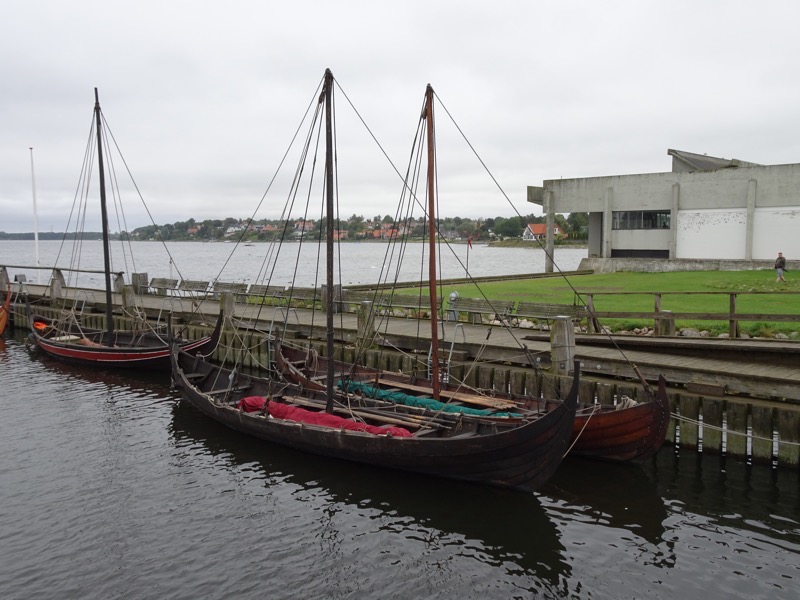 The Viking Ship Museum is an active experimental archaeology research centre, with over thirty years experience in building and sailing, reconstructions of archaeological ship finds. It is a multi-disciplinary working environment with a strong focus on research and education, where experts from many different fields collaborate in several different workshops towards reconstructions.
The Viking Ship Museum is an active experimental archaeology research centre, with over thirty years experience in building and sailing, reconstructions of archaeological ship finds. It is a multi-disciplinary working environment with a strong focus on research and education, where experts from many different fields collaborate in several different workshops towards reconstructions.
ROPE MAKING WORKSHOP
The first, most noticeable, aspect of the rope makers workshop is the smell – it has a distinctively strong woods/organic aroma from the various rope making materials. 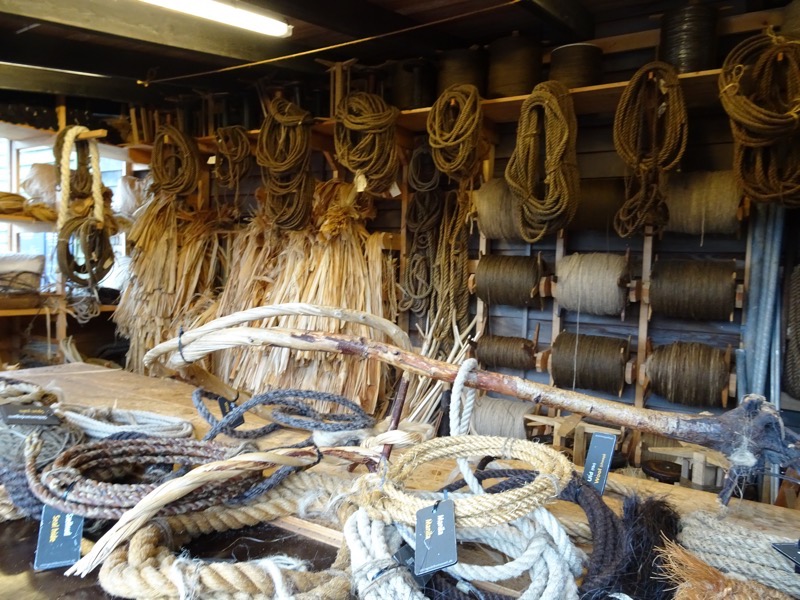 Flax hanging to dry.
Flax hanging to dry.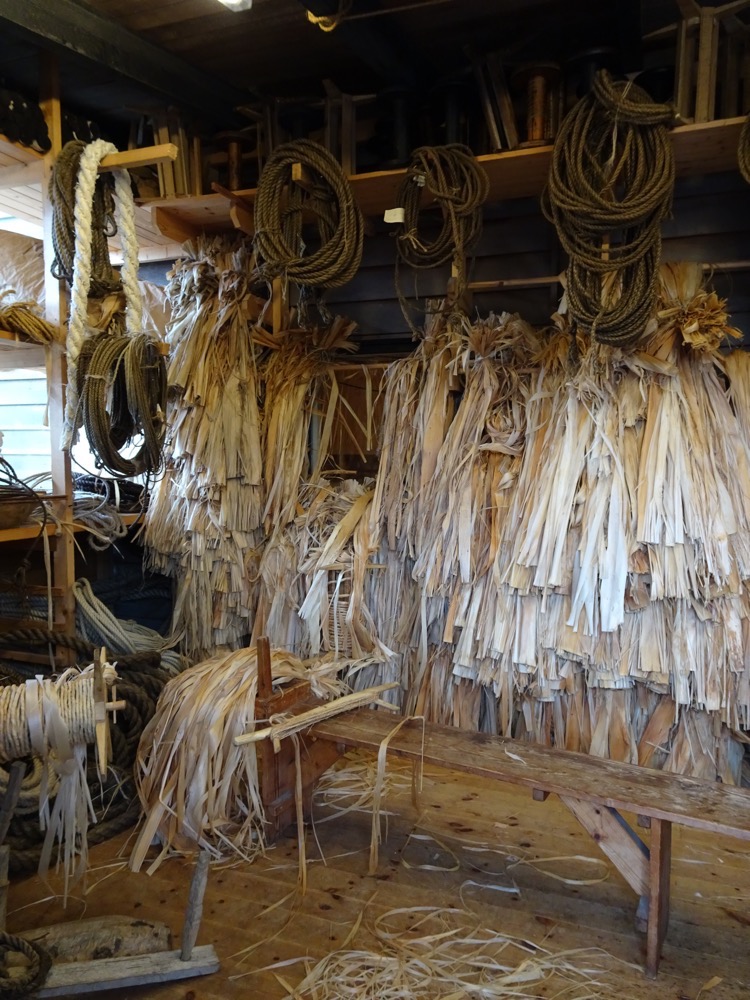 FInished rope lengths that will be used in Viking ship reconstructions.
FInished rope lengths that will be used in Viking ship reconstructions.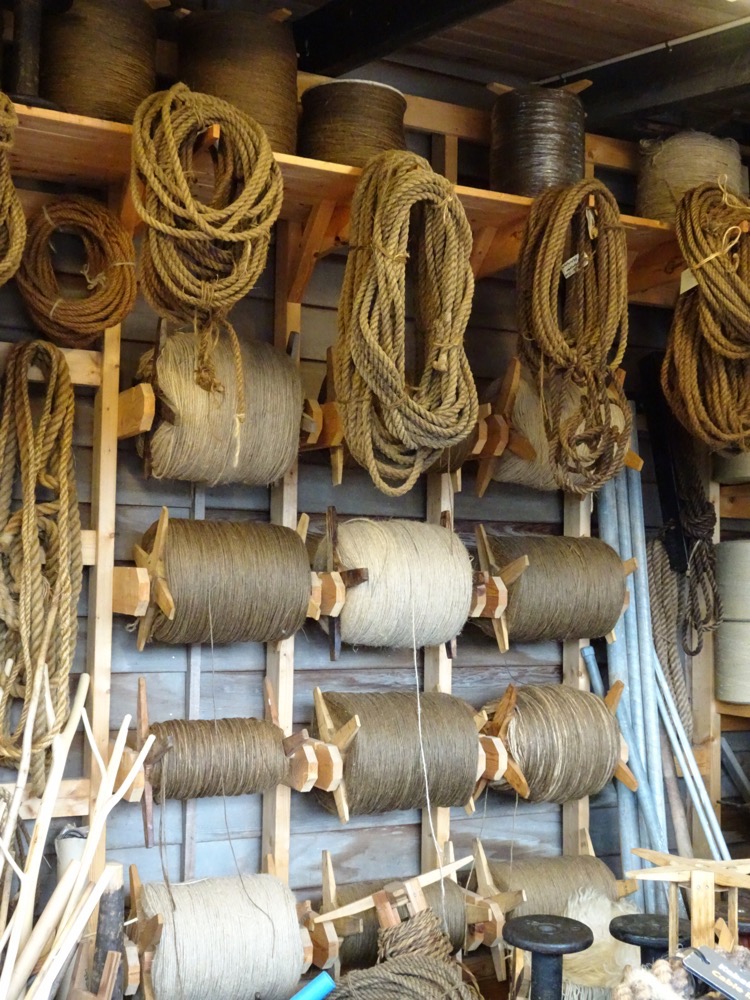
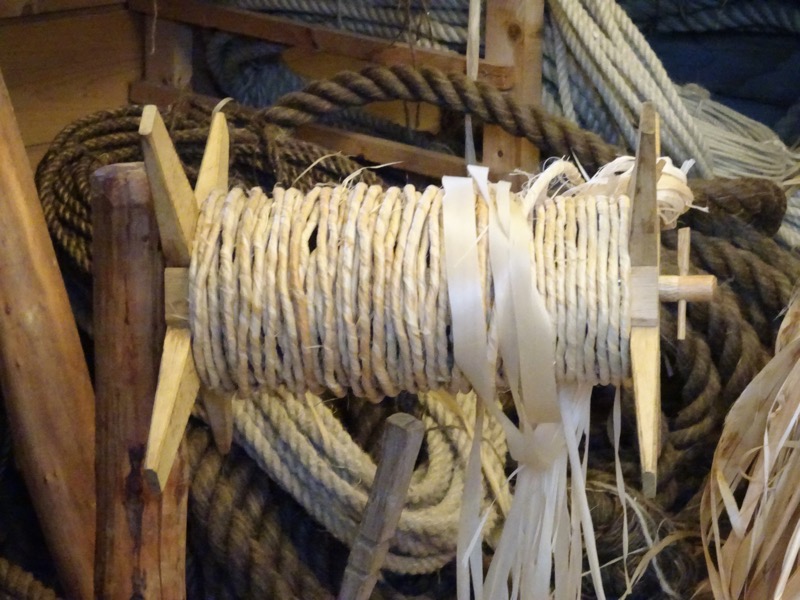 Rope making equipment.
Rope making equipment.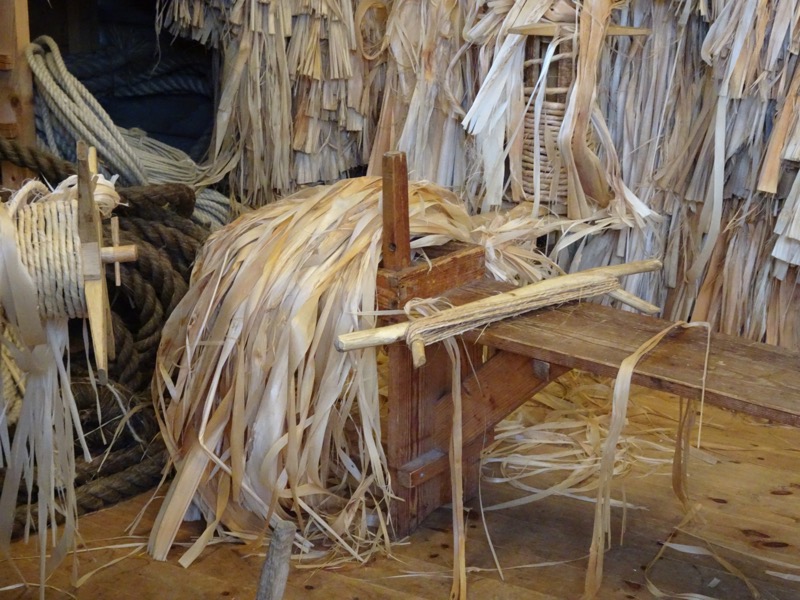 Ropes were made of many differing materials, from bull rushes and flax to elk and seal hides. Most ropes were tarred to retard fungus and bacteria and to protect from weather and deterioration.
Ropes were made of many differing materials, from bull rushes and flax to elk and seal hides. Most ropes were tarred to retard fungus and bacteria and to protect from weather and deterioration.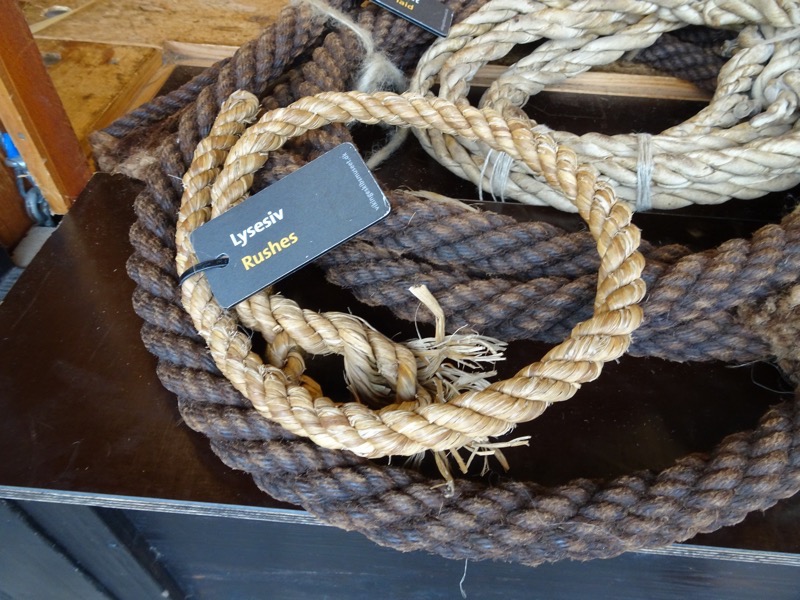
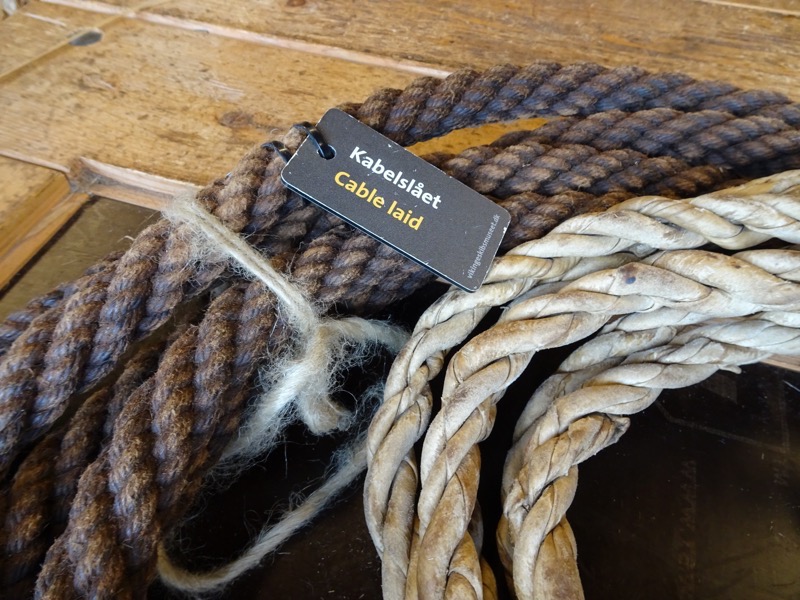 The elk and seal hide ropes had a natural waxy waterproof texture.
The elk and seal hide ropes had a natural waxy waterproof texture.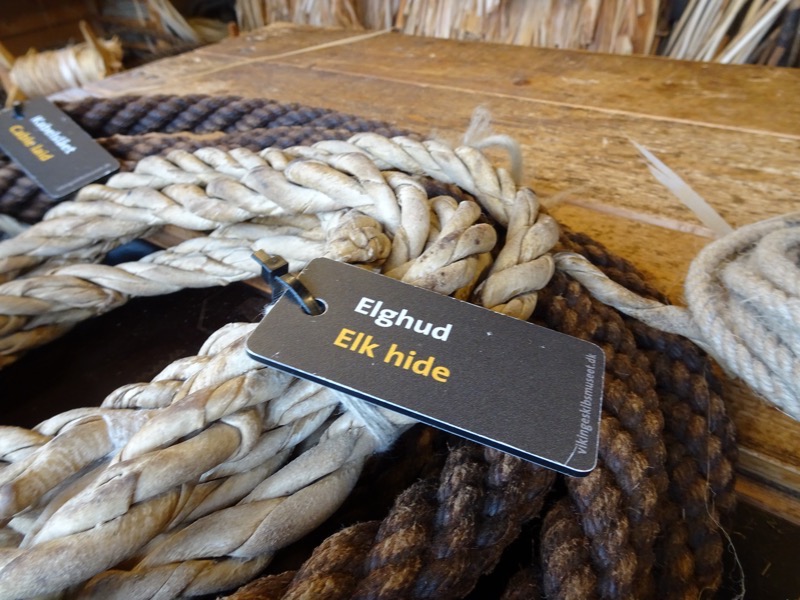
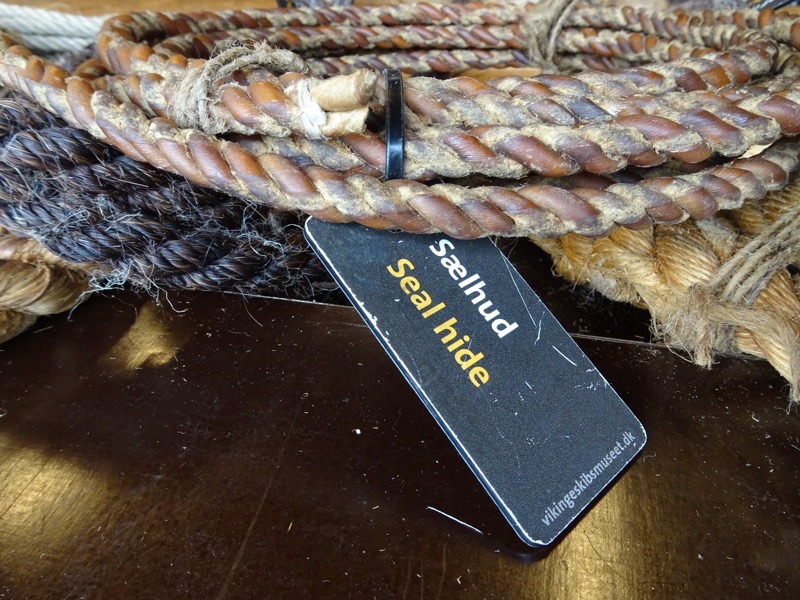
SHIPBUILDING WORKSHOP
A little further into the complex is a ship building workshop where the master ship builders are constantly working on recreating and perfecting another Viking ship.  Clamps to hold timbers during construction.
Clamps to hold timbers during construction.
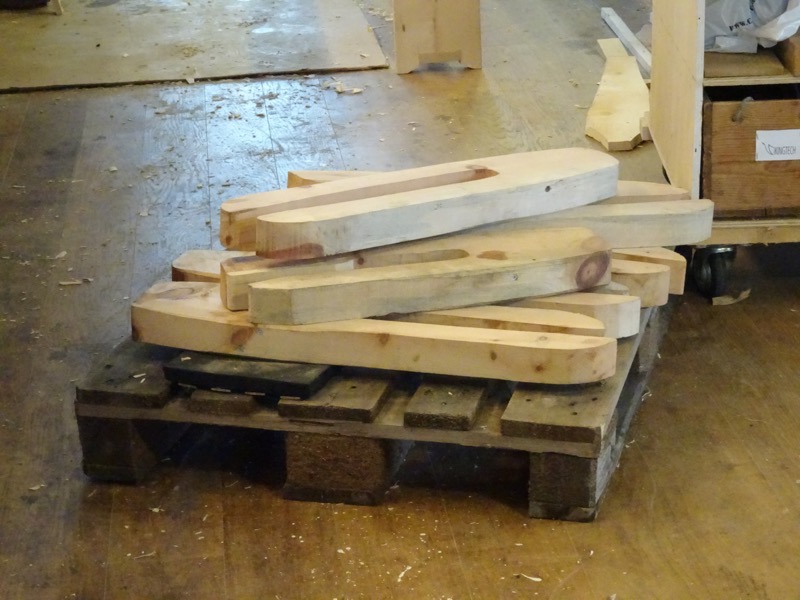
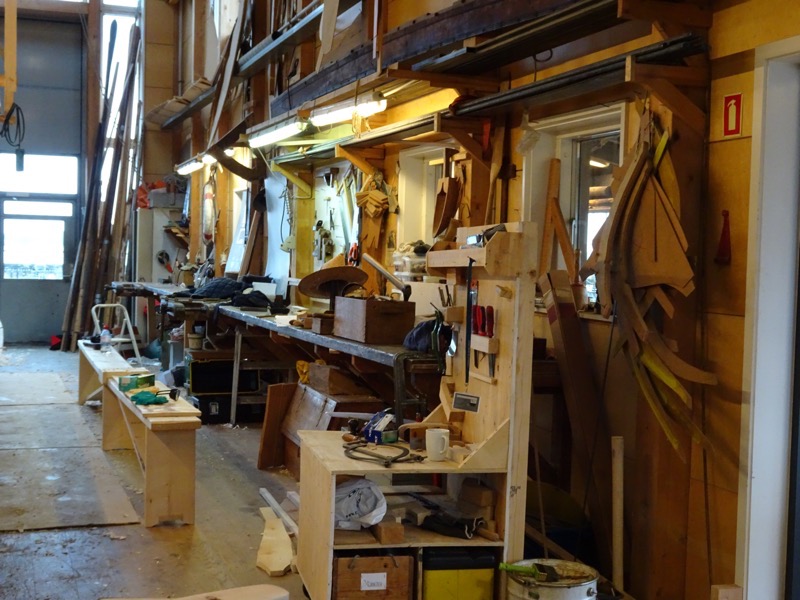
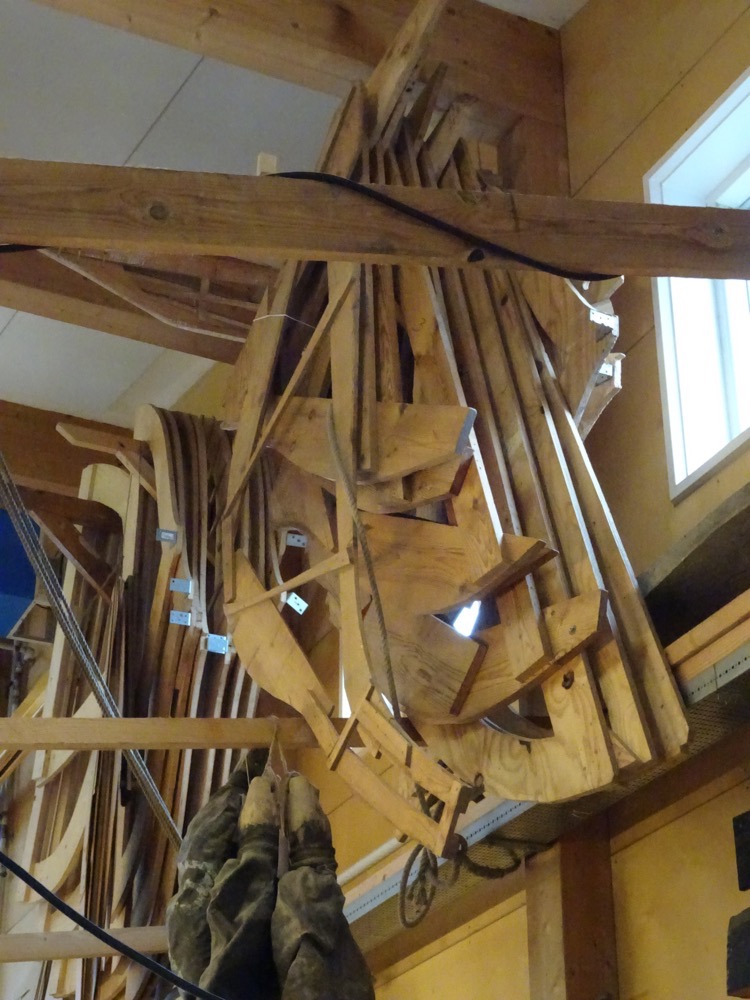 The workshop may look reasonably modern with modern lighting in a modern building, but all the tools used are replicas of period tools that would have been used during the Viking age to build ships.
The workshop may look reasonably modern with modern lighting in a modern building, but all the tools used are replicas of period tools that would have been used during the Viking age to build ships.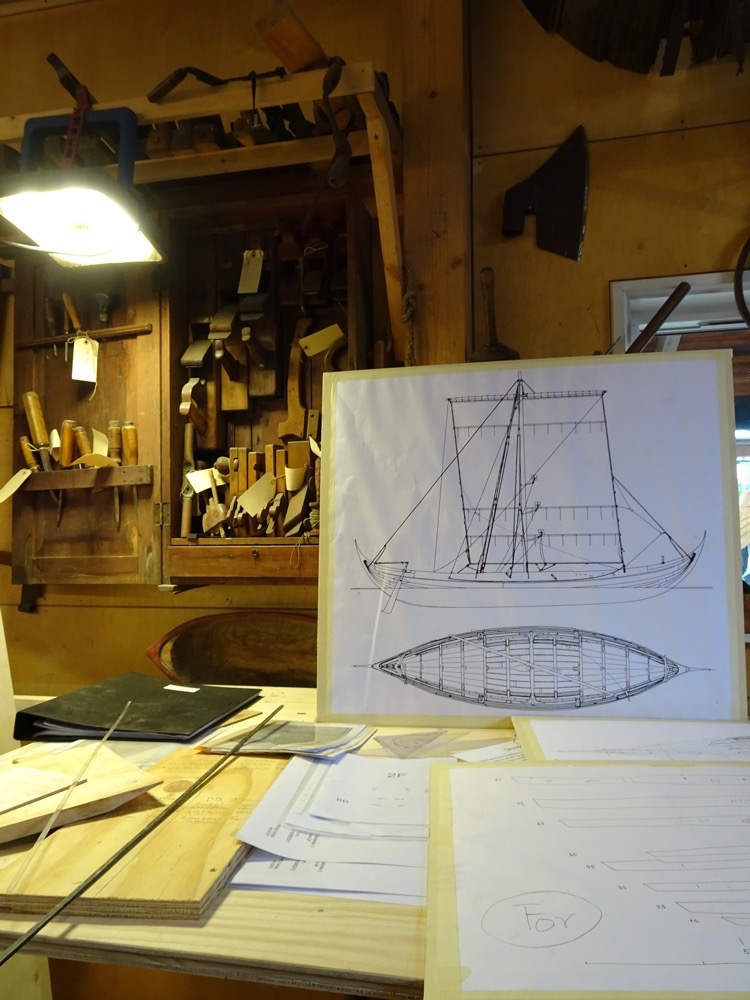
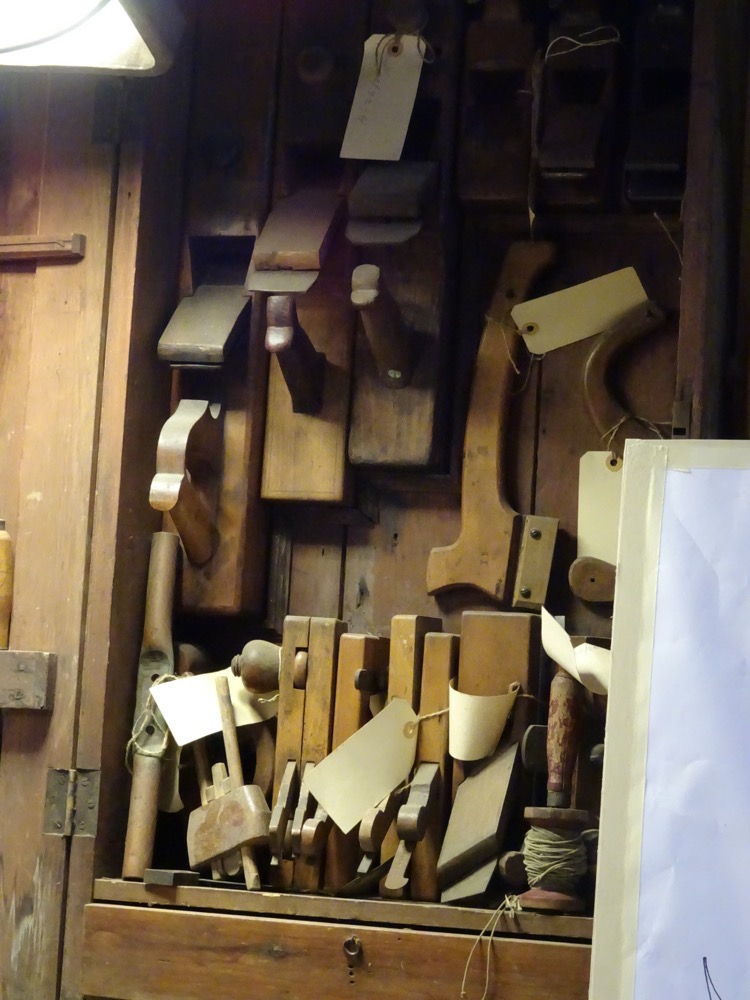
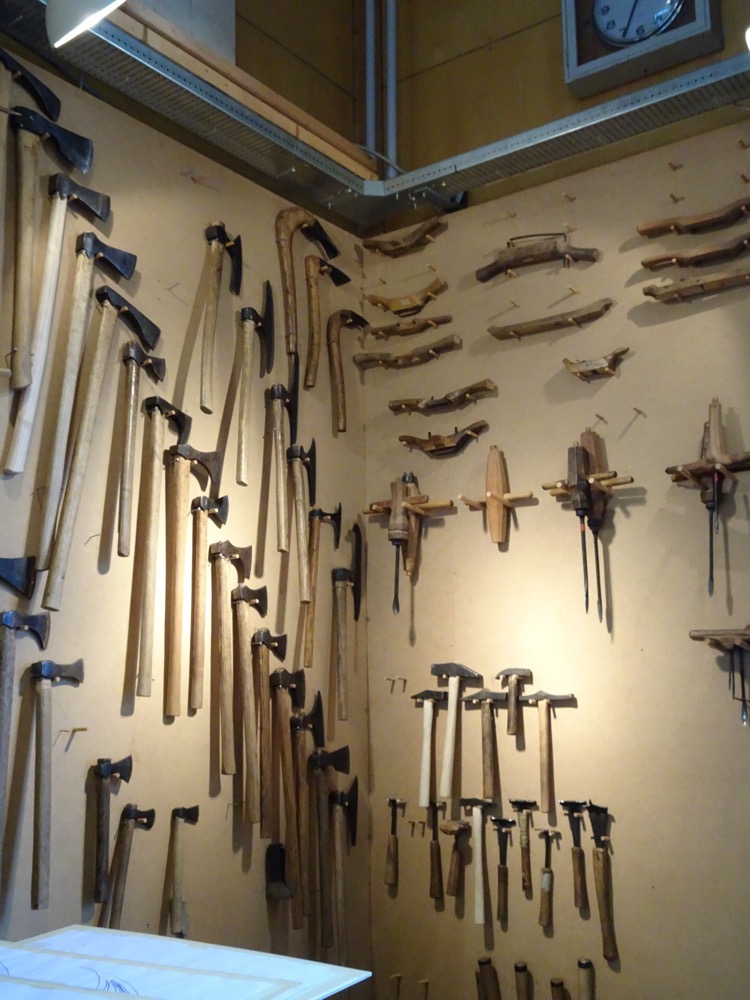
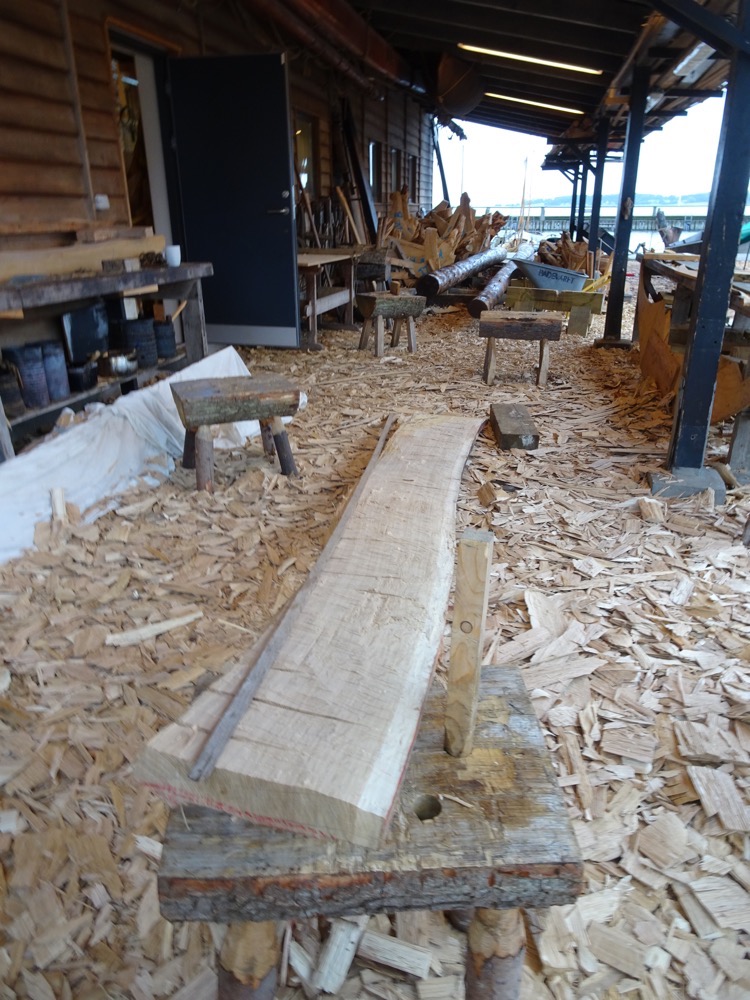
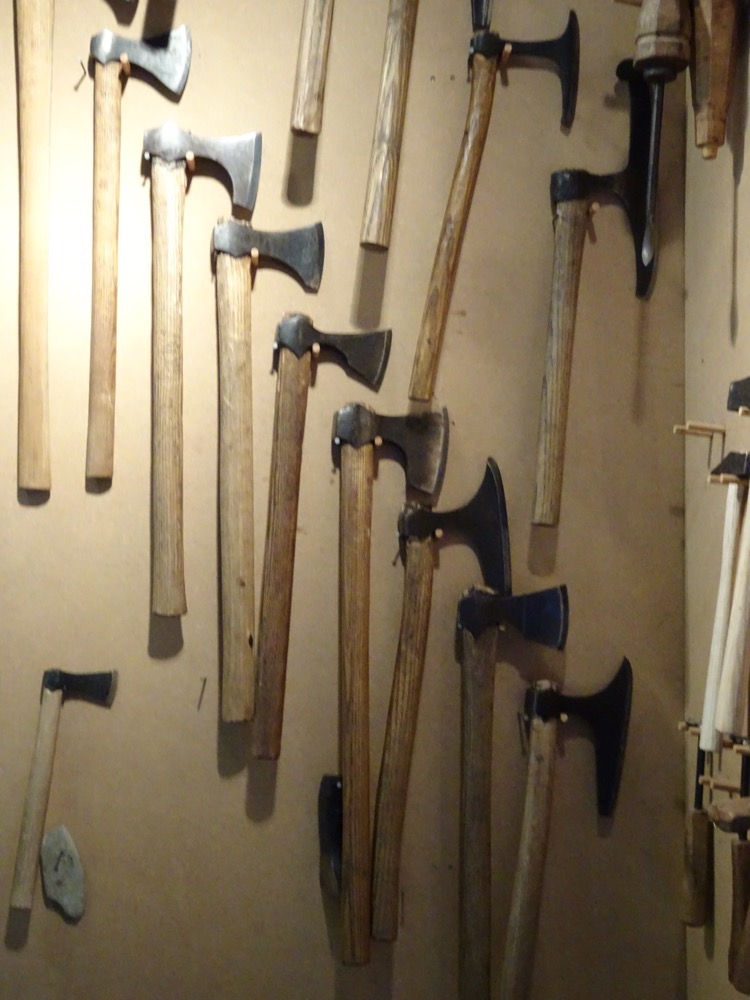
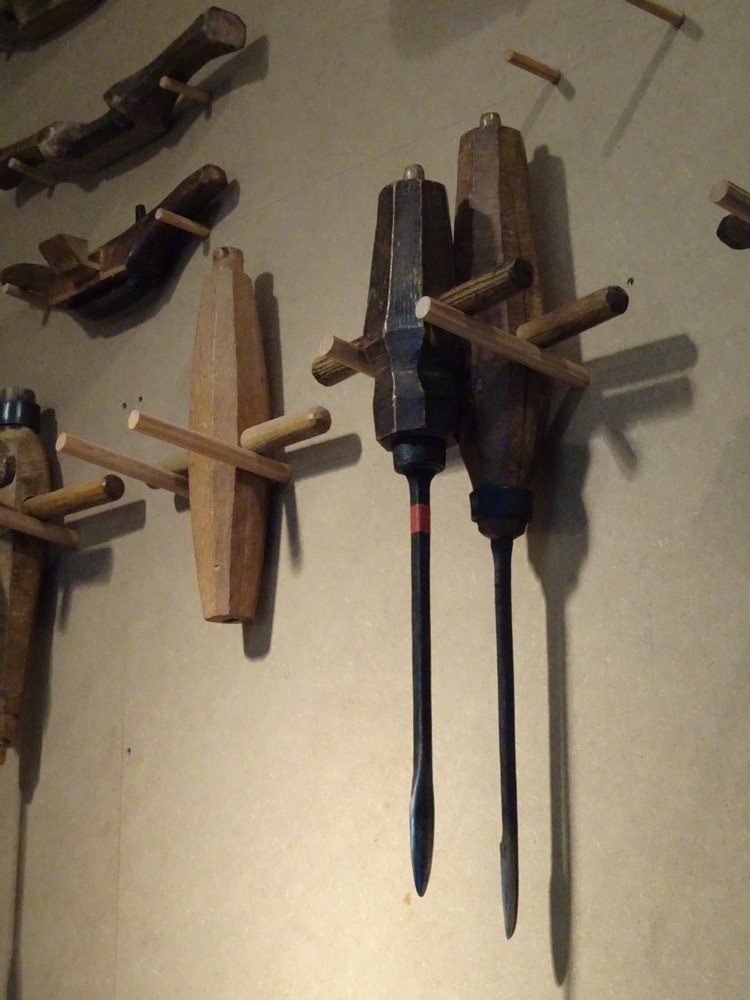
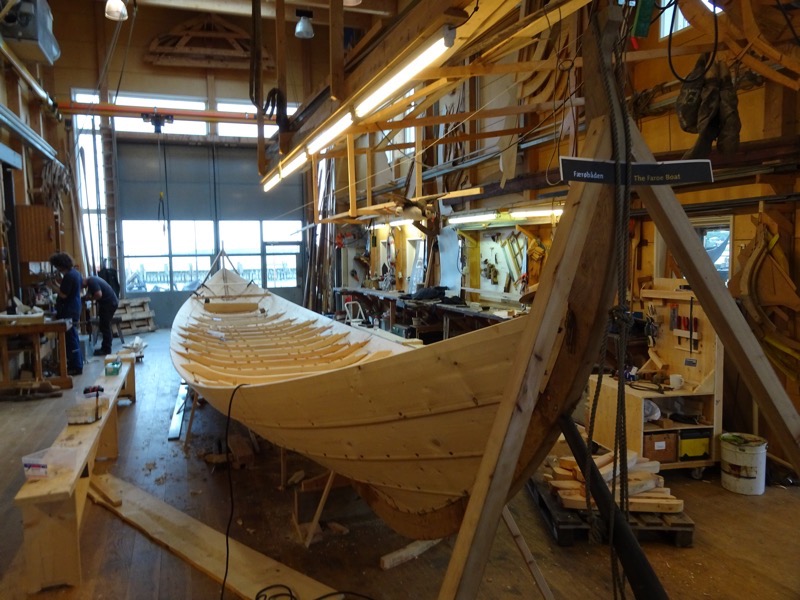 Larger reconstructions are done in the outside part of the shipyard.
Larger reconstructions are done in the outside part of the shipyard. 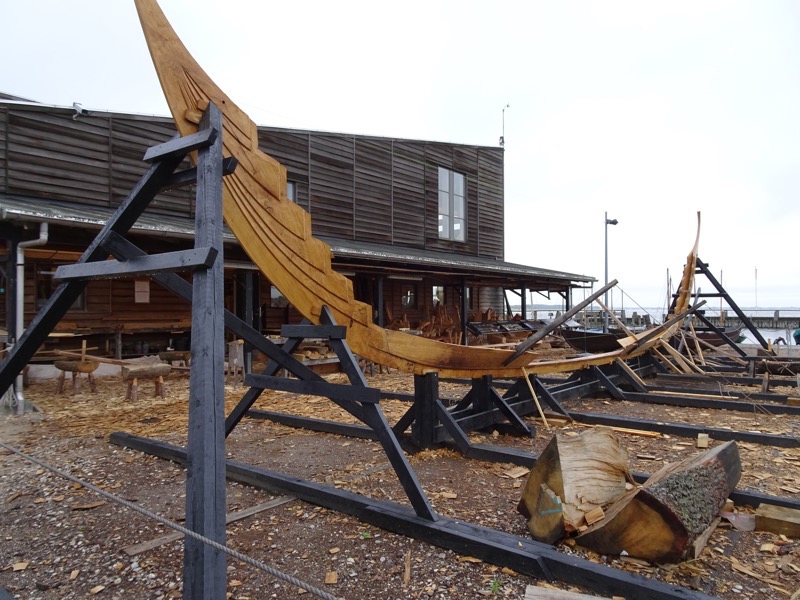
TIMBER YARD
Nearby is a timber yard, where timbers are being dried cut into planks using traditional wedging techniques. Large sections of tree are laying about earmarked for particular use in upcoming reconstruction projects.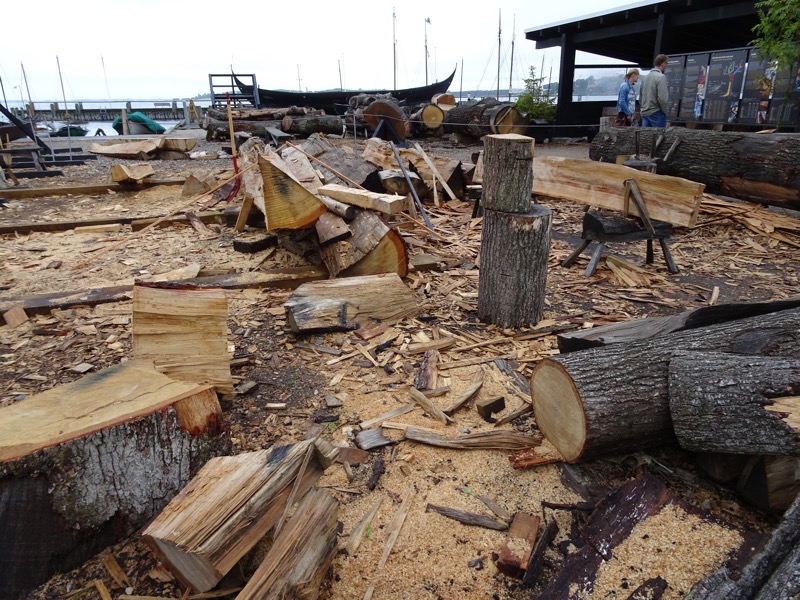
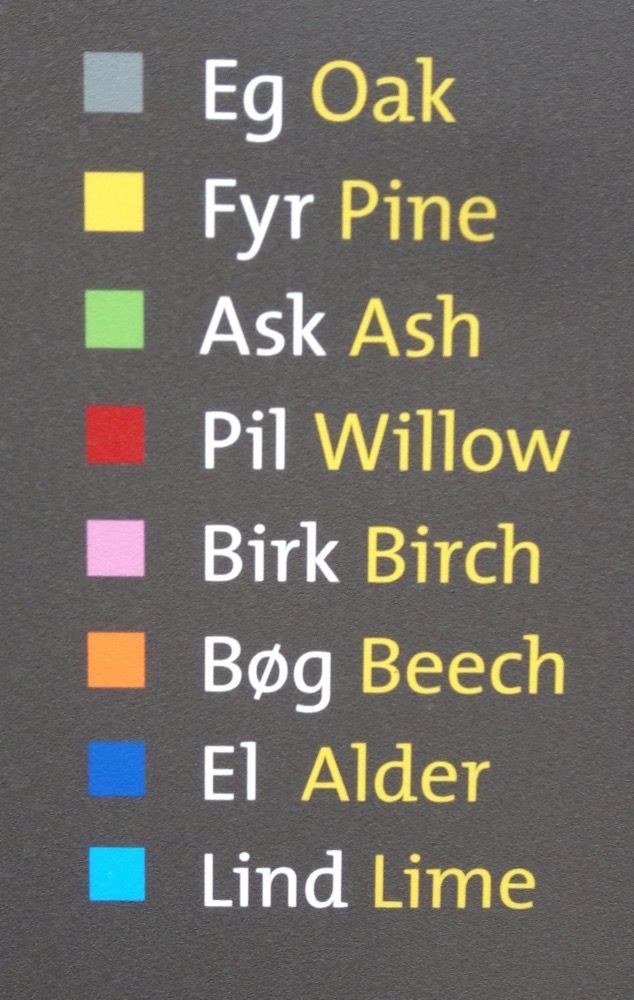
These diagrams demonstration how a single ship was often made using many differing timbers, each chosen for their particular characteristics, whether that is for strength, flexibility, durability or structure.
Different sections of these tree species have varying natural tensile properties, and the traditional Viking shipbuilders utilized these characteristics to good effect – choosing certain timber for certain ship parts, and certain sections from certain trees for their inherent natural properties that were most suitable for those parts.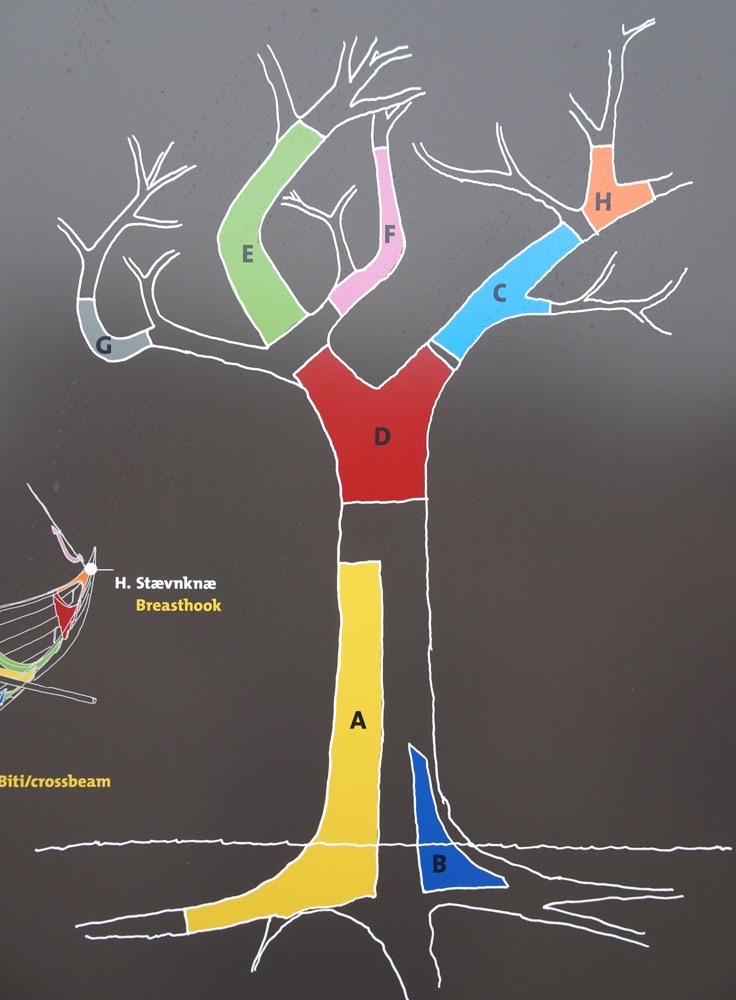
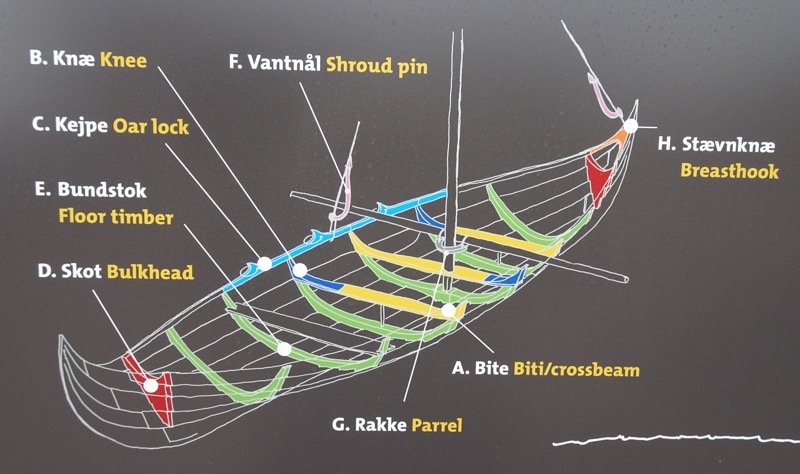
BLACKSMITH WORKSHOP
Next, we saw the blacksmithy. There was not supposed to be anyone working the smithy today, but happily, there was a guy there working the bellows and bashing away at some piece of iron while we were there, with a range of various period items made of iron in his forge.
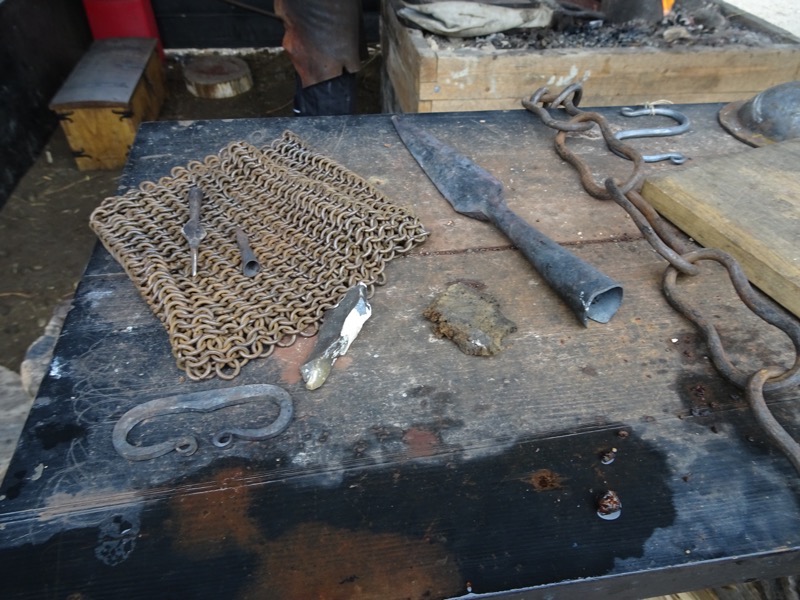
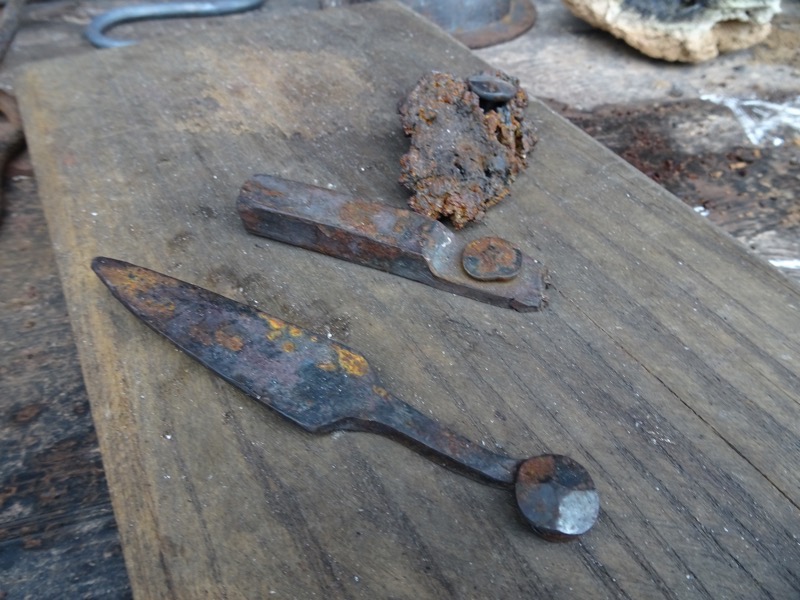 Nails. While it must be boring for the smith to make so many nails, they were integral to the ship building process.
Nails. While it must be boring for the smith to make so many nails, they were integral to the ship building process.
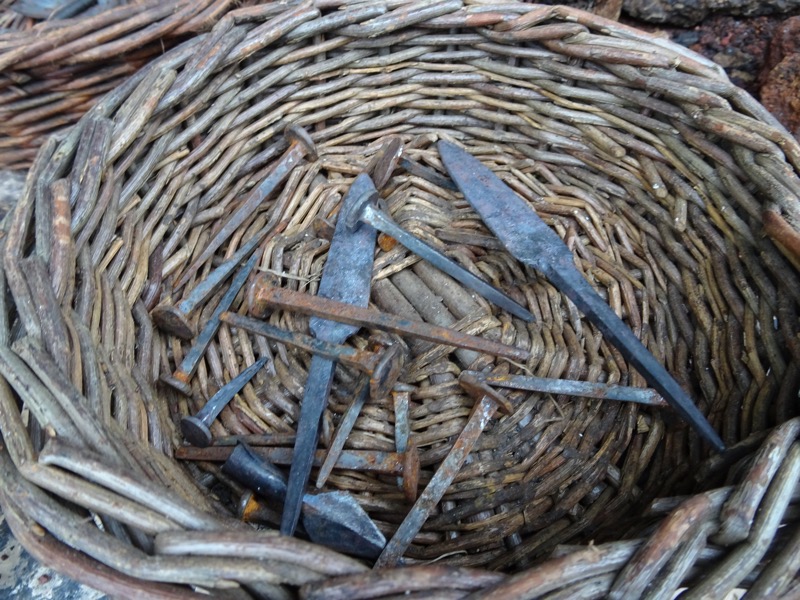
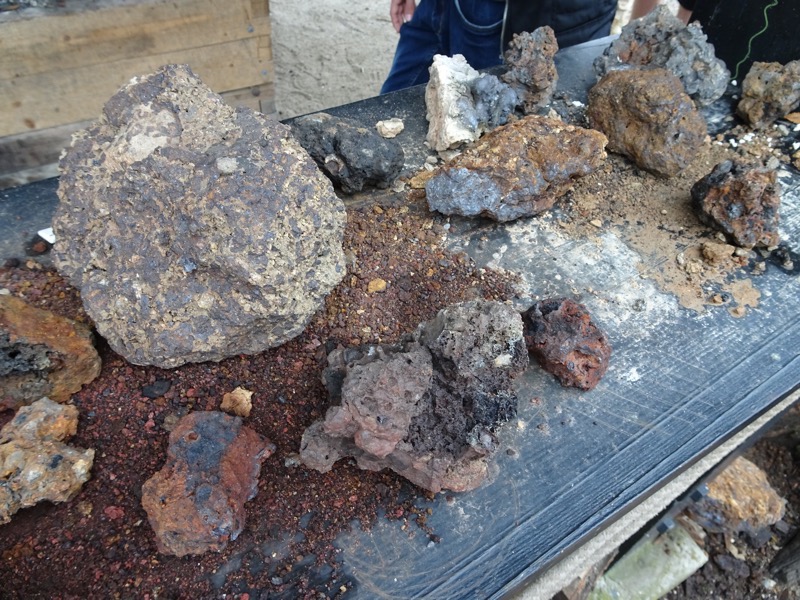
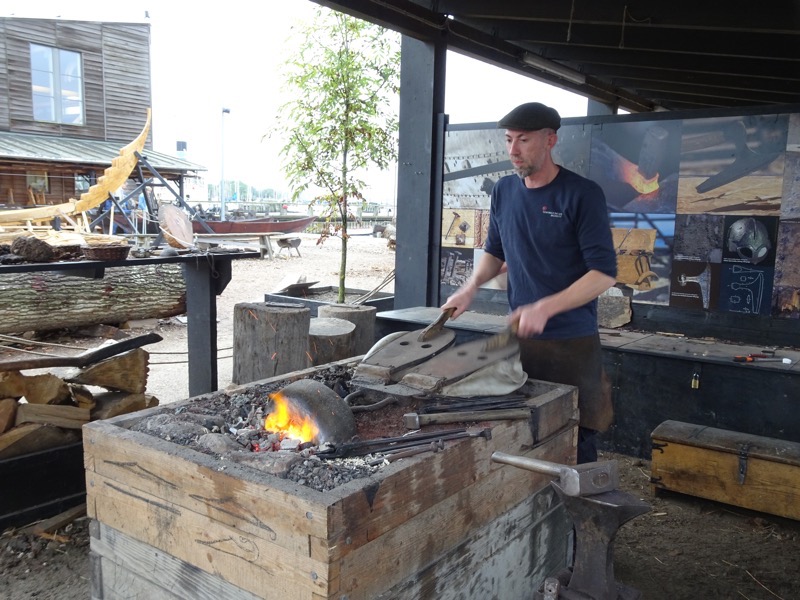
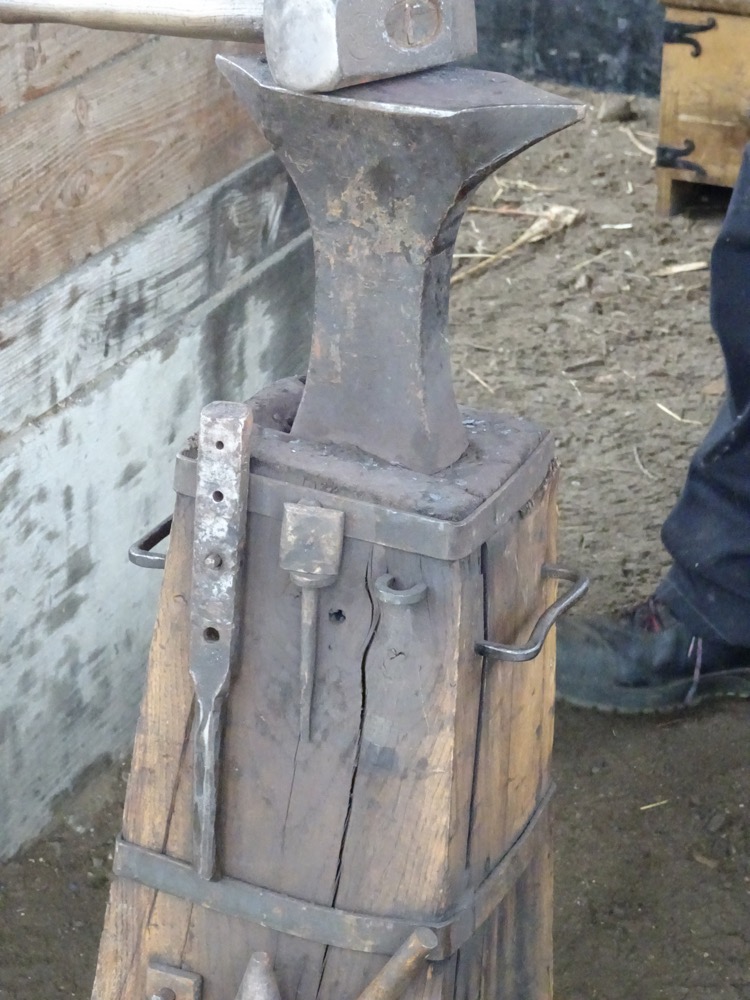
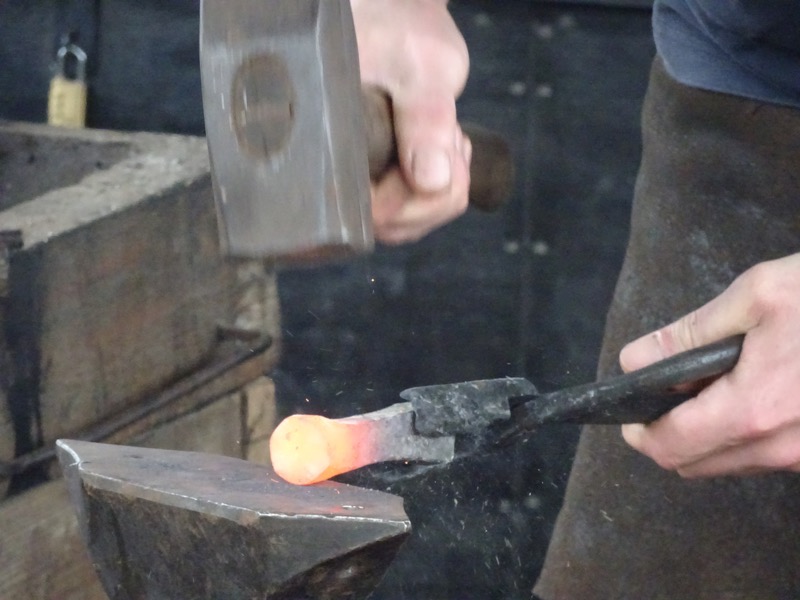
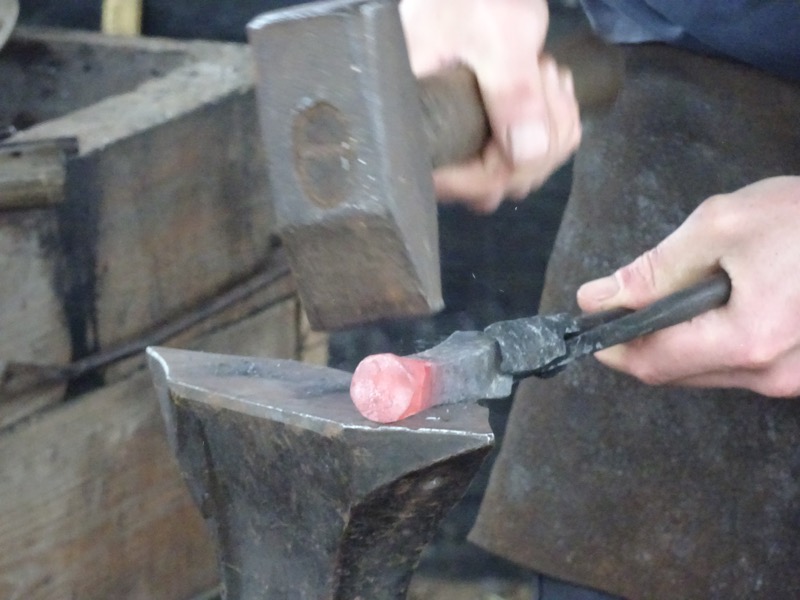
SAILMAKING
Flax has been used to produce textiles in Scandinavia since the Iron Age. Transforming the plant into fiber that can be spun, and then woven, is quite a long and complex process though. Sails on the reproduction ships have so far been made of linen and wool, which archeological evidence also demonstrates were used for sailmaking, but no flax sails have been made at the Roskilde shipyard yet. Sails are created of up to five long panels which are sewn together and then impregnated with fats, oils, tar or pitch to help prevent rot and to make them more windproof.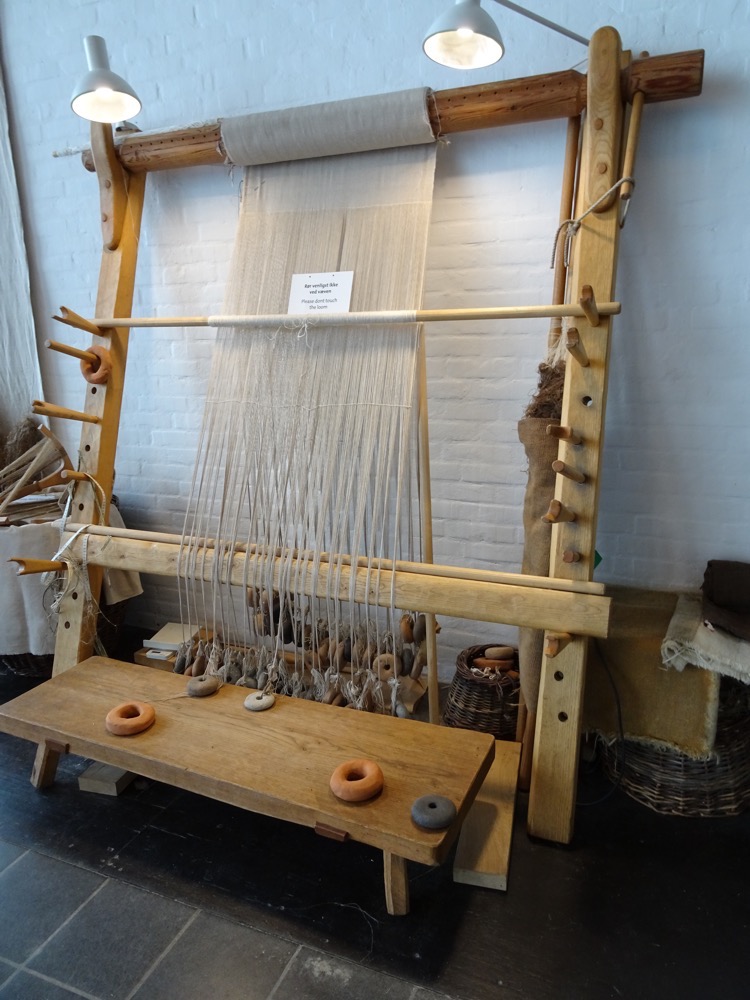
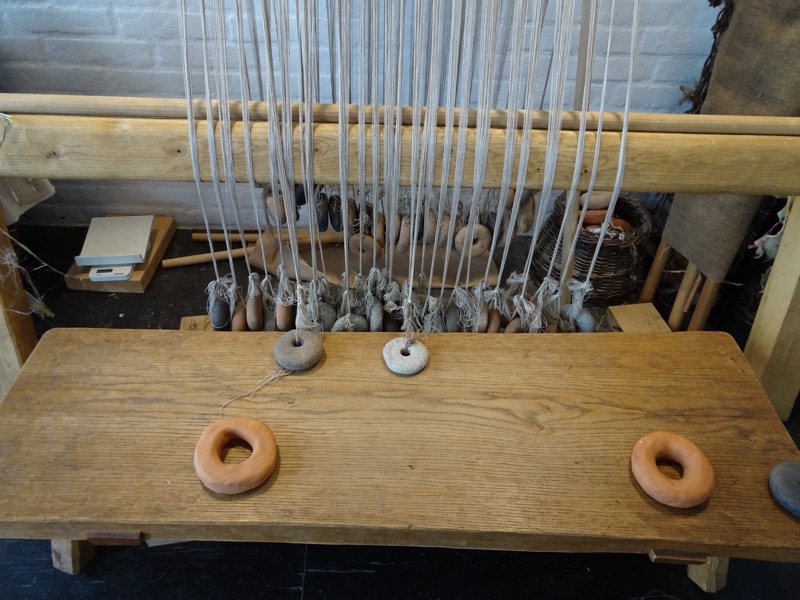
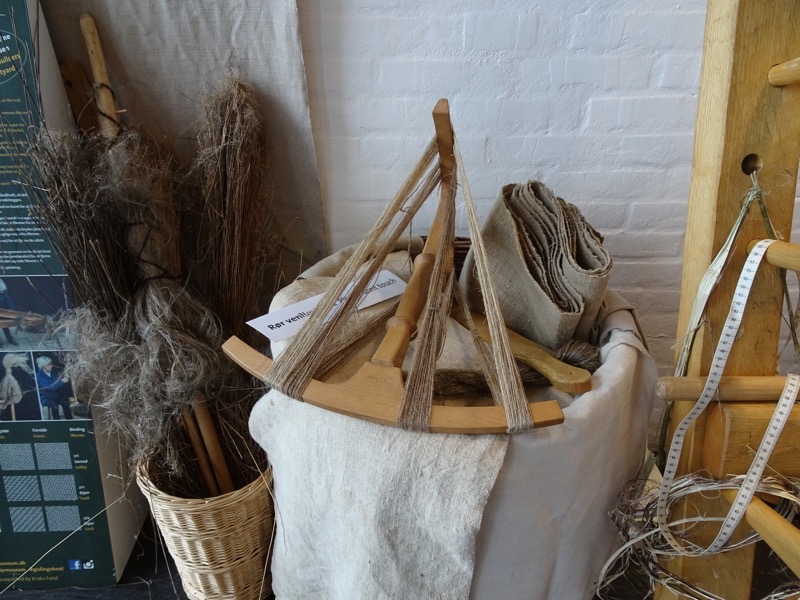
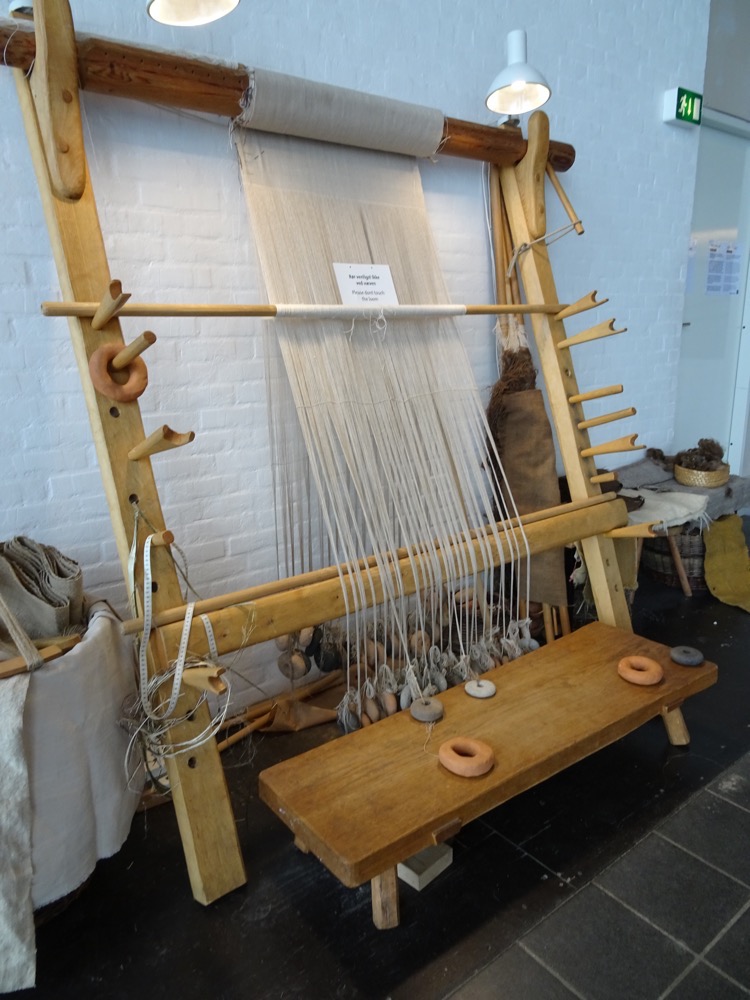
The Sea Stallion of Glendalough is the largest reconstruction ship made at the shipyard to date. In the summer of 2007 and 2008, the Sea Stallion from Glendalough sailed from Roskilde to Dublin and back. The Sea Stallion is a reconstruction of the 30 meter long warship, Skuldelev 2, which was originally built in Ireland in 1042 and which is on display in the Viking Ship Museum hall. It traversed the North Sea, the Irish Sea, and the English Channel. During the voyage, the ship passed through the very same landscapes which were part of Viking history 1000 years ago. (Photos by Werner Karrasch – photographer at the Viking Ship Museum).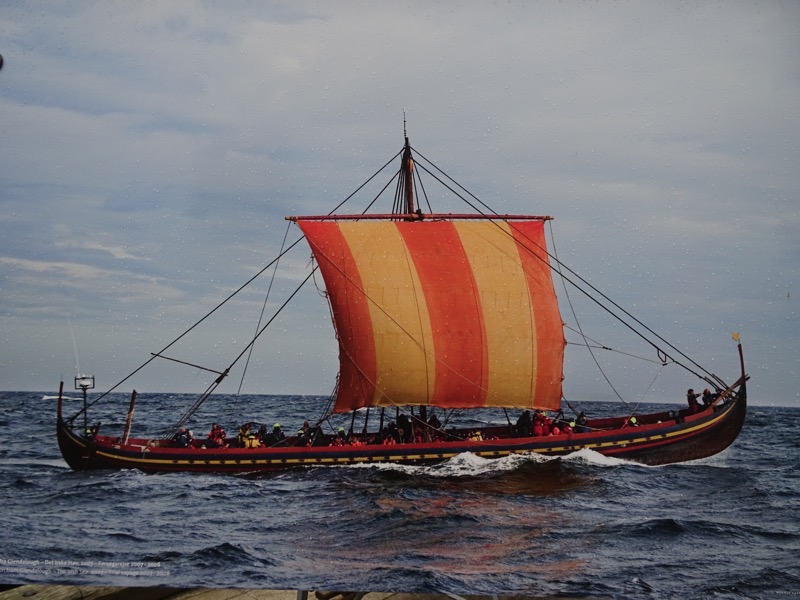
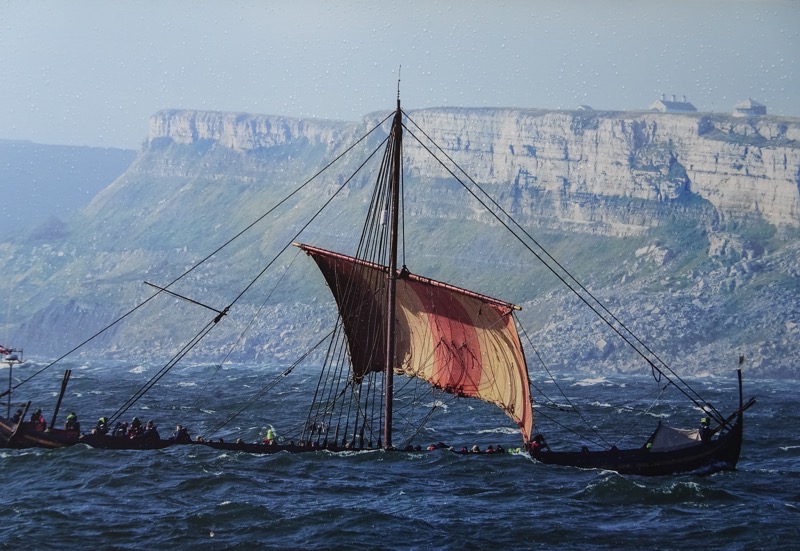
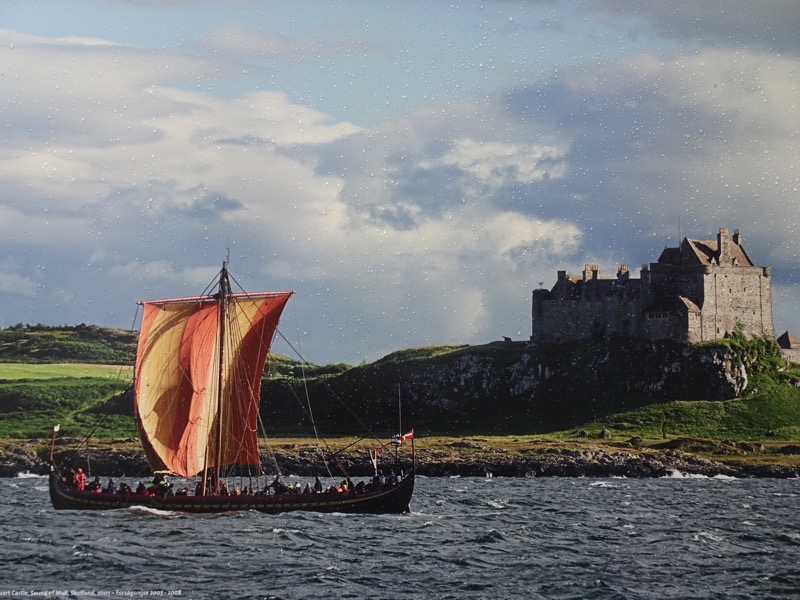 The summer 2007-2008 voyage:
The summer 2007-2008 voyage: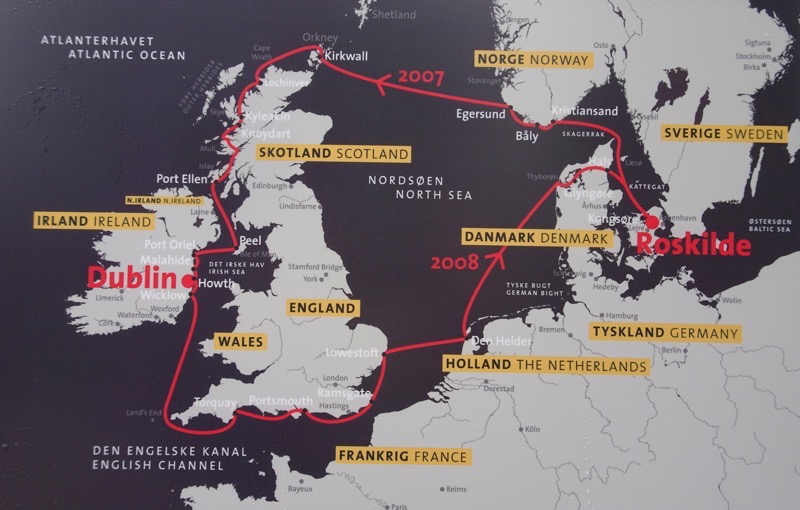
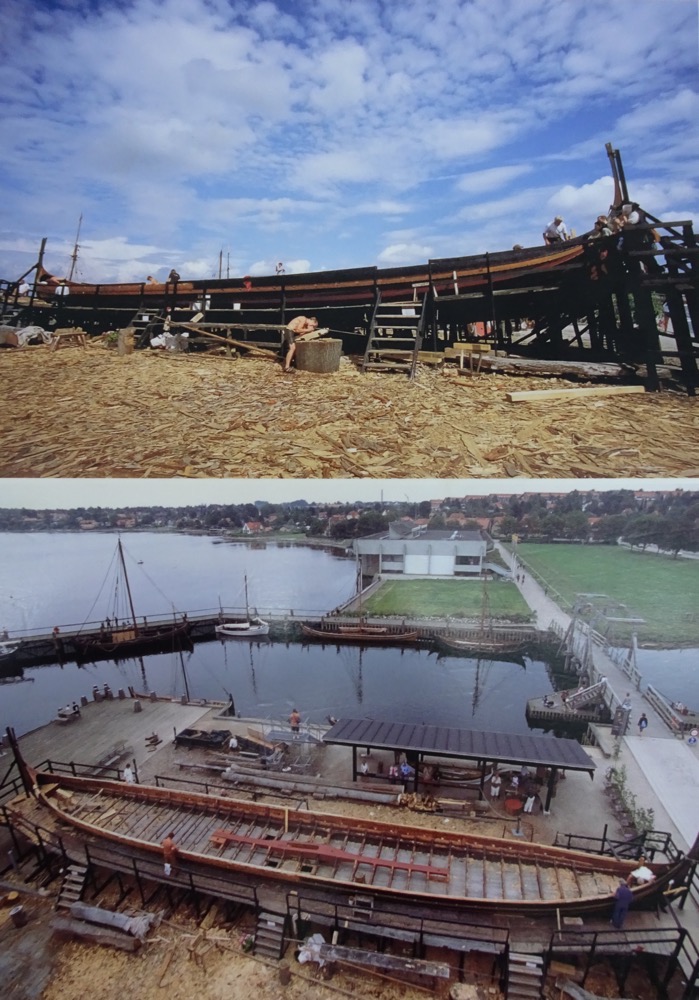 The Sea Stallion today.
The Sea Stallion today.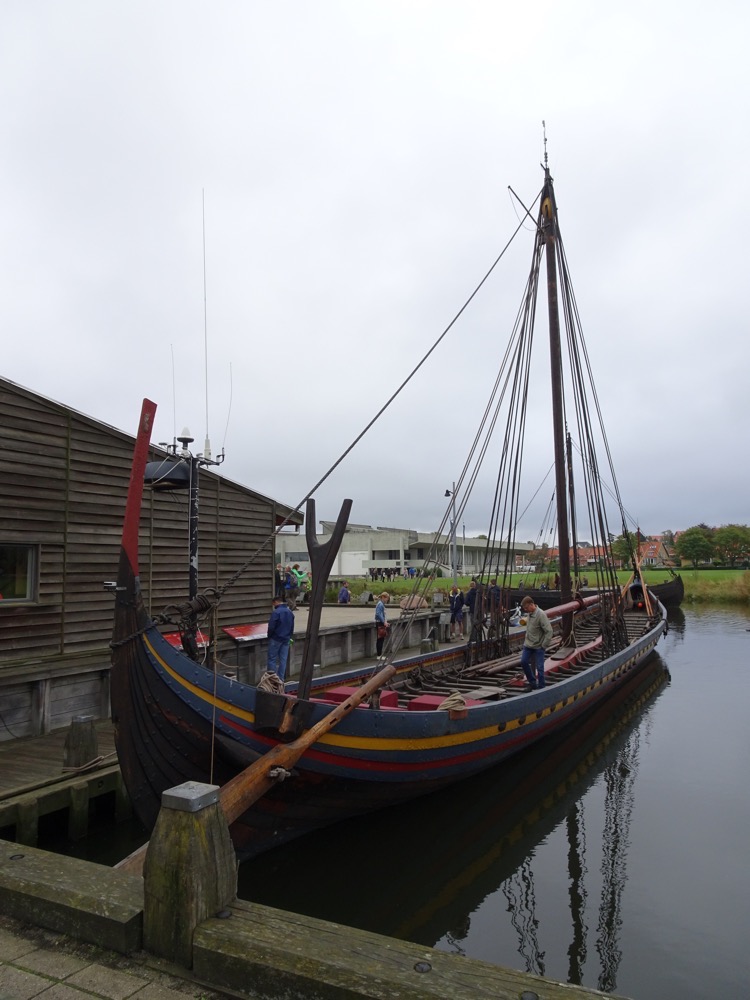
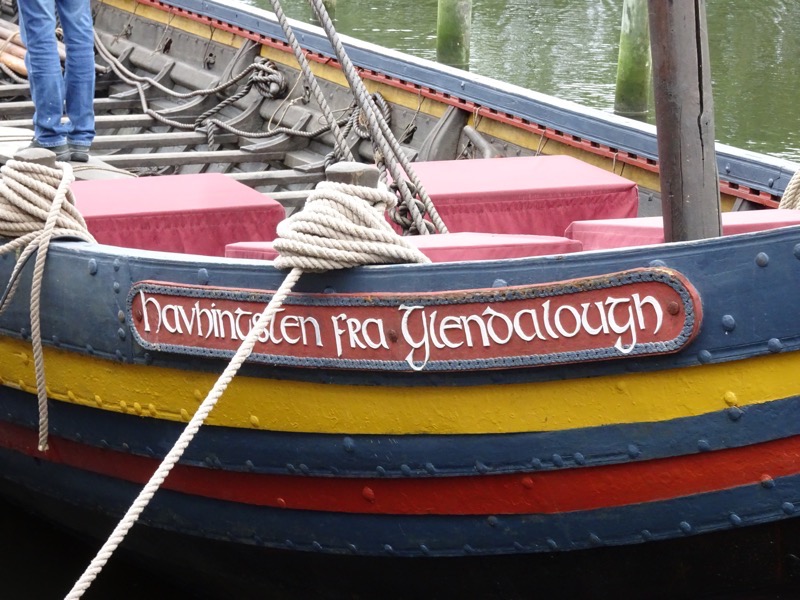
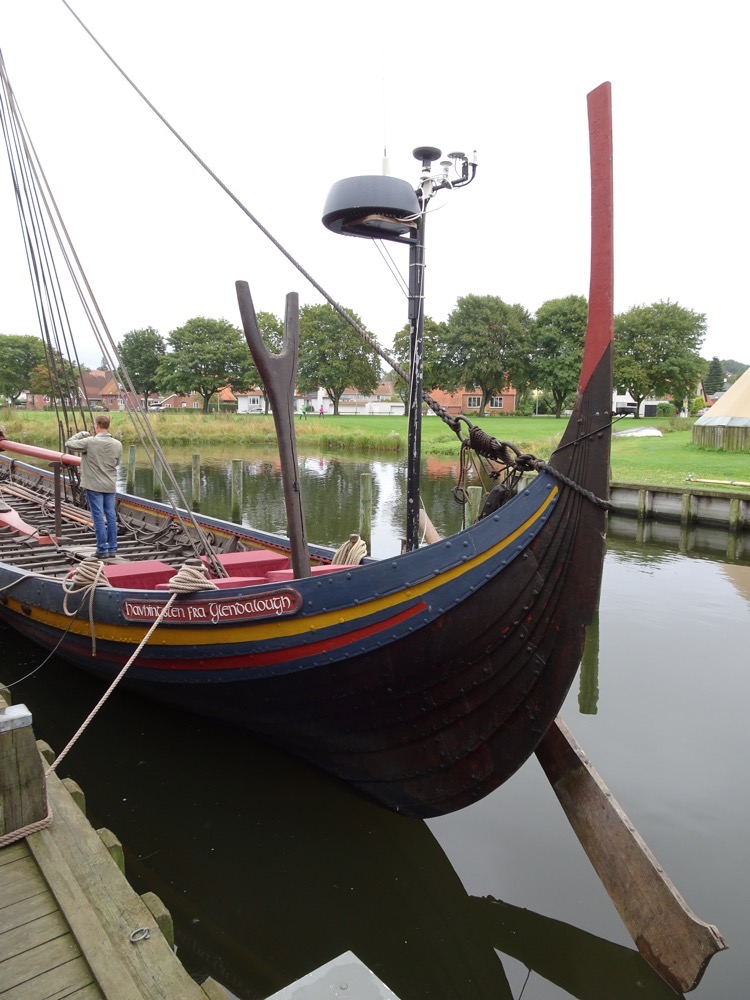
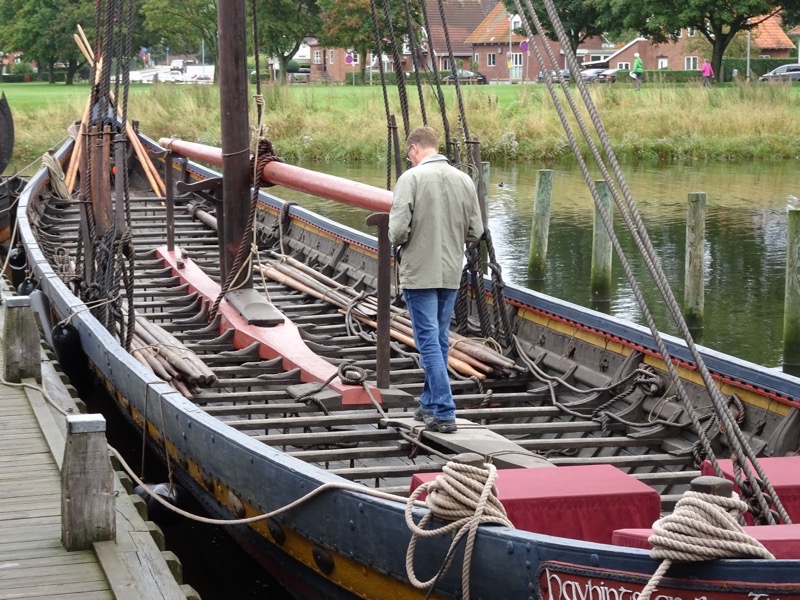
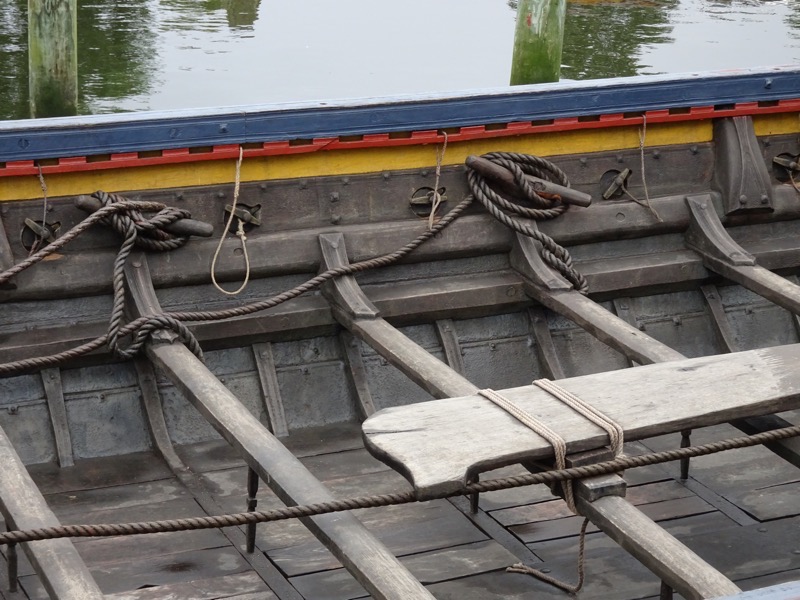
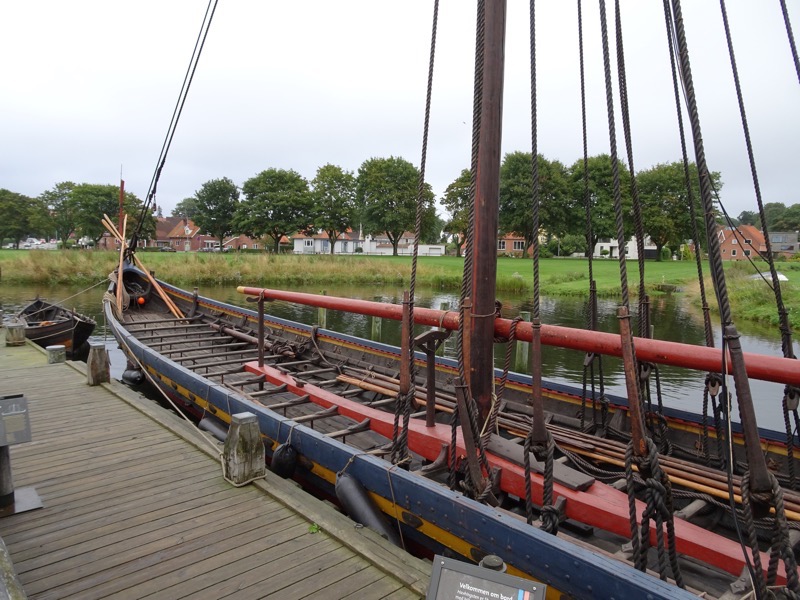
There are plenty of other replica ships about based on the other Skuldelev ships that are in the museum.
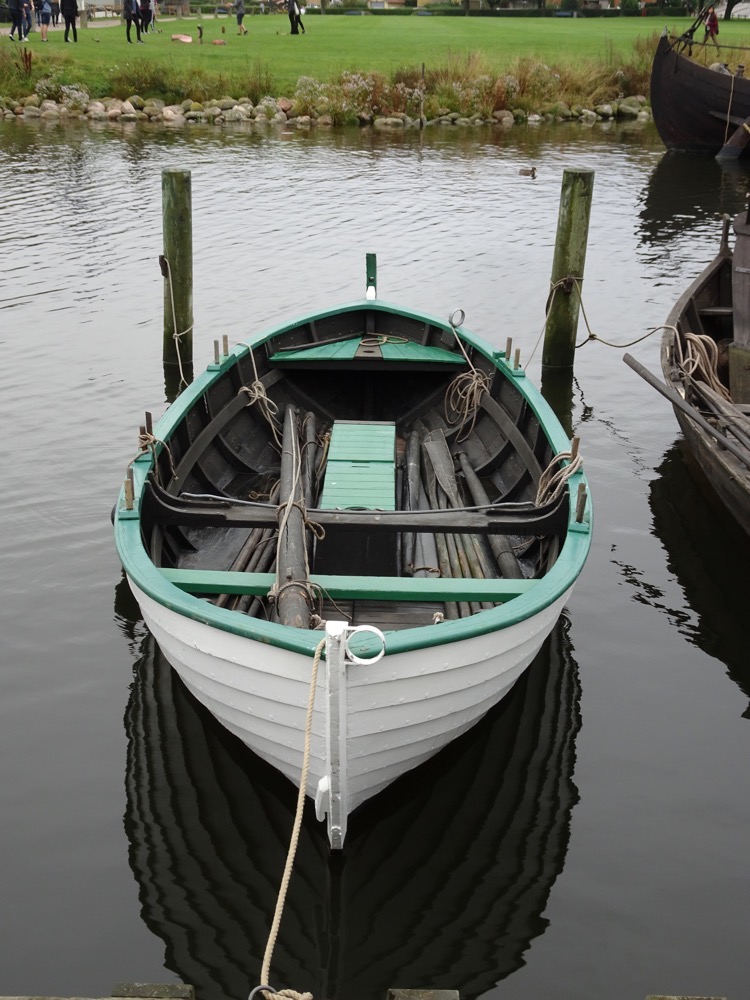 Replica of a 3-sail smack
Replica of a 3-sail smack
This replica was built by Tom Nicolajsen and his students in 1995 as a practice vessel for the students. The original smack was built of pin on oak in Assens for fishing in the southern Little Belt for eel, and cod and sometimes porpoises. The smack is rigged with tow or three spritsails on removalbe masts and is typical of south and west Funen.
Oars: 4
Length: 6.3m Breadth: 2.2m Draught: 0.8m
Total sail area: 25 sq m
Crew: 2 men
Max speed: at sail 6 knots, at oars, 3 knots.
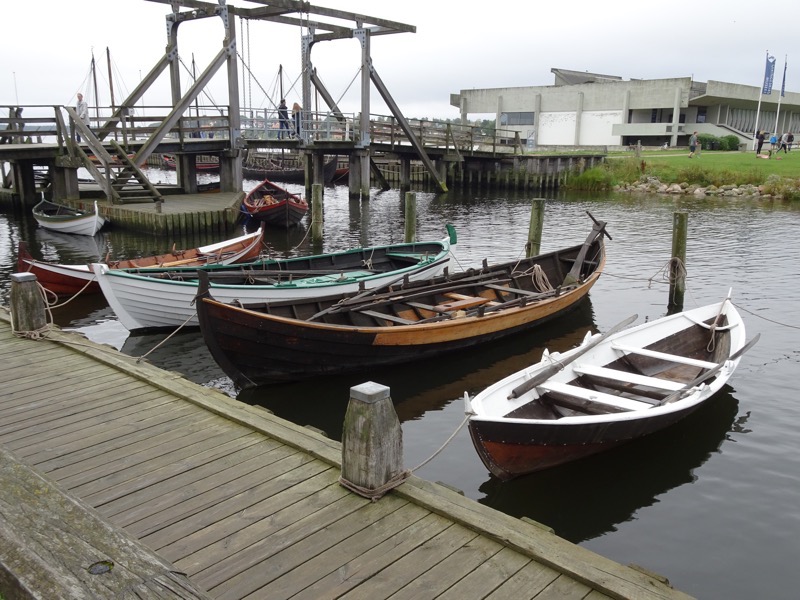 Attamannafar from the Faroe Islands (centre in the picture)
Attamannafar from the Faroe Islands (centre in the picture)
Built by Niclas i Koltri of pine construction. The turbulent and unforeseeable weather and strong currents between the islands required especially seaworthy boats that were also light enough to be hauled up onto the beach as required. The Attammanafar carries a lug mainsail and a small mizzen mast, both of which are easy to rig down and store in the bottom of the boat. The oars are the main source of propulsion in all kinds of weather.
Oars: 8
Length 7.8m Breadth 1.9m Draught: 0.3m
Sail area: 10sqm
Crew: 9 men
Max speed: sail 6 knots, oars: 5 knots. (pictured centre)
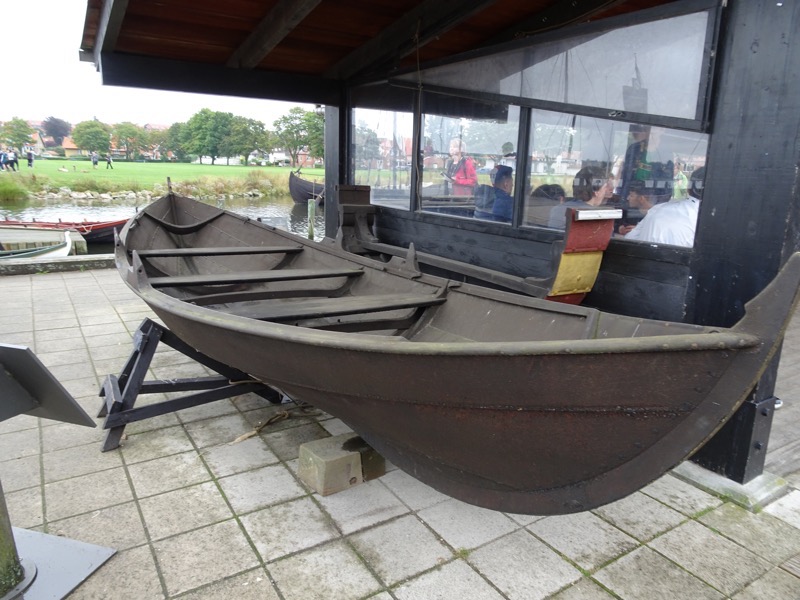
Oselver Faering, Norway, 1970.
Built of pine by Einar Killveit, at Hardanger in Norway. The very broad planking, only three strakes in each side, distinguishes this type of boat. Thanks to its particularly good rowing characteristics, it was used for traveling along the Norwegian skerries. It was also used as a ‘trader’ for transporting light cargo of farm produce and made an ideal fishing boat.
Oars: 4
Length: 5.5m Breadth: 1.55m Draught: 0.2m
Crew: 2-3 men
Max speed: 5 knots.
There are many other replica boats around also, most of which are based on the Skuldelev finds in the museum proper.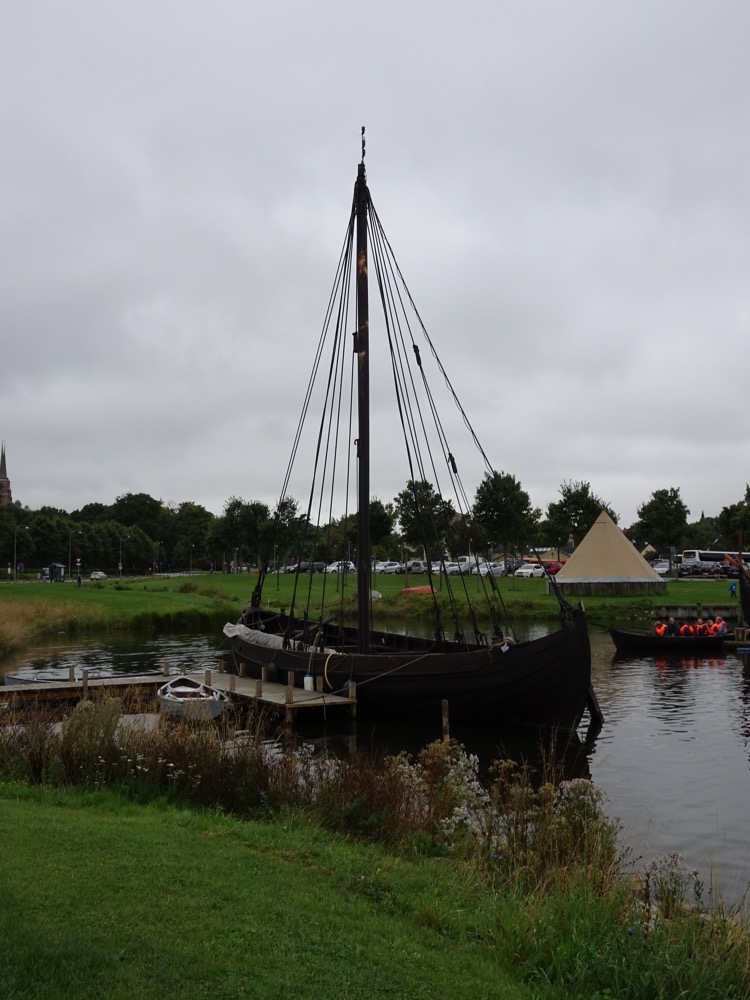
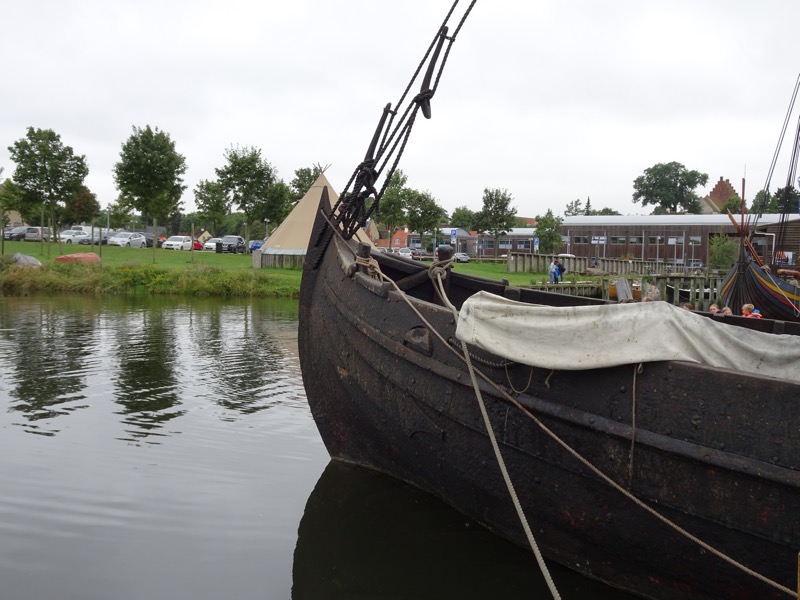
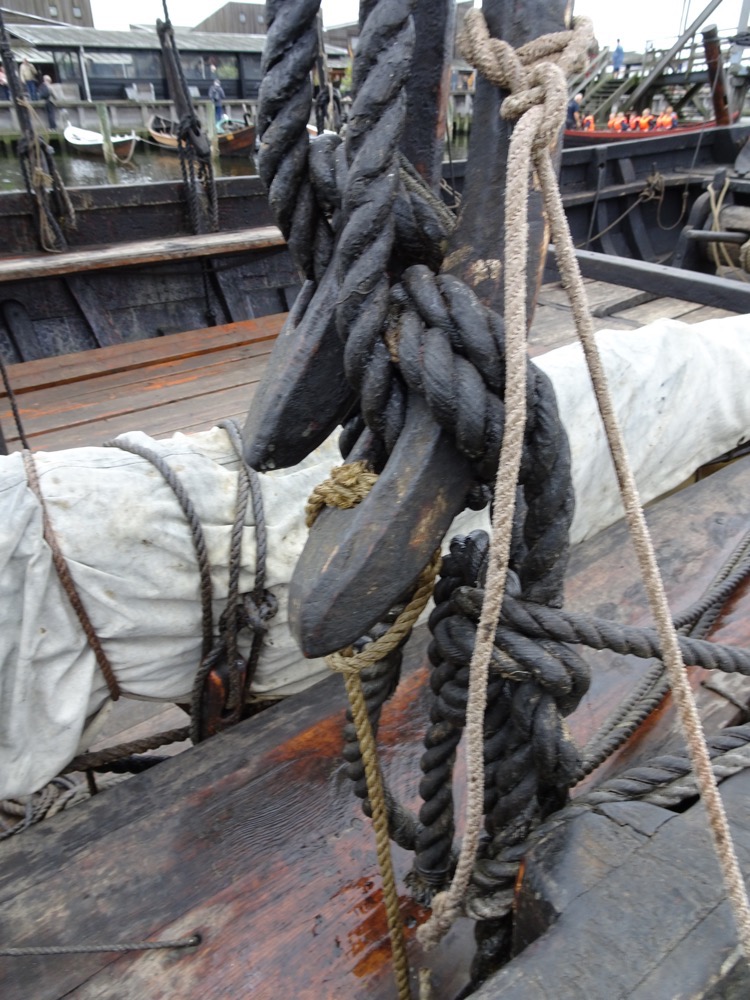
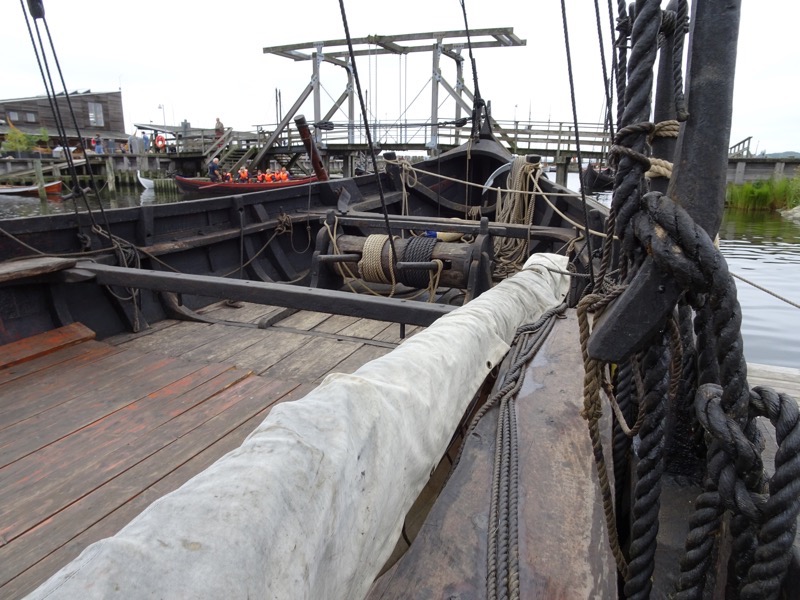
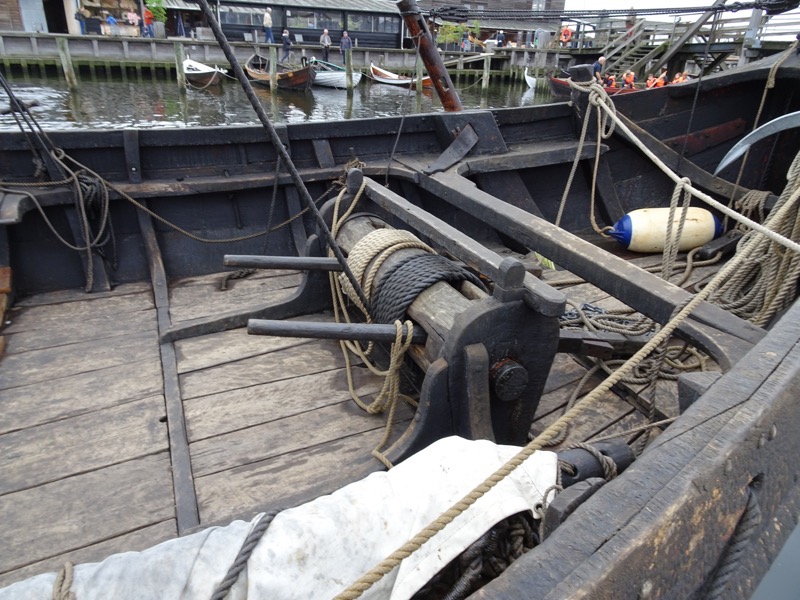
On the lawn outside the Viking Ship Museum is a recreation of a 9th century labyrinth that was found close to the ruins of the monastic settlement of Glendalough in Ireland. The site of Glendalough was an important place of pilgrimage for more than 1500 years. The labyrinth and the movement through its paths are often used as a form of meditation – it is apparently considered very bad luck to step through and cheat your way out!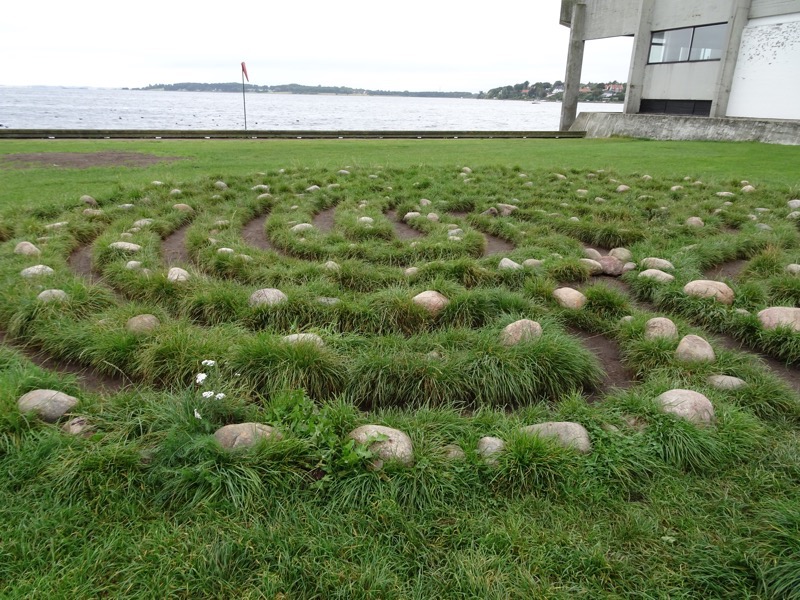
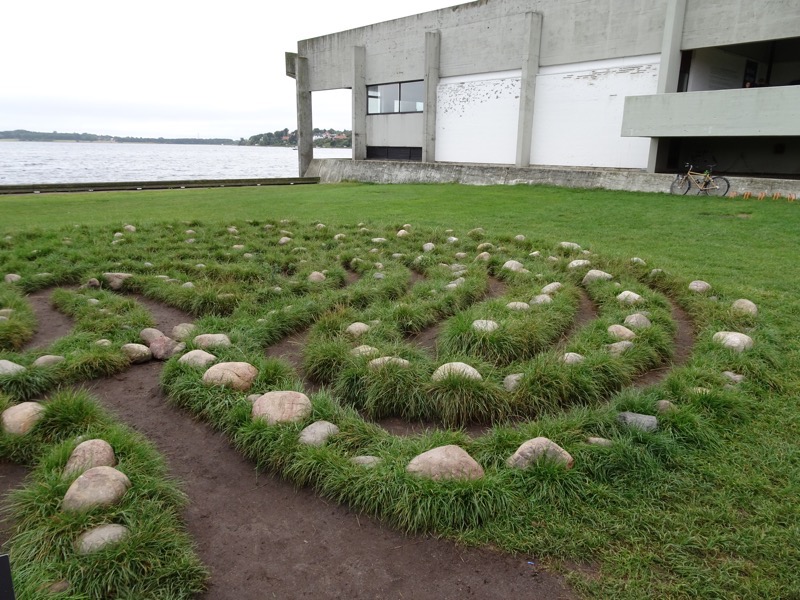
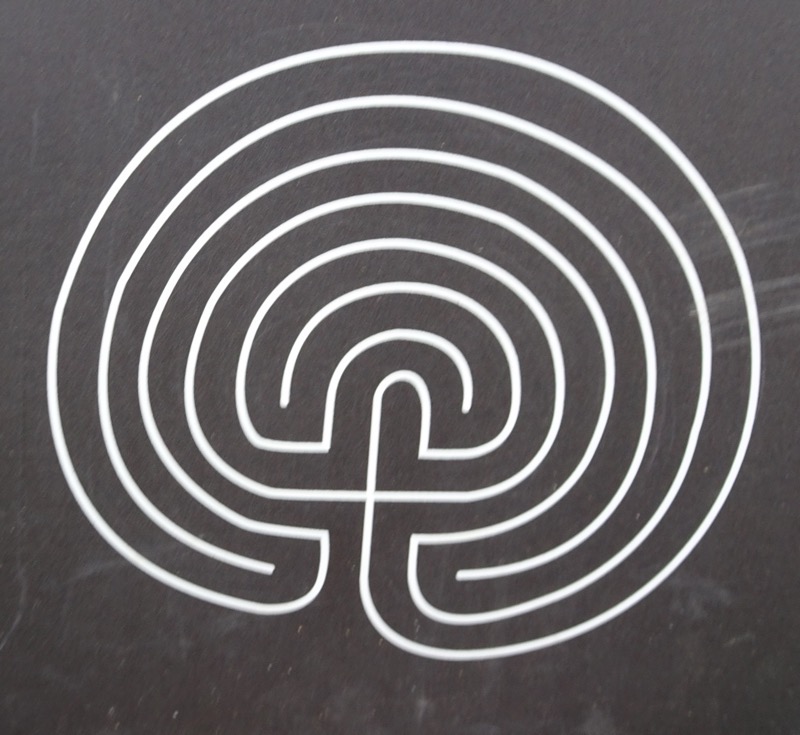 Some other Viking games were also set out for visitors to try:
Some other Viking games were also set out for visitors to try:
Thor’s Hammer Throw:
Thor, the God of War and Thunder, used his hammer Mjolner in the battle against the giants. The hammer was the perfect weapon; always returning to Thor’s hand once it hit its target. Vikings didn’t actually use hammers as a combat weapon – they preferred swords, spears, axes and bows/arrows, but the myth about Thor and his hammer endures.
The aim of the Hammer Throw Game is to ‘hit a giant’. The statues (giants) are positioned on the ground at different distances, each player gets only three throws of a hammer attached to a rope, with a view to knocking over the giants. Whoever knocks over the most giants wins. Can be played with many giants at different distances.
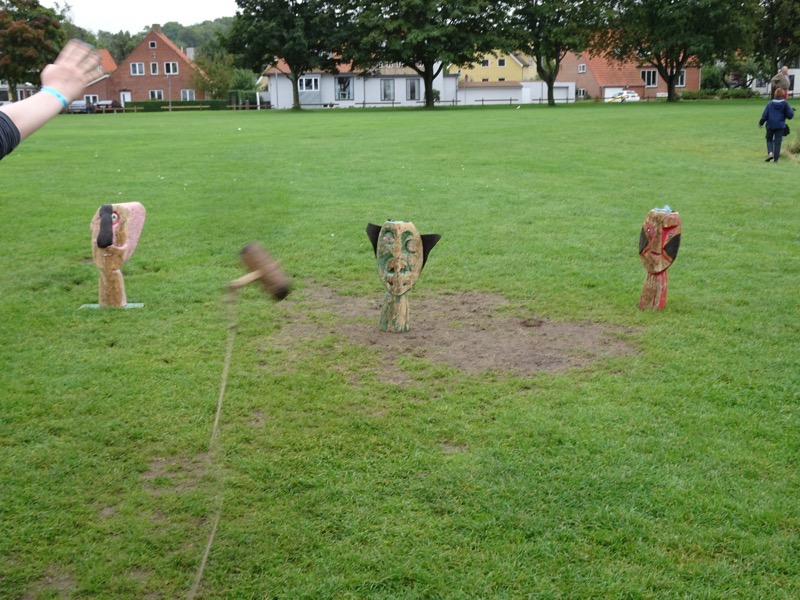 The ‘giants’ are around 45-60cm tall and have different weights and varying degrees of ugly.
The ‘giants’ are around 45-60cm tall and have different weights and varying degrees of ugly.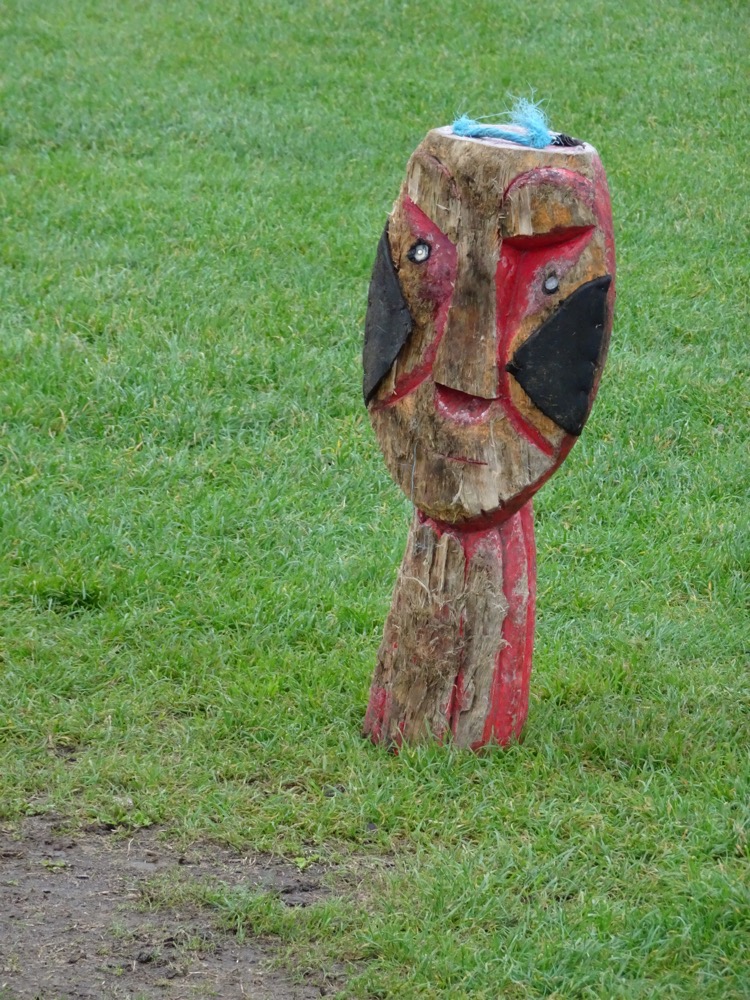
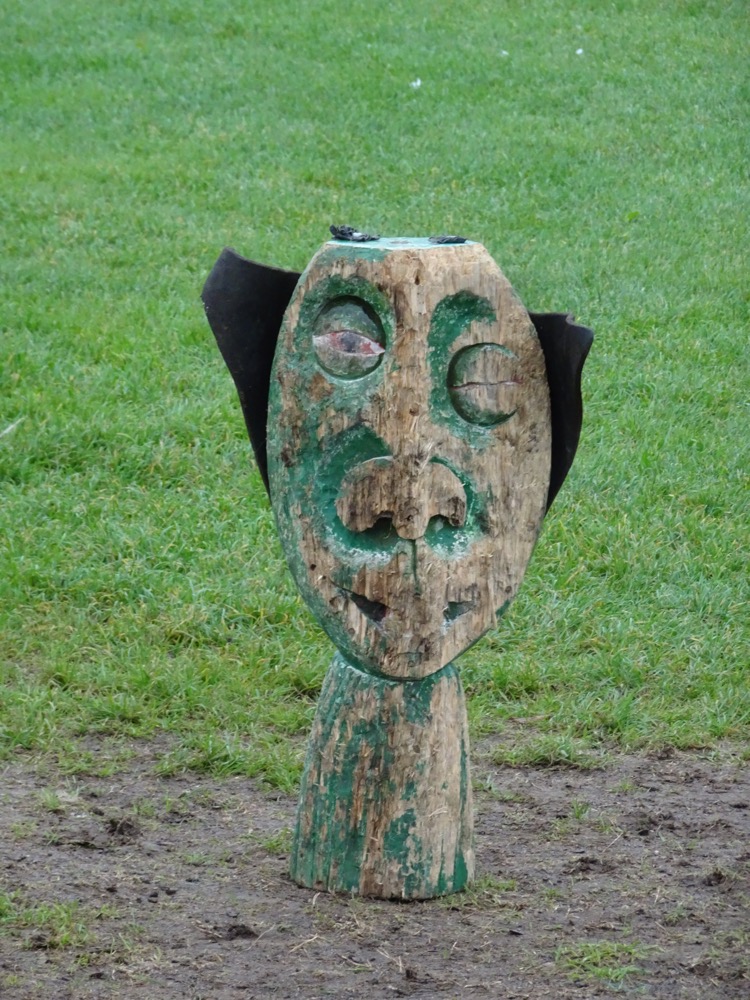
Casting the Mooring Line
Ships and seamanship were important aspects of Viking life. Good seamanship required robustness, nimble fingers and precision. Ability to gauge distances and good throwing technique were essential for casting mooring lines for ships.
The aim of Casting the Mooring Line is to hit the targets with the stone. Six stanchions (timber pegs) are sunk into the ground at varying distances apart, and mark the mooring posts you must hit. The thrower stands behind a marked point and gets three throws with a stone attached to a rope. Only the stone end should be thrown, while the other end of the rope (the ship end) must stay with the thrower (being held under the throwers foot, or pegged down). The best throws hit the space in between the stanchions on the course. Each thrower gets four throws for maximum points.
1pt 3pts 5pts 3pts 1pt
O————-O———O—–O———O————-O
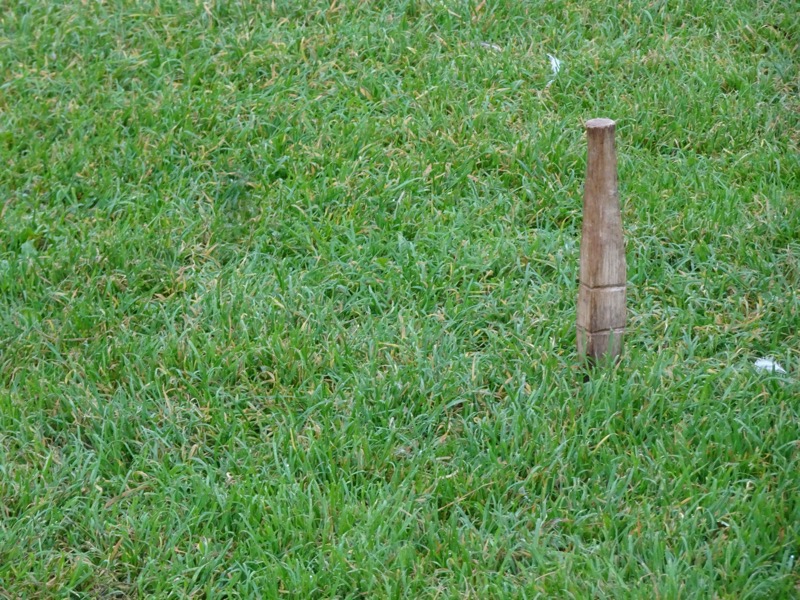 The Troll’s Head
The Troll’s Head
There are many different versions of tug-of-war. In a saga from the Middle Ages, Hasti has a tug-of-war competition against Hord. The contest takes place over a fire and the two contestants pull opposite ends of a skin. In ‘The Troll’s Head’ game, the aim is to force your opponent to step into the troll’s ferocious mouth.
A circle of rope or painted cloth is laid on the ground and forms the ‘troll’s head’. The players hold hands and form a circle around the troll’s head (remove any finger rings that might get in the way). Now you must run, pull and push to try and get others into/onto the troll’s head without losing your grip on one another. Those who step into the troll’s head are out of the game. The last man standing is the winner.
Also popular is a traditional coits game with a cross bar target and rope coits of varying ropes (which have different weights).
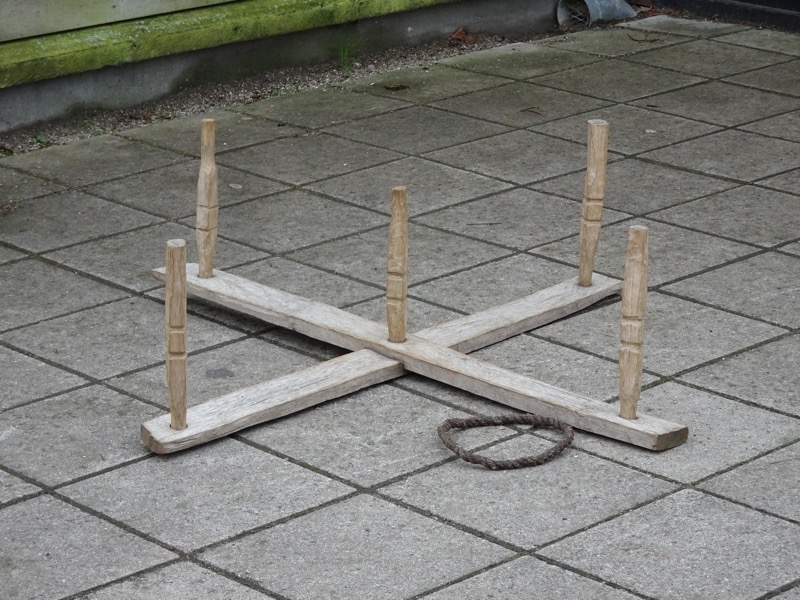 After playing around on the green for a while, it was time to go sailing on a historically accurate Viking ship that had been built by hand, using traditional techniques and tools, right here in the Roskilde Viking shipyard.
After playing around on the green for a while, it was time to go sailing on a historically accurate Viking ship that had been built by hand, using traditional techniques and tools, right here in the Roskilde Viking shipyard.
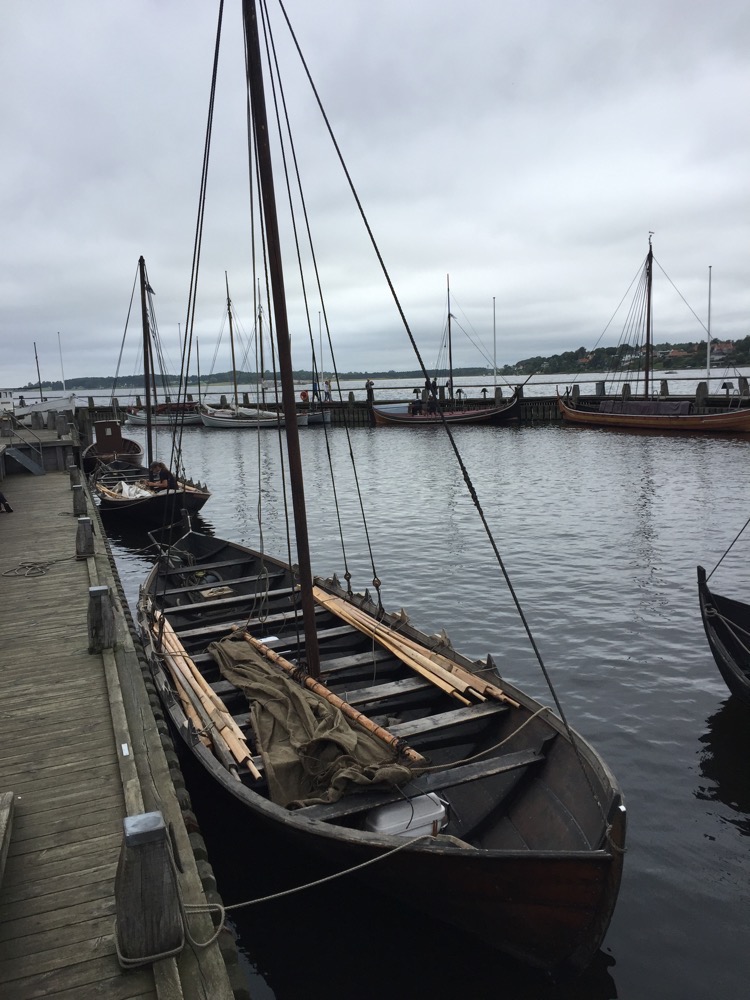 And we have perfect Viking weather for such things – grey, dismal, and constant light drizzly rain.
And we have perfect Viking weather for such things – grey, dismal, and constant light drizzly rain.
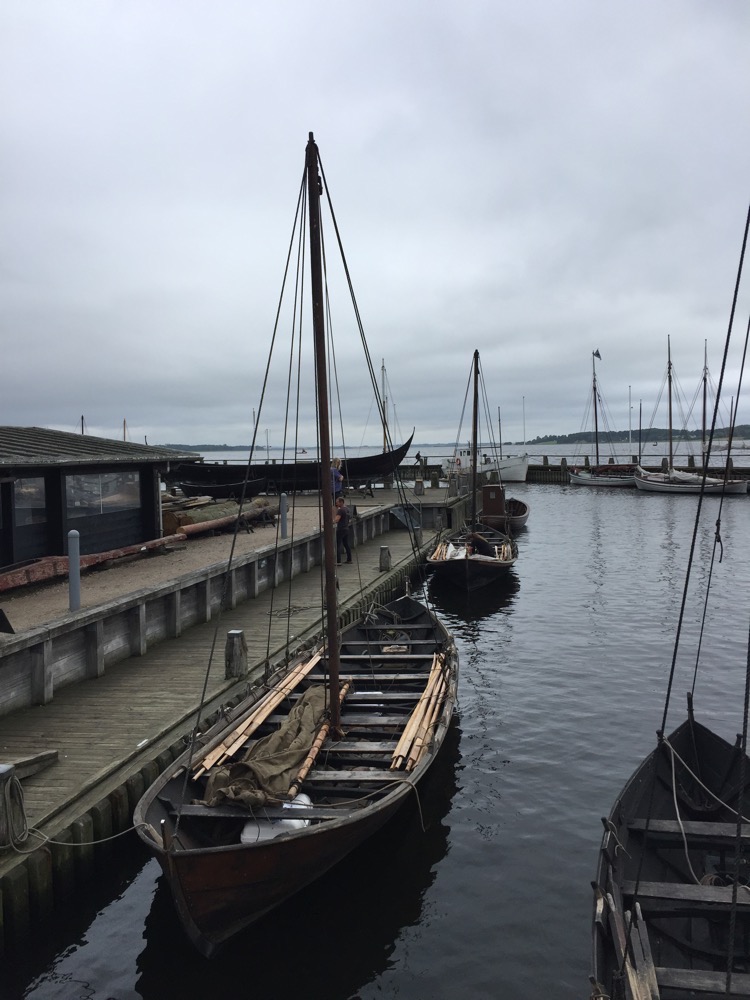 Getting instructions on the various oar commands we needed to use.
Getting instructions on the various oar commands we needed to use.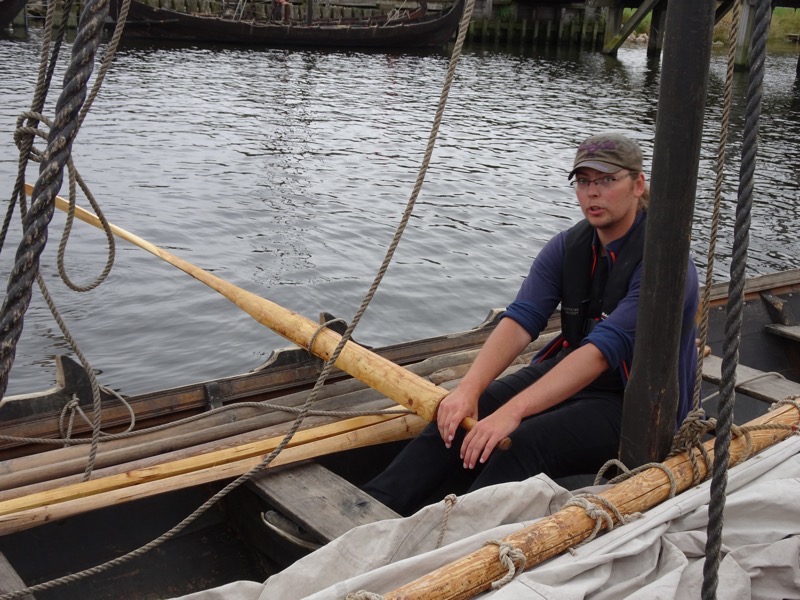
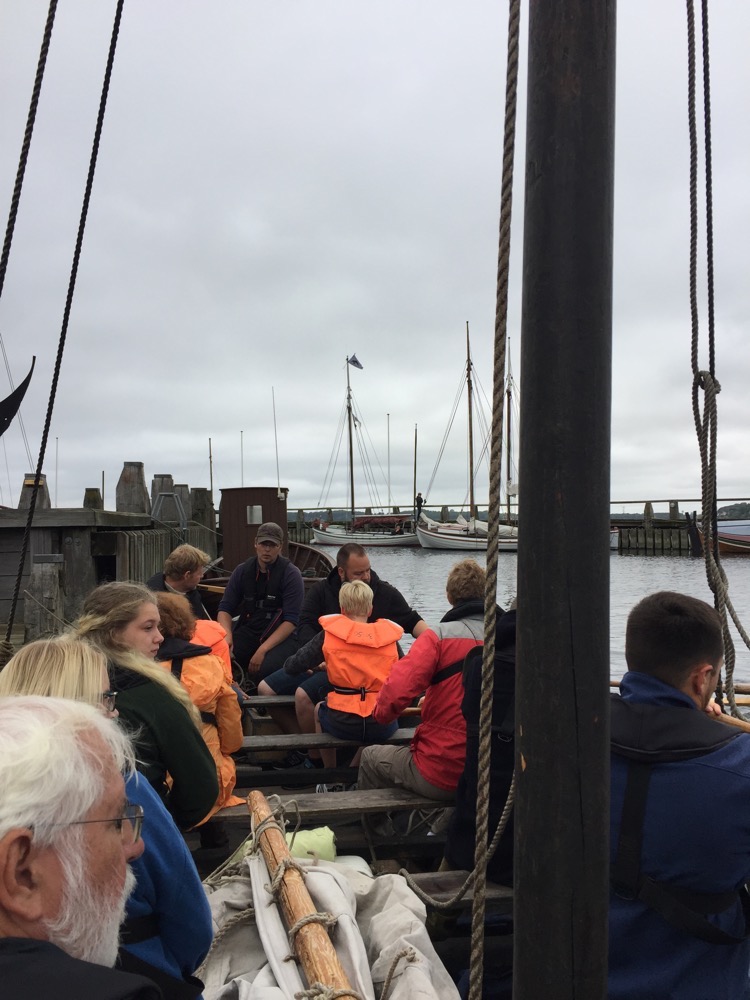
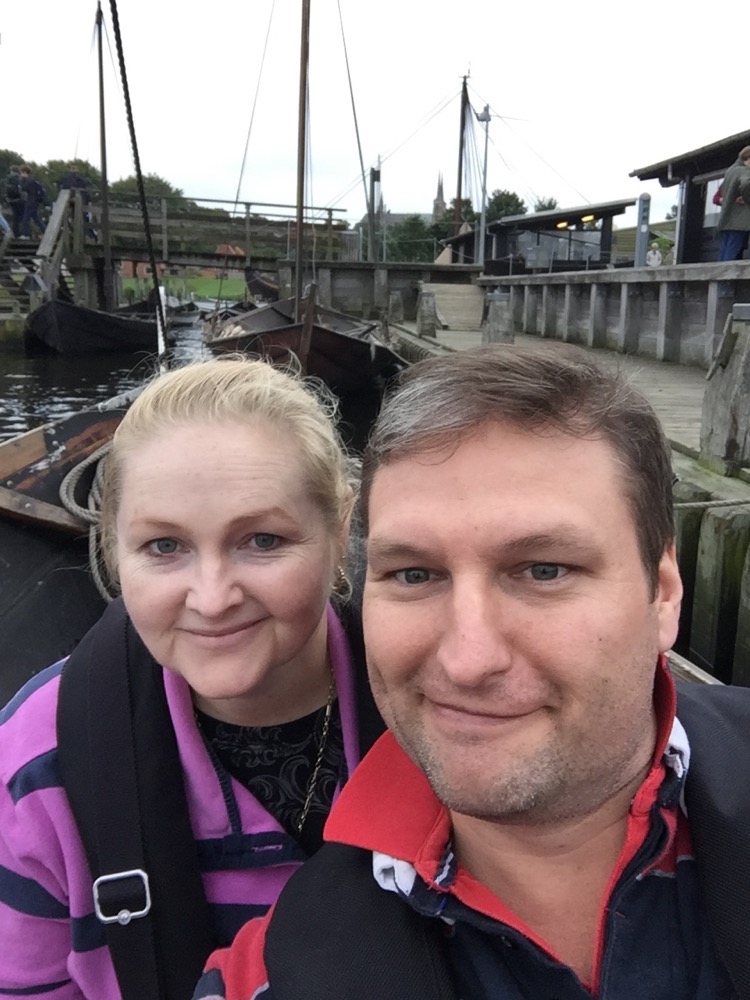 Captain never said, “Row ya bastards!”… not even once! 🙂 He just encouraged people to listen for the slap of the oars in the water and to try and get them in time. Have to admit we were pretty terrible rowers but we managed to manouevre our craft into the open harbour.
Captain never said, “Row ya bastards!”… not even once! 🙂 He just encouraged people to listen for the slap of the oars in the water and to try and get them in time. Have to admit we were pretty terrible rowers but we managed to manouevre our craft into the open harbour.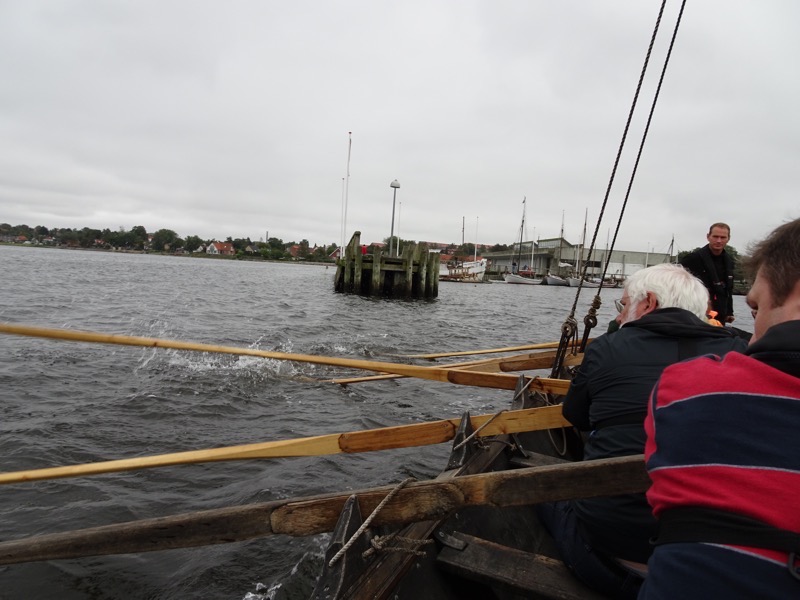
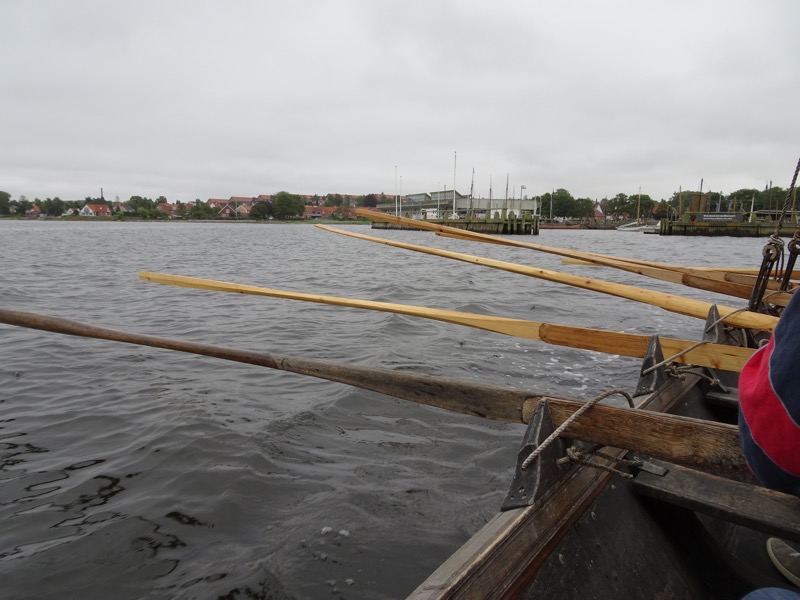 From here the sail was hoisted and we moved along with relative ease.
From here the sail was hoisted and we moved along with relative ease.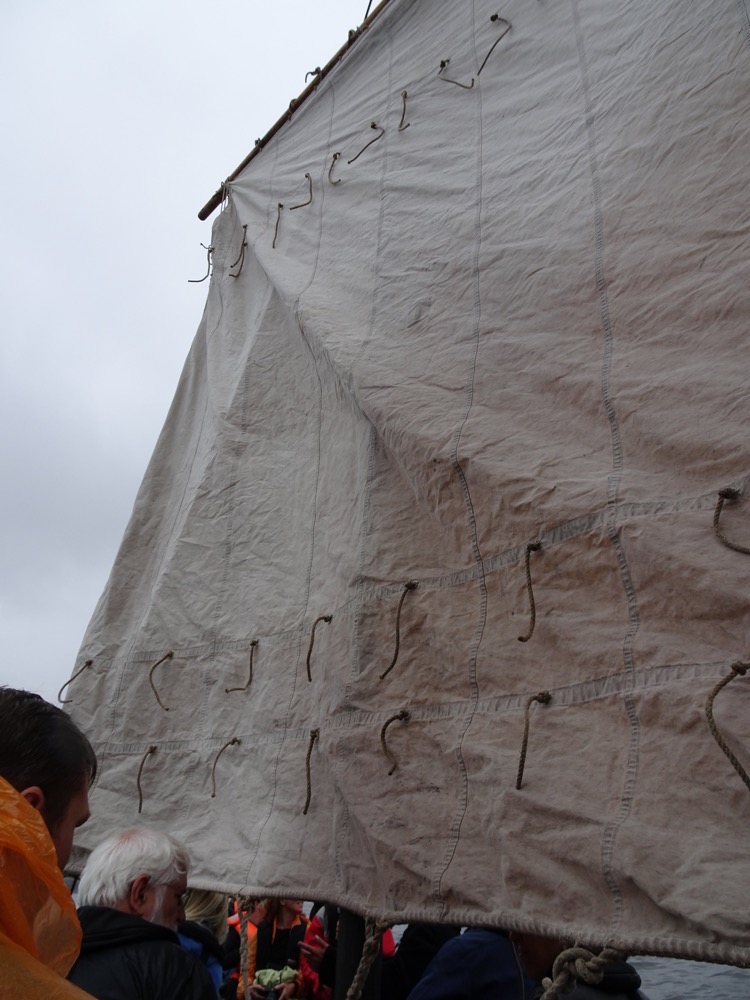
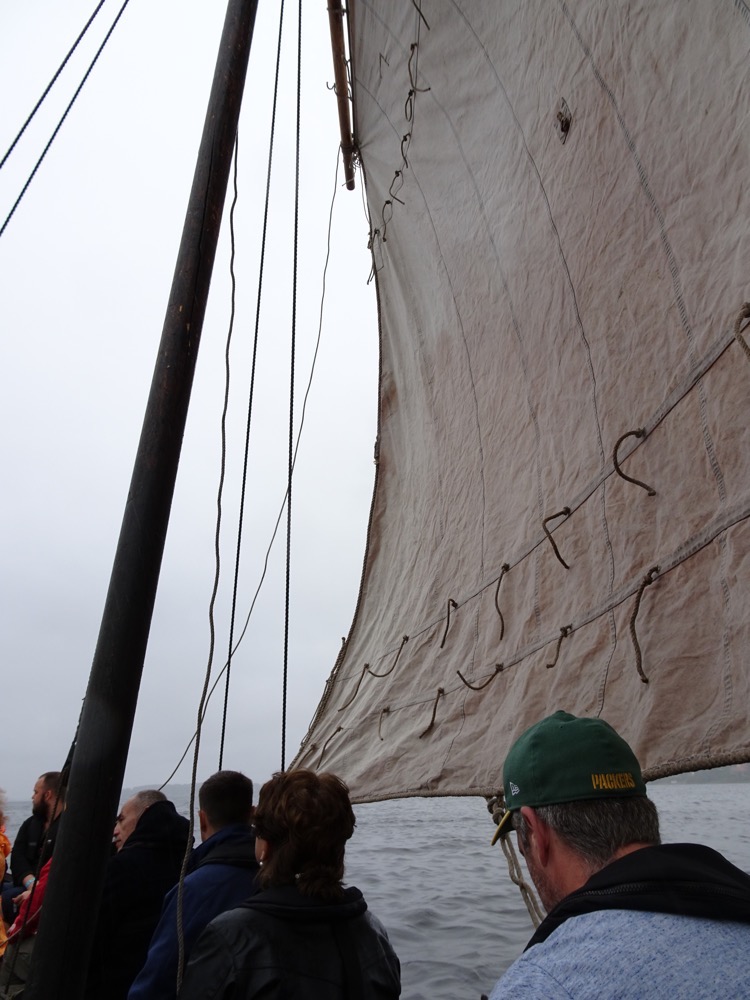 Ballast in the bottom of the boat.
Ballast in the bottom of the boat.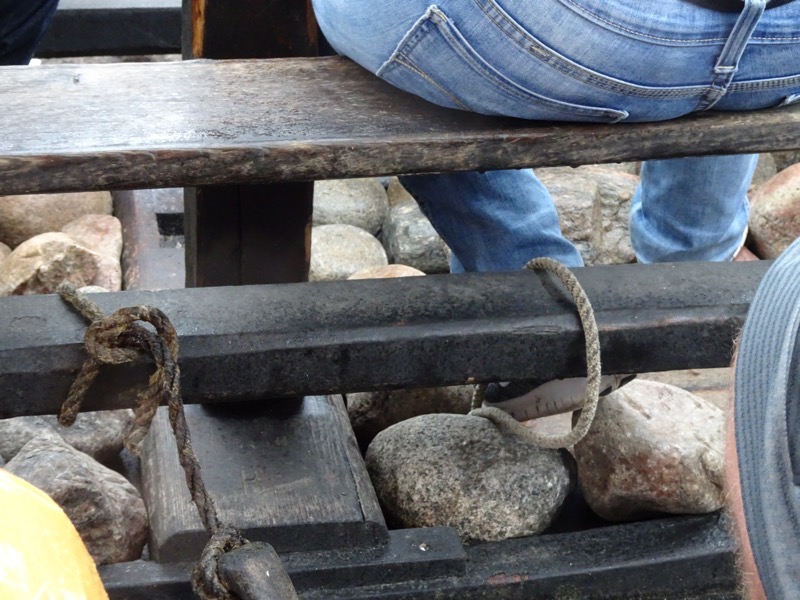 Nearly getting knocked in the head as we tacked.
Nearly getting knocked in the head as we tacked.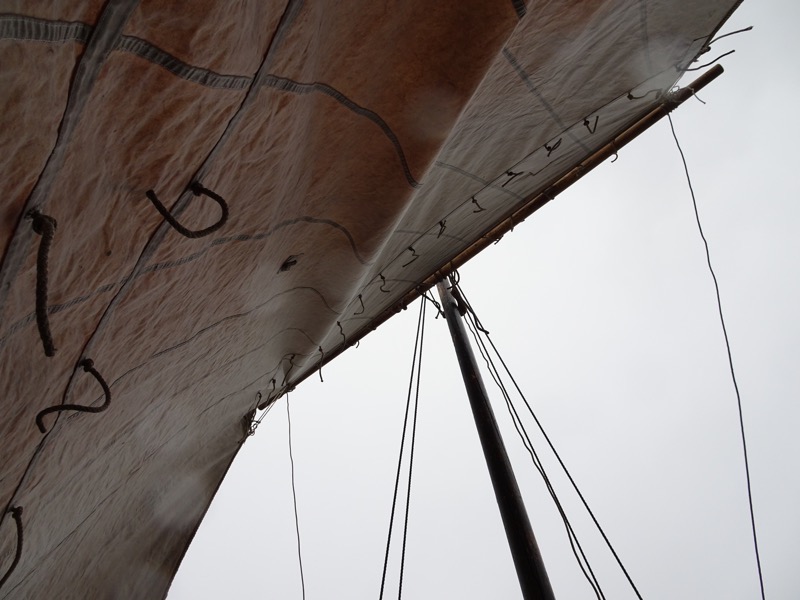 After our bracing sail around the Roskilde harbour, we went over the Vikingskib Museet to see the remnants of some extant Viking ships that had been found in the Roskilde Fjord, and to hopefully warm up!
After our bracing sail around the Roskilde harbour, we went over the Vikingskib Museet to see the remnants of some extant Viking ships that had been found in the Roskilde Fjord, and to hopefully warm up!
The Viking Age (arguably) covers approximately from 750 to 1100AD and was characterized by large-scale trading and raiding expeditions, national unification, some urbanization and a wide scale conversion to Christianity. Around the year 1000, the power of the Danish realm was concentrated in Roskilde, as the new monarchical and ecclesiastical capital. The town was unfortified but naturally protected at the base of Roskilde Fjord. The town center was situated on a hilltop overlooking a wide landing place where ships could lay at anchor.
The towns primary protection from invaders relied on a system of signal fires (beacons) placed strategically down the fjord from the mouth of the fjord at Kattegat into Isefjord. Beacons would have been set on high ground with good visibility to the next beacon. The town’s secondary defense consisted of unseen sunken ships, piles of stone, driven posts and floating palisades near the island of Kolholm which allowed the three sailing channels to be blocked off when under attack. Five sunk ships have been recovered from the Peberrenden channel that was used for this purposes. They have been labeled Skuldelev 1 through to 5. Skuldelev 1, 3 and 5 were filled with stones and scuttled between 1060 and 1070. A few years later the barriers had partially disintegrated and two more ships Skuldelev 2 and 4 were also scuttled. The channel was still navigable but required local knowledge.
The town’s secondary defense consisted of unseen sunken ships, piles of stone, driven posts and floating palisades near the island of Kolholm which allowed the three sailing channels to be blocked off when under attack. Five sunk ships have been recovered from the Peberrenden channel that was used for this purposes. They have been labeled Skuldelev 1 through to 5. Skuldelev 1, 3 and 5 were filled with stones and scuttled between 1060 and 1070. A few years later the barriers had partially disintegrated and two more ships Skuldelev 2 and 4 were also scuttled. The channel was still navigable but required local knowledge.
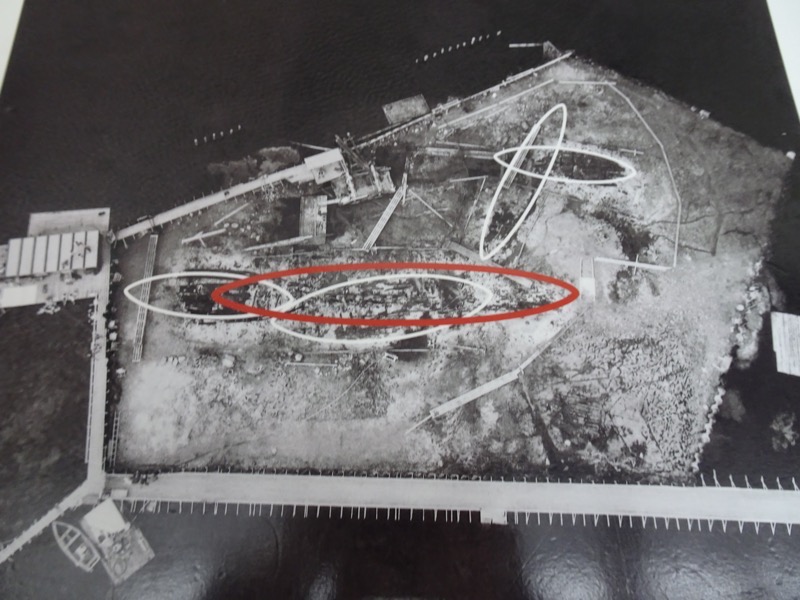
The ships were initially investigated underwater in the 1950s and not long after a cofferdam barrier was built in 1962 allowing the area to be drained and hundreds of thousands of ship parts to be excavated. There followed the worlds biggest jigsaw puzzle that took 25 years to complete, as the five Skuldelev collections of different ships, used for fishing, trading, defense, and warfare, were painstakingly pieced back together.
They provide a unique perspective on Viking Age maritime culture; shipbuilding, seamanship and the ability to journey far from their homes.
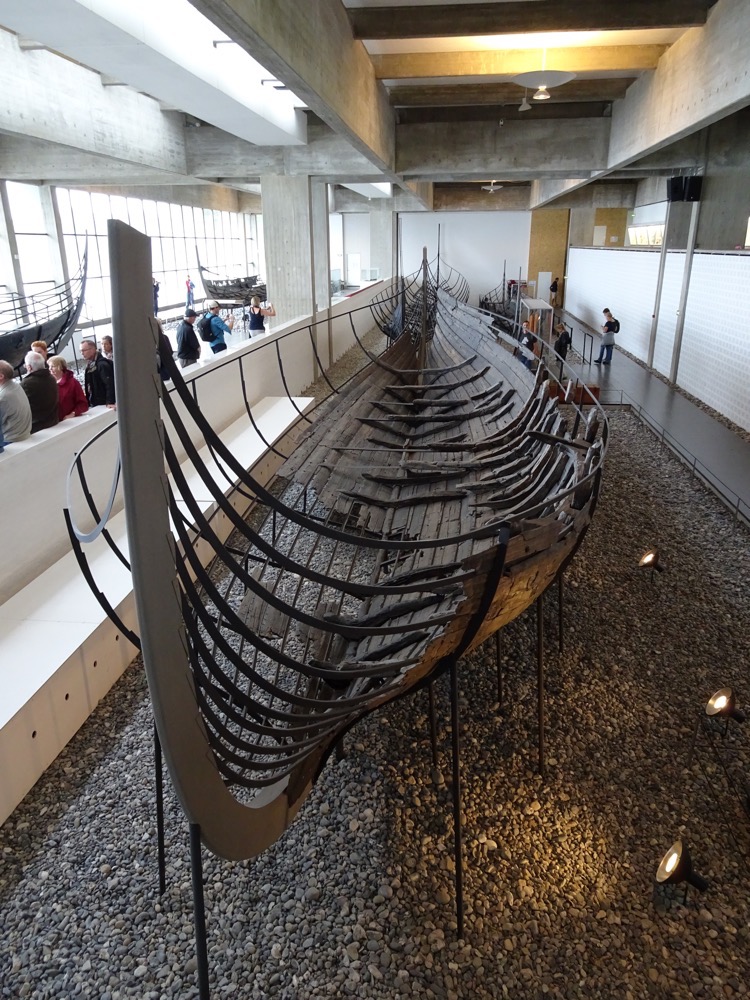 Coastal Trader ship – small elegant trading and transport vessel, of the byrding type. Made of Danish oak, it has decks of loose plans and an open hold for about 4 tons of cargo. The ship would have been crewed by 5-8 men.
Coastal Trader ship – small elegant trading and transport vessel, of the byrding type. Made of Danish oak, it has decks of loose plans and an open hold for about 4 tons of cargo. The ship would have been crewed by 5-8 men.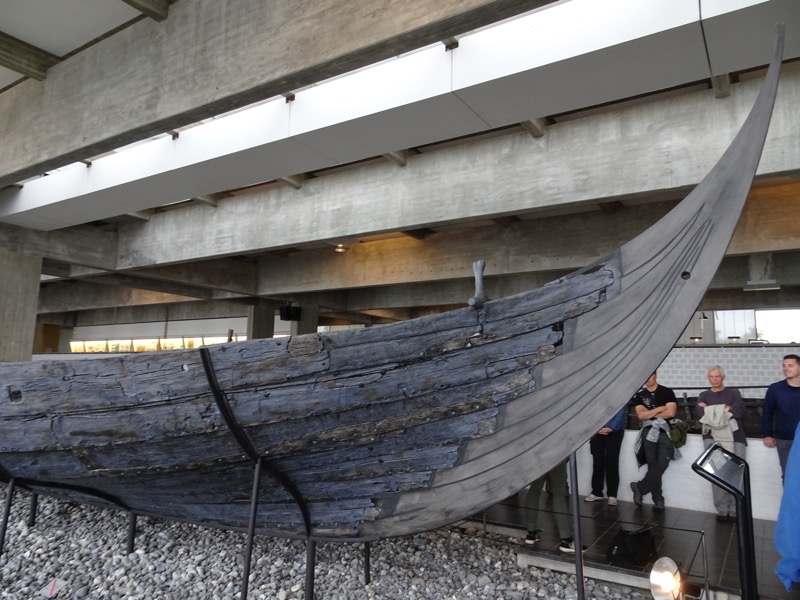
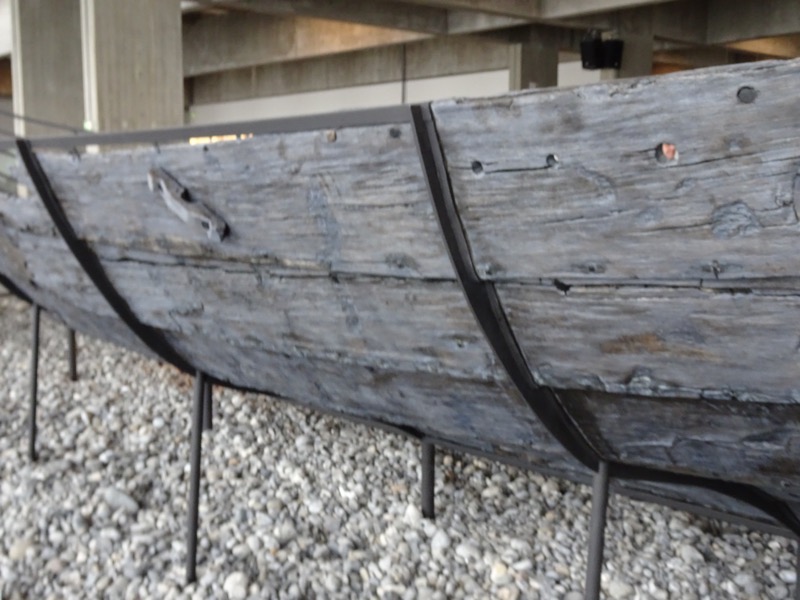
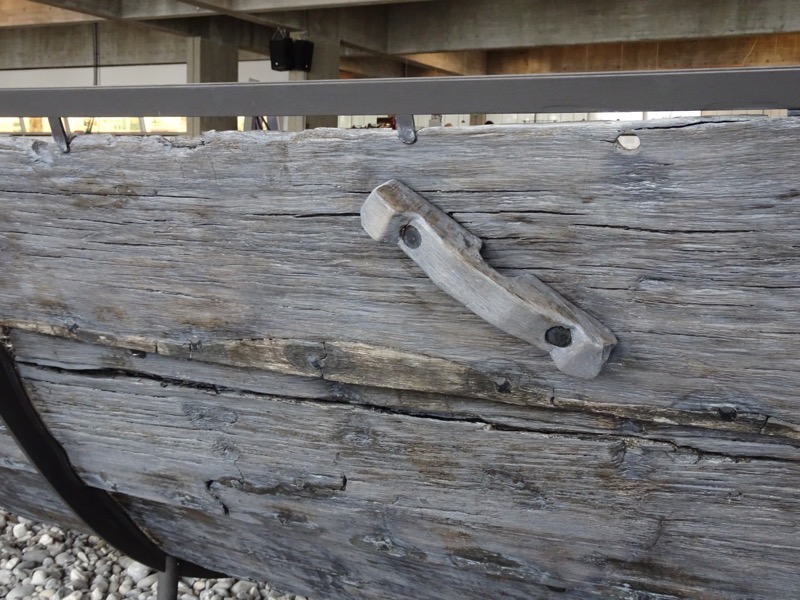
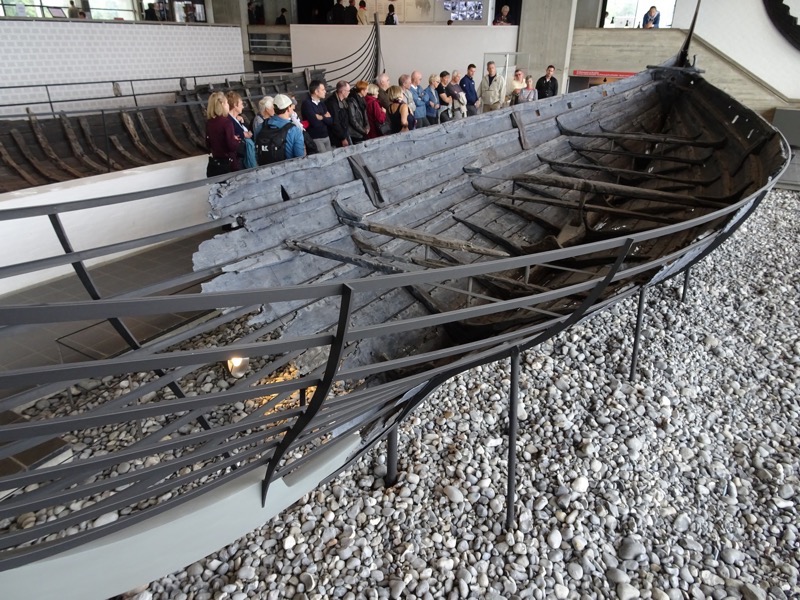
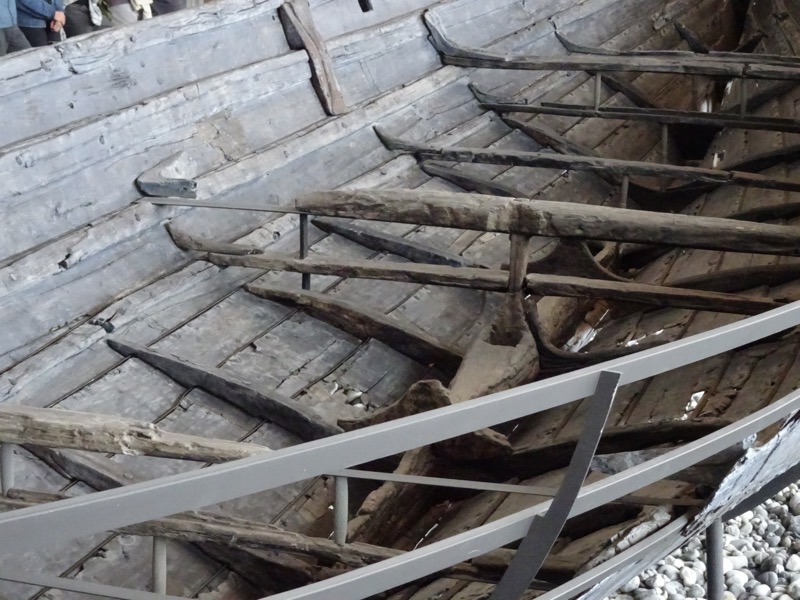
Wreck 5 is a small warship possibly of the snekke type. Built of Danish oak, ash and pine party by reusing timber from other ships. With 13 pairs of oars, and about 30 warriors, it is one of the smallest longships in a war fleet. Along the sheerstrake are remnants of a shield rack.
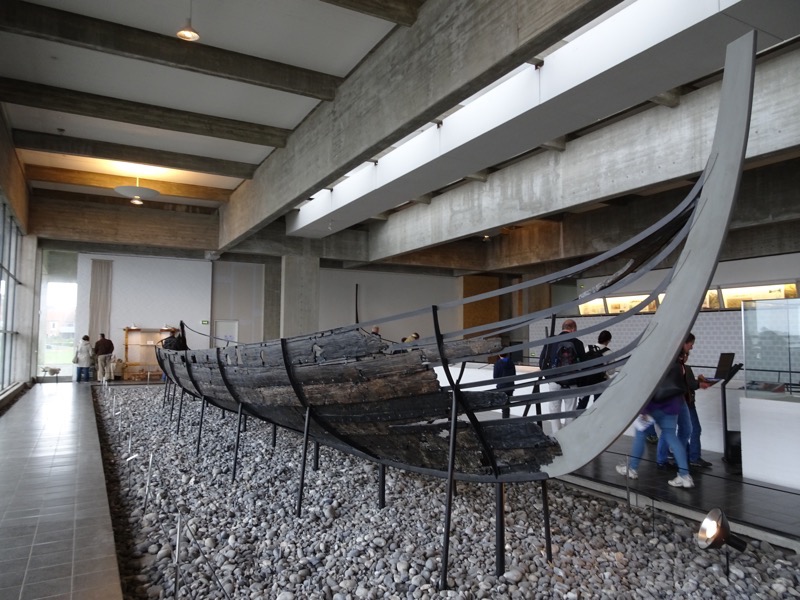
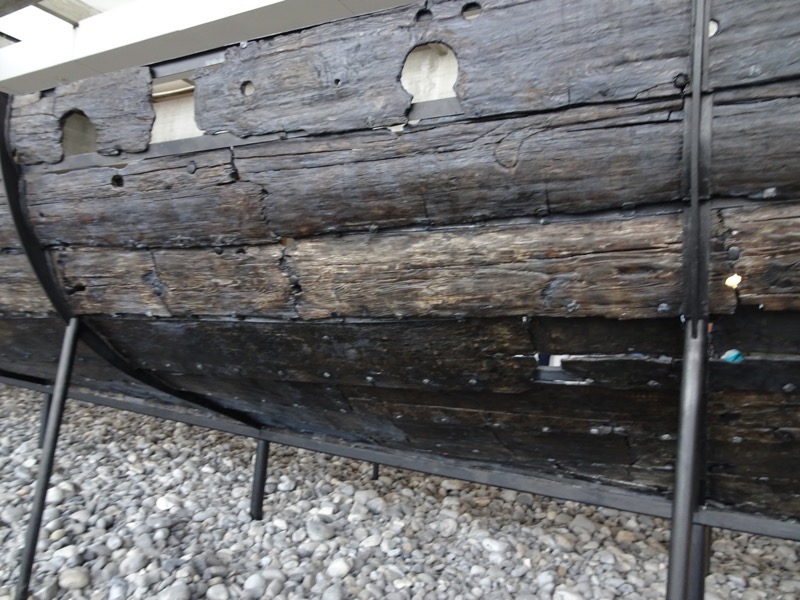
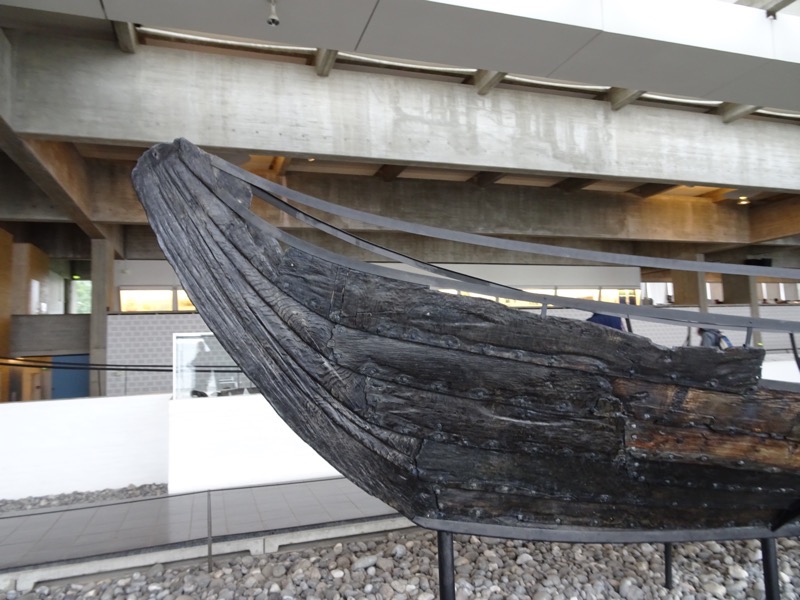
The Longship was an ocean going warship, possibly of the skeid type. With a crew of 65-70 warriors, it must have been the ship of a magnate, a vessel like those whose praises were sung in ancient skaldic verse and sagas. The ship was built of oak, and tree-ring analysis of the timber revels the ship was built in the Dublin area around 1042. Vikings had settled Ireland as early as 800AD and established several fortified bases along the Irish coast. The long narrow shape of the ship allowed for great speed and the manning of 60 oars would have allowed the ship to keep moving even without wind. The Sea Stallion from Glendalough is a reconstruction of this ship, and under sail, it has a top speed of 12 knots.
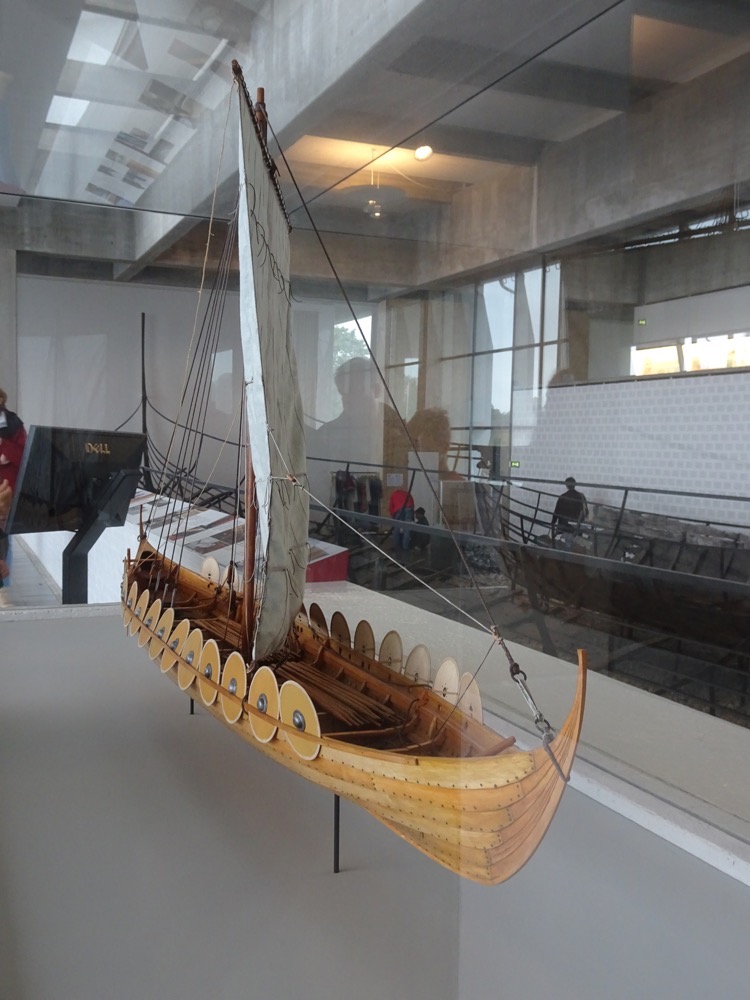
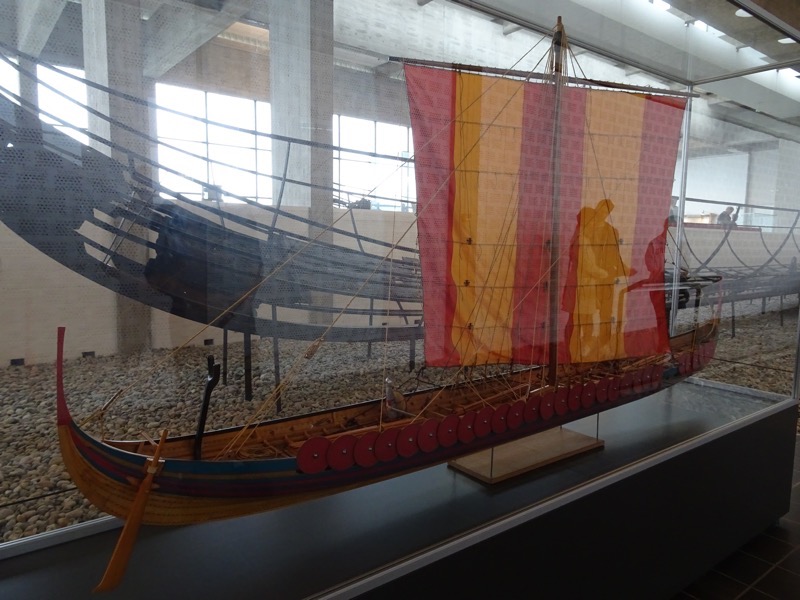
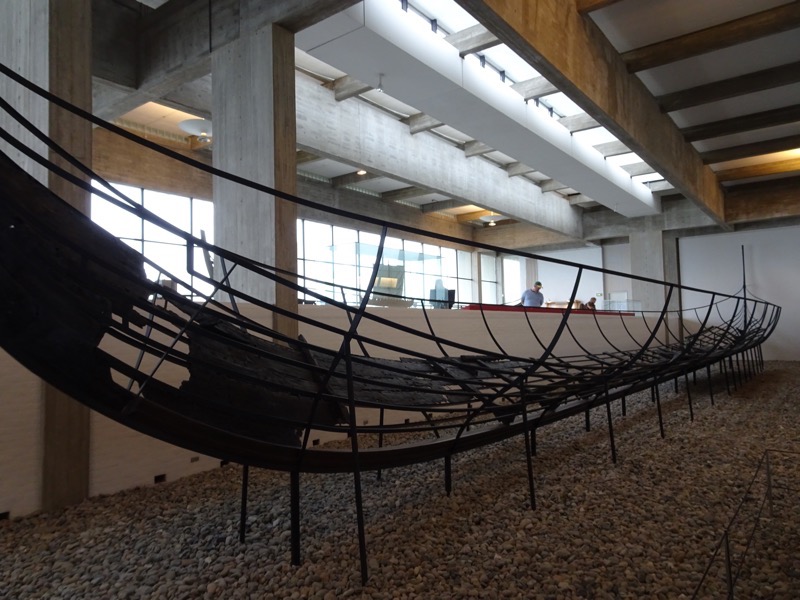 Small Fishing vessel – this ship is a combined rowing and sailing vessel probably built for fishing or seal hunting. It was built of pine planks near Sognefjord in Norway. Later an extra plank was added to increase the height of the side in order to transport more efficiently cargoes of livestock, trading goods or people. During the alterations, the rowlocks were removed and the number of oars reduced. The conversion suggests that the ship was probably used more for transport and less fishing, sailing with a smaller crew.
Small Fishing vessel – this ship is a combined rowing and sailing vessel probably built for fishing or seal hunting. It was built of pine planks near Sognefjord in Norway. Later an extra plank was added to increase the height of the side in order to transport more efficiently cargoes of livestock, trading goods or people. During the alterations, the rowlocks were removed and the number of oars reduced. The conversion suggests that the ship was probably used more for transport and less fishing, sailing with a smaller crew.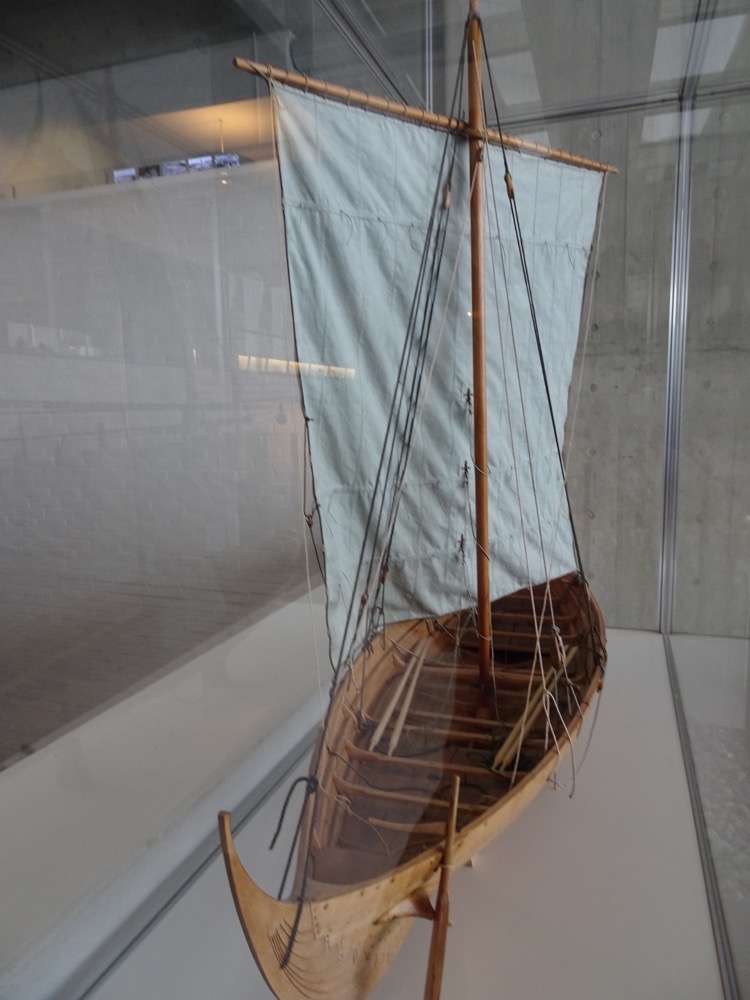
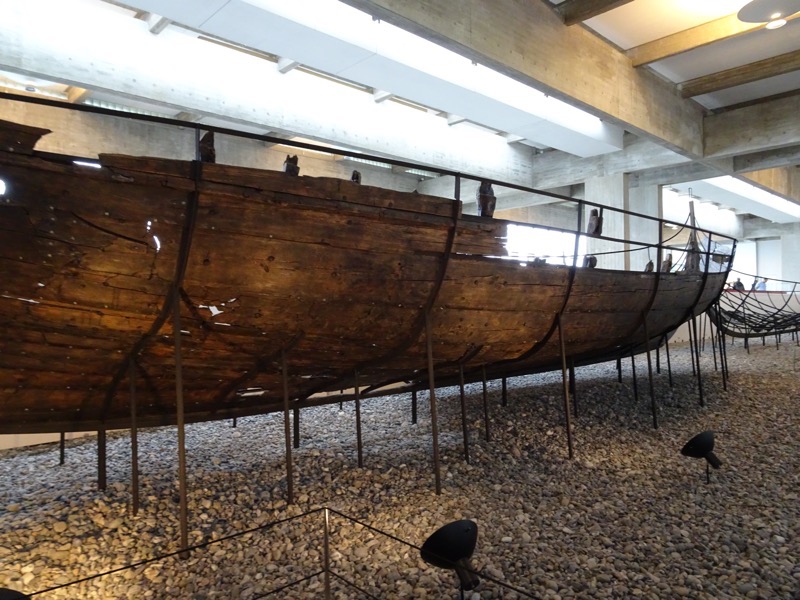
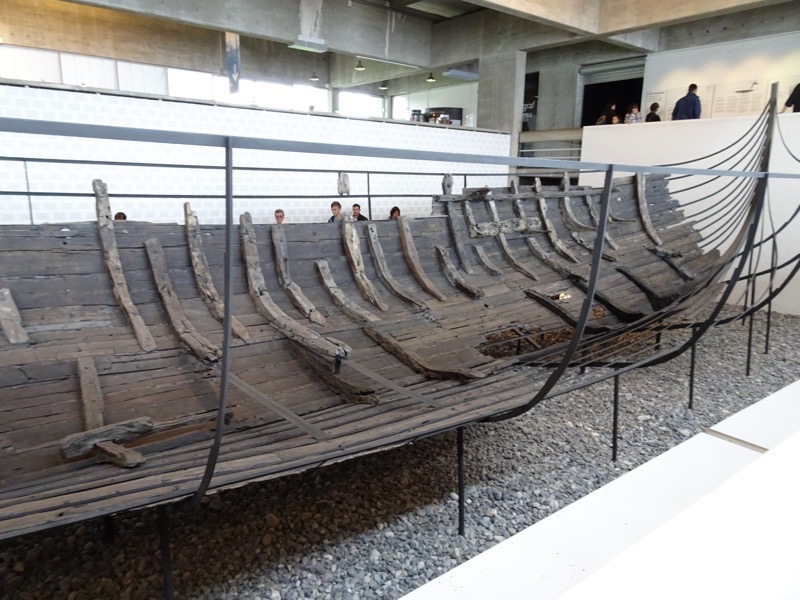
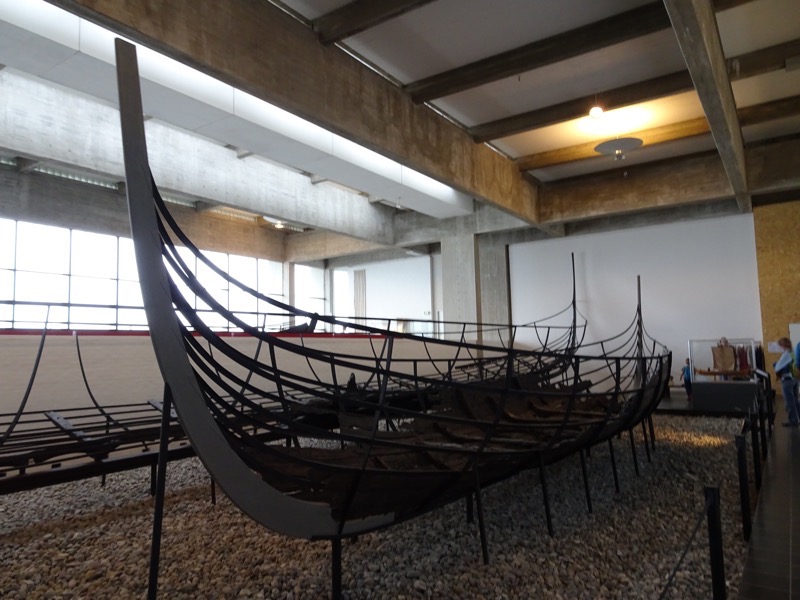
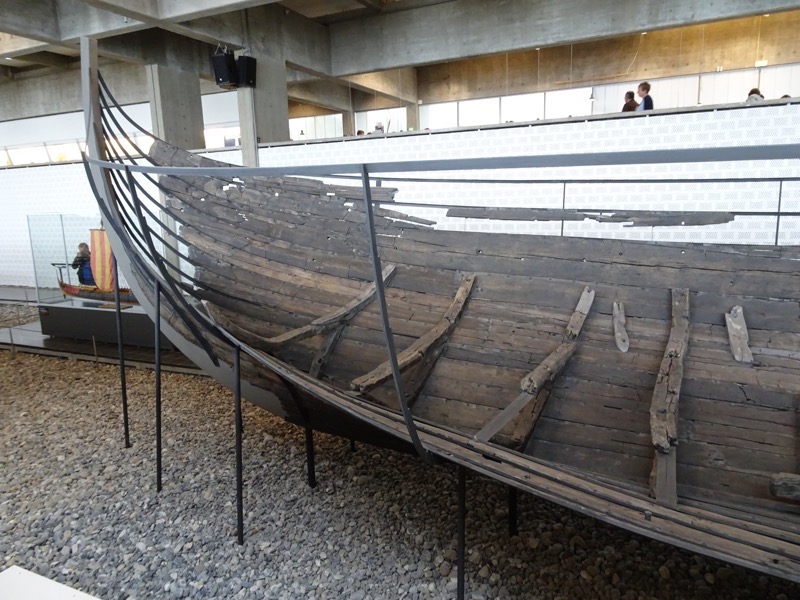
After the museum we stopped for a bite to eat at the shipyard’s cafe – New Nordic Viking Food as it was touted on the menu, so we thought we’d give it a crack. A flatbread plate with a beer, some red wine and some mead… it was so good!
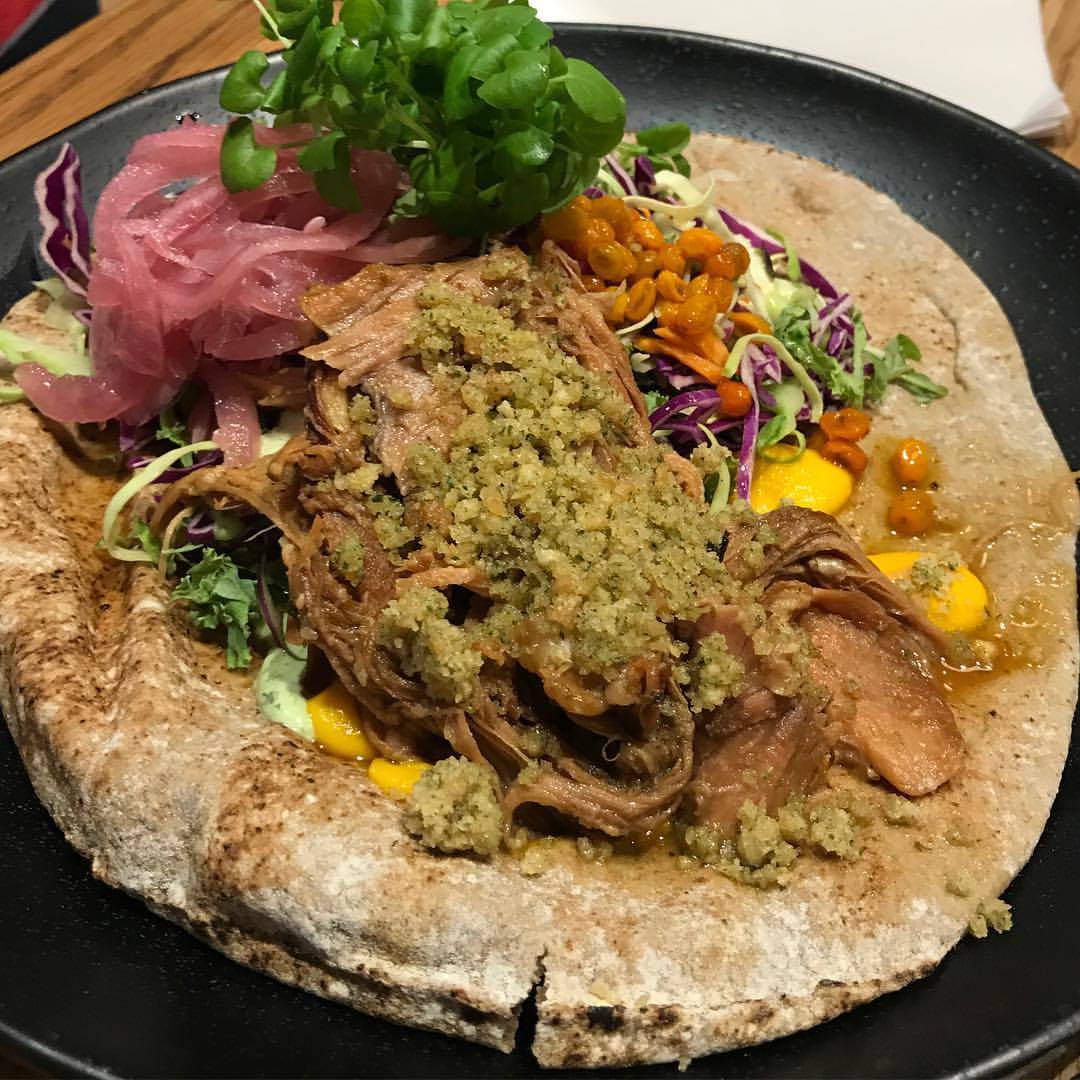 Beer-braised pork with crunchy crackling on flat bread with cabbage, grated carrot, pickled red onion, watercress and sea buckthorn salad with herbed crime fraiche dressing.
Beer-braised pork with crunchy crackling on flat bread with cabbage, grated carrot, pickled red onion, watercress and sea buckthorn salad with herbed crime fraiche dressing.
After lunch, we walked into Roskilde to see the famous Roskilde Cathedral. Roskilde Cathedral is the first gothic cathedral to be built of brick – its success encouraged the brick gothic style throughout Northern Europe. Originally constructed during the 12th to 13th centuries, the cathedral has many gothic and romanesque architectural features. It was Zealand’s only cathedral until the early 20th century.
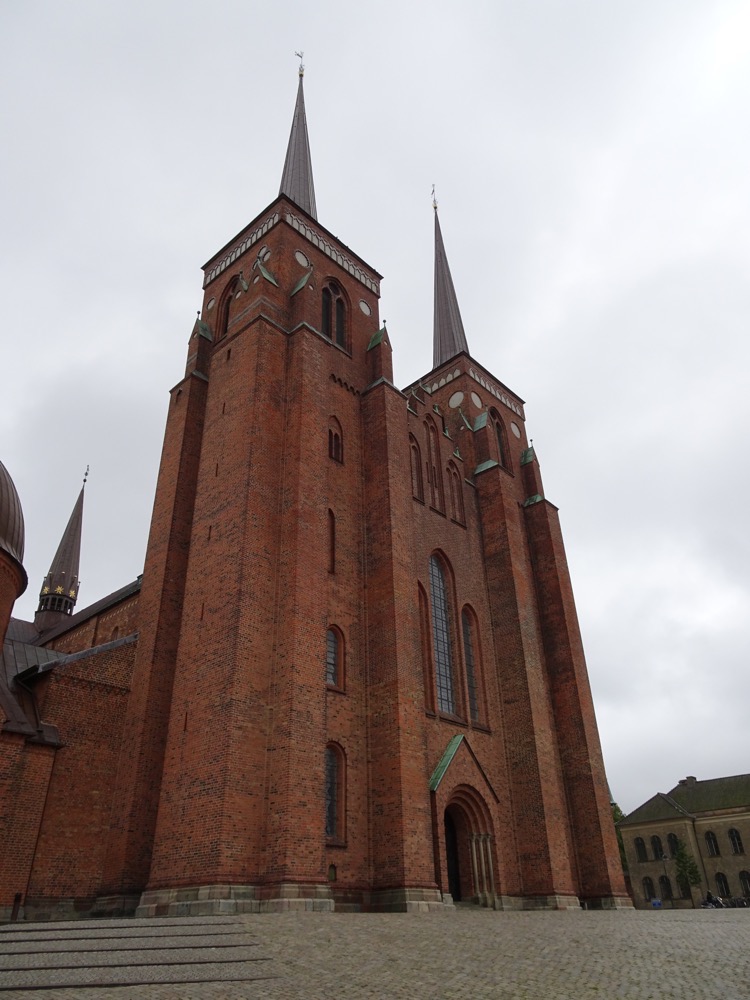 It’s beautiful twin spires dominate the skyline of the city of Roskilde.
It’s beautiful twin spires dominate the skyline of the city of Roskilde.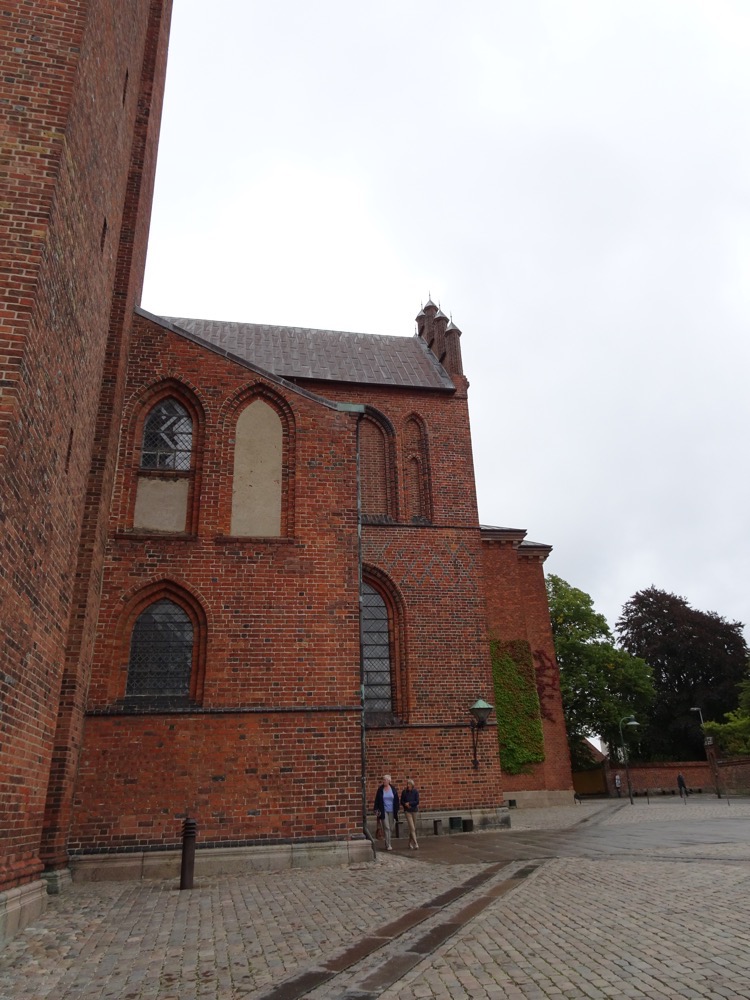
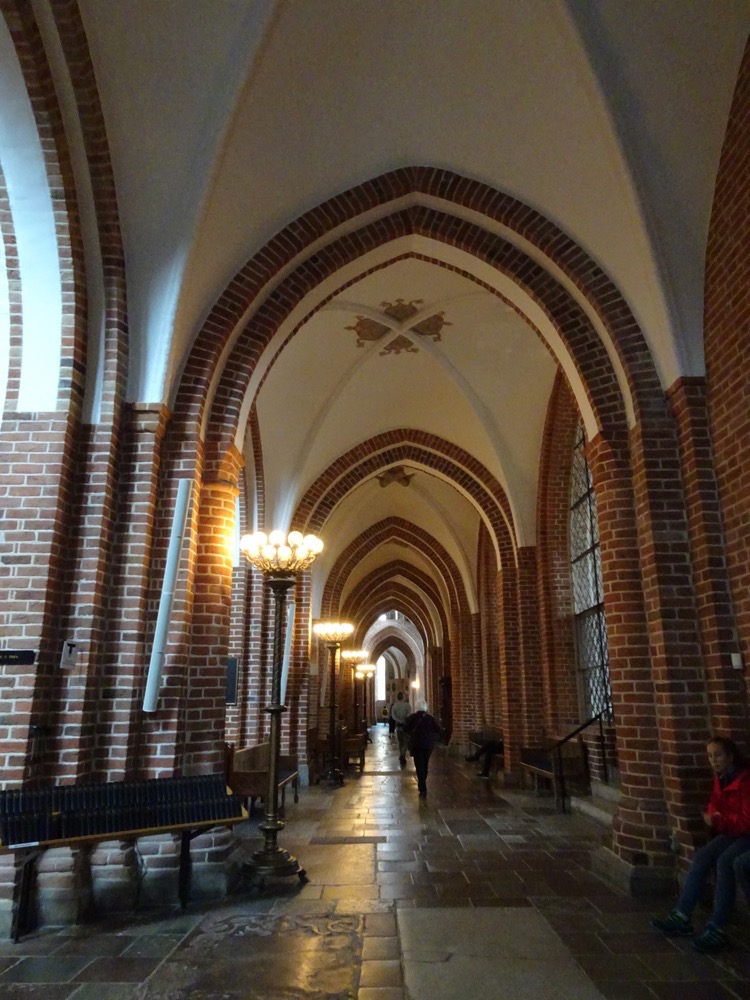 Towards the altar and the nave of the church.
Towards the altar and the nave of the church.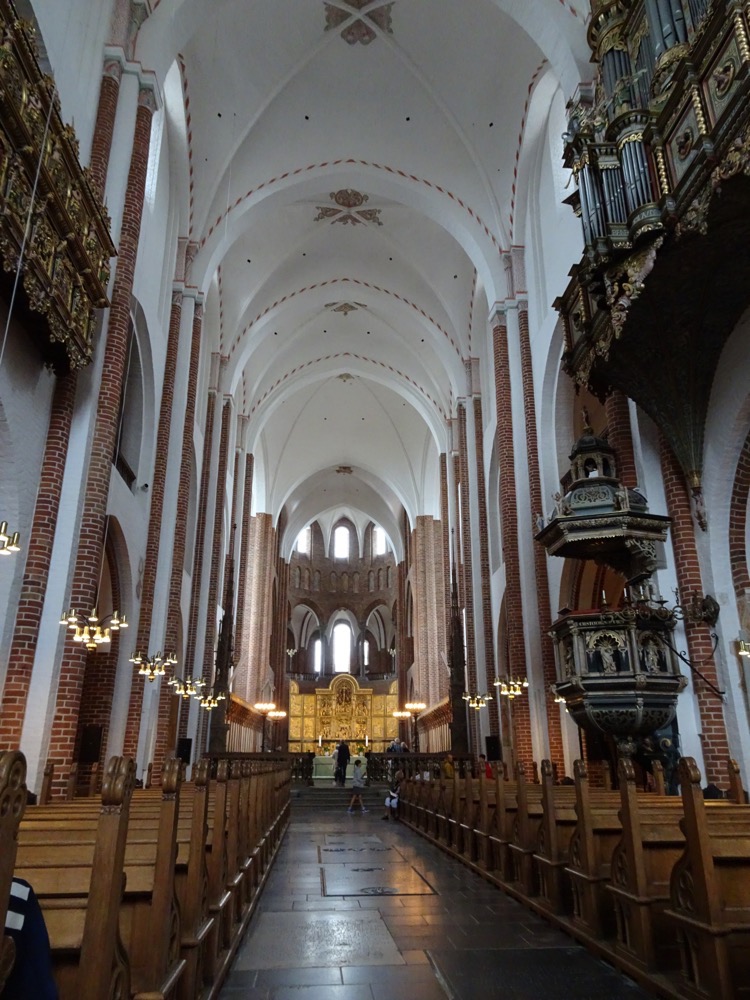 Pulpit, c.1610 AD.
Pulpit, c.1610 AD.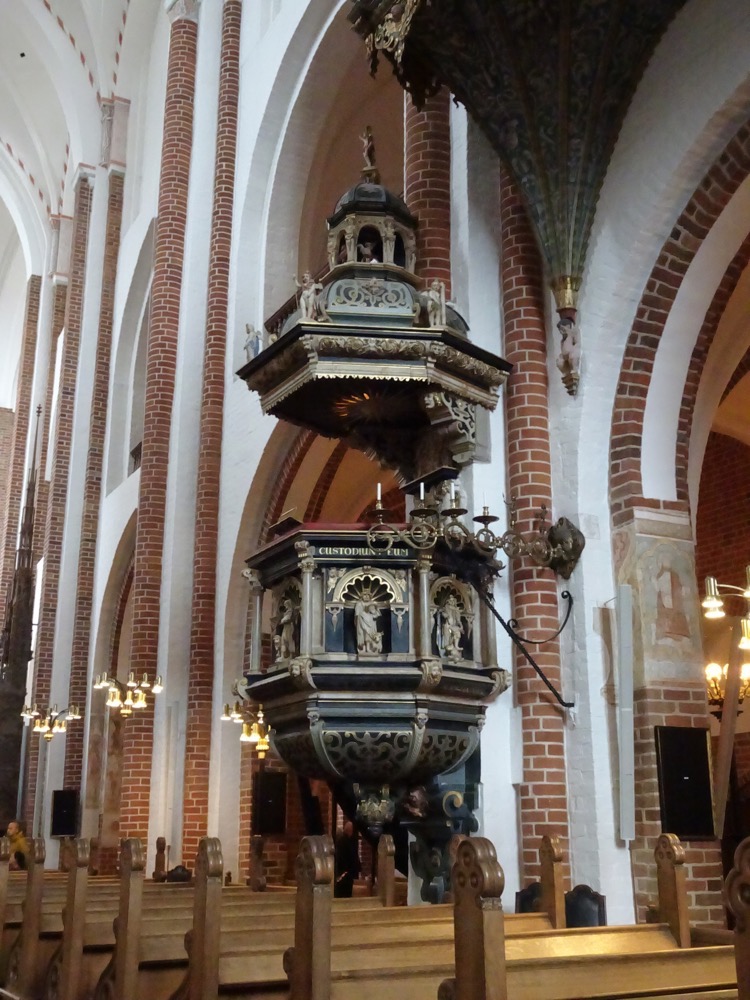 Gorgeous carved timber pews worn with age.
Gorgeous carved timber pews worn with age.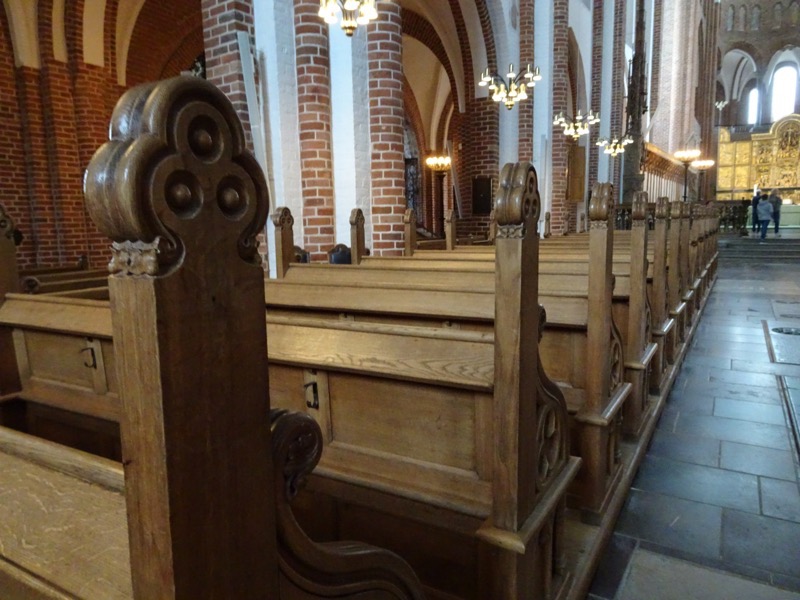 Organ.
Organ.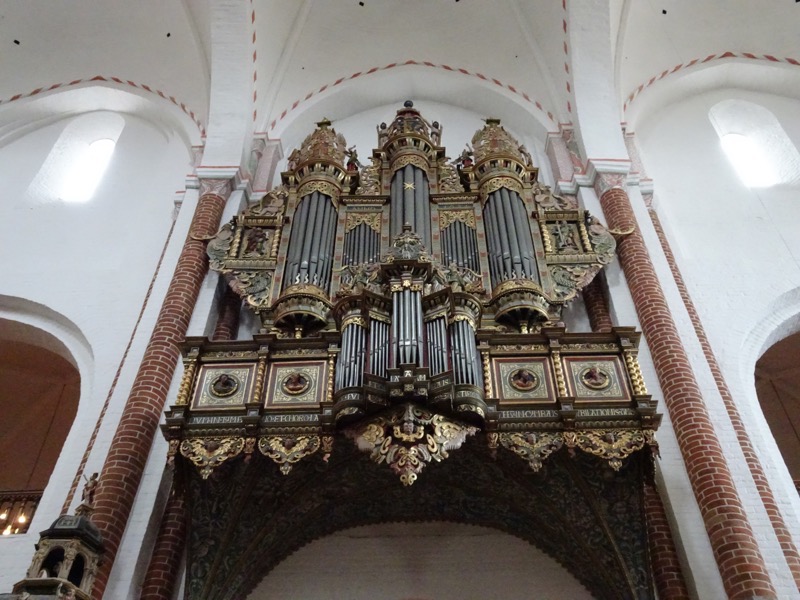
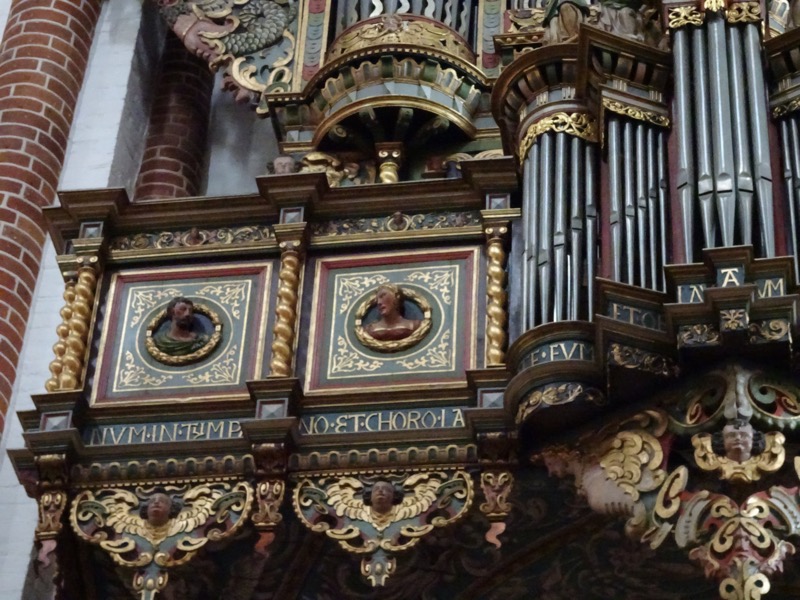 Stalls leading towards the altar.
Stalls leading towards the altar.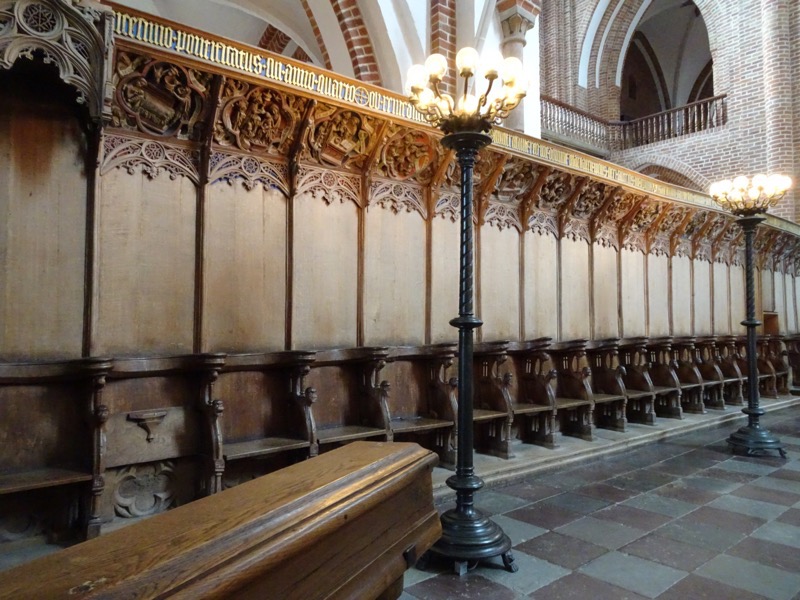
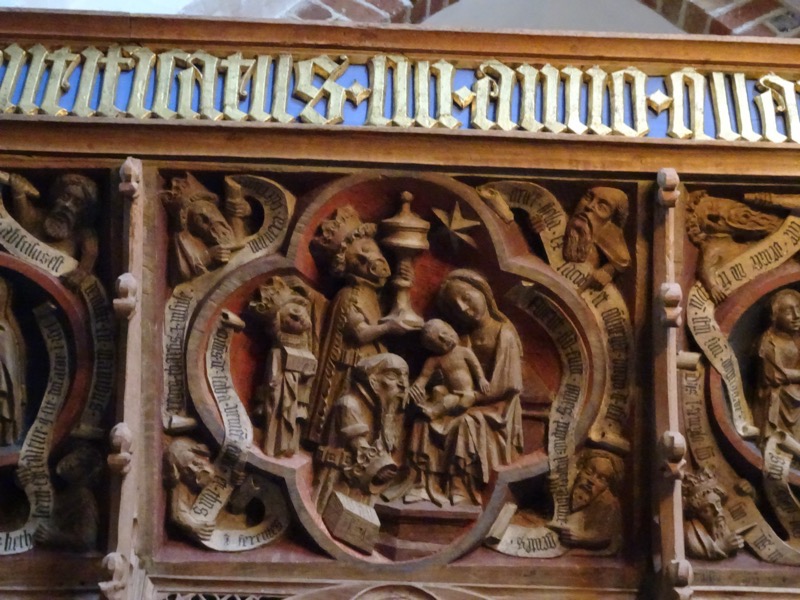 I have no idea what this guy with the club is doing to that baby… but it could be a representation of the Slaughter of the Innocents.
I have no idea what this guy with the club is doing to that baby… but it could be a representation of the Slaughter of the Innocents.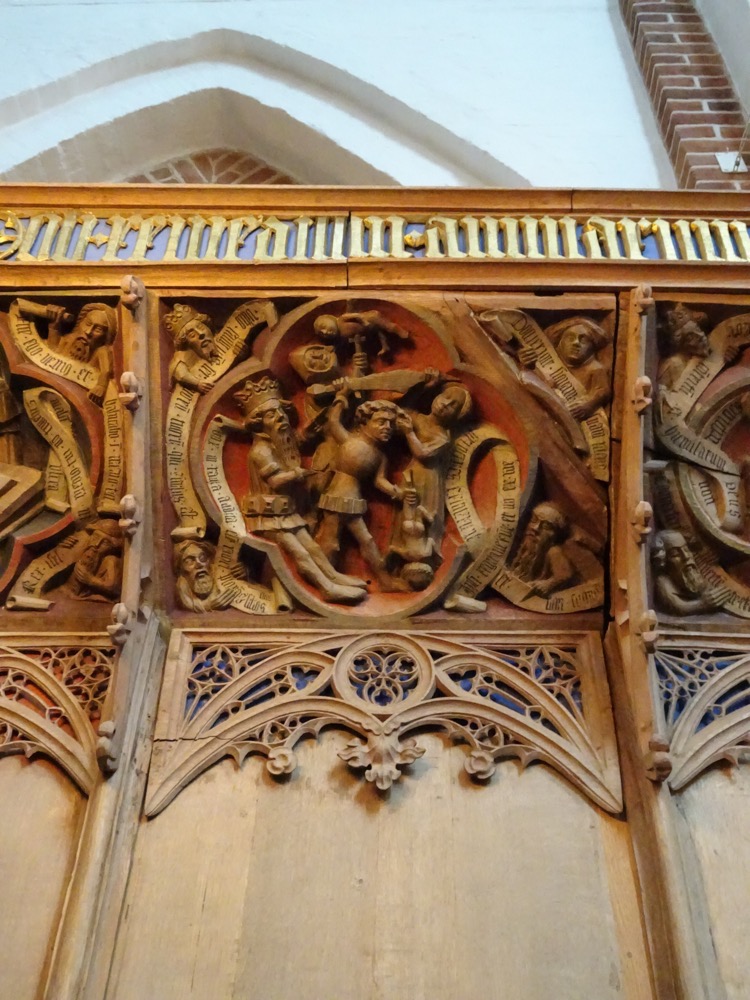 The magnificent altarpiece, c.1555 AD, was a gift from Christian IV of Denmark.
The magnificent altarpiece, c.1555 AD, was a gift from Christian IV of Denmark.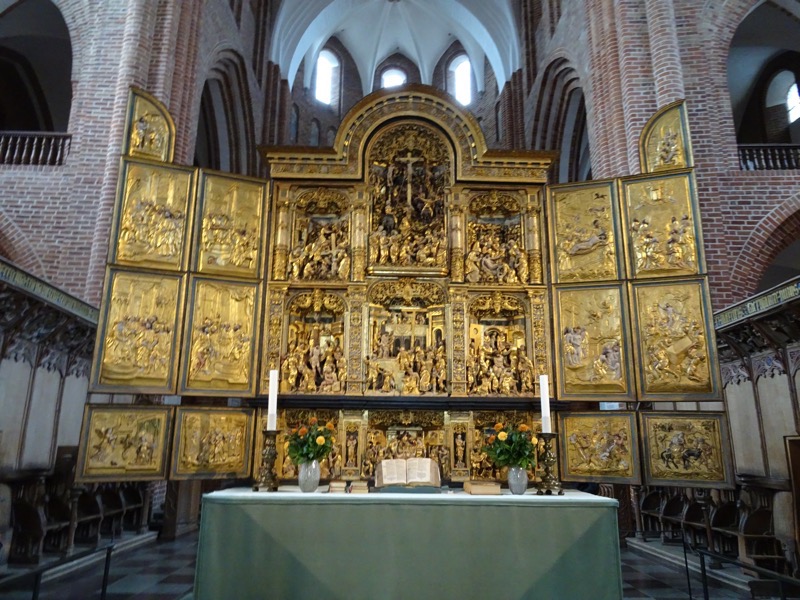
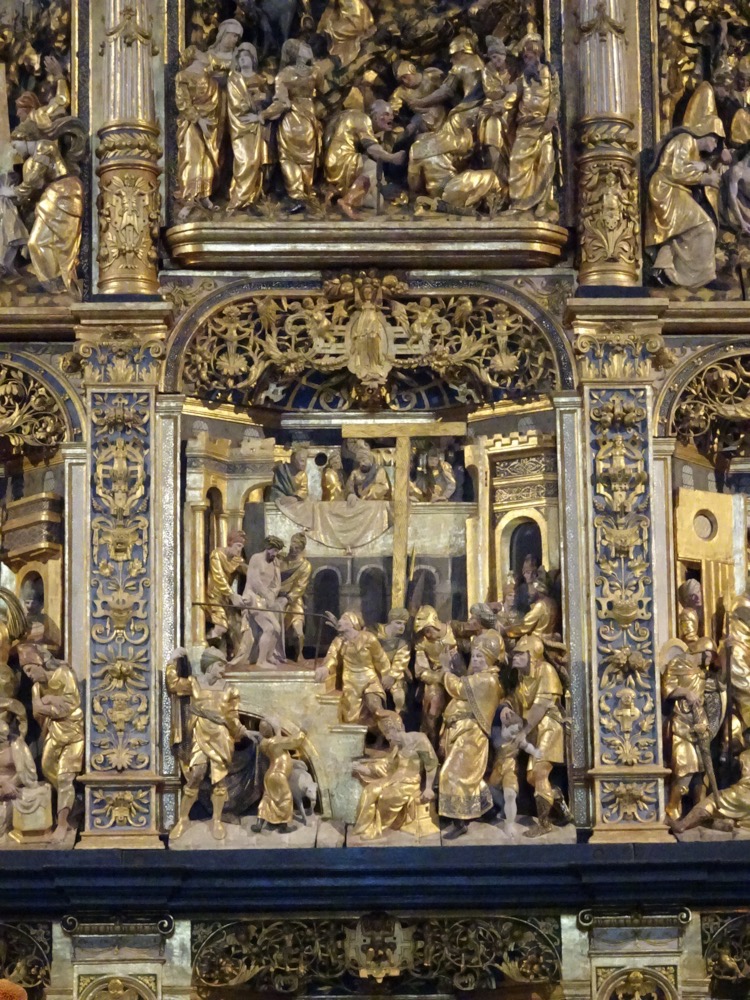 The cathedral has been the primary burial site for Danish monarchs since the 15th century – to accommodate an increasing number of royals over the centuries, it has been extended and altered to contain a considerable number of burial chapels.
The cathedral has been the primary burial site for Danish monarchs since the 15th century – to accommodate an increasing number of royals over the centuries, it has been extended and altered to contain a considerable number of burial chapels.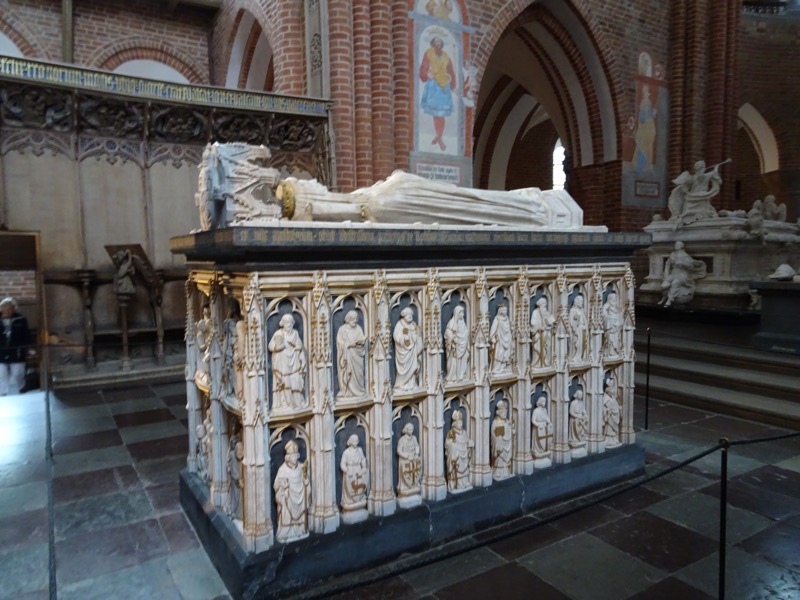 Burial tomb of Margarethe I of Denmark.
Burial tomb of Margarethe I of Denmark.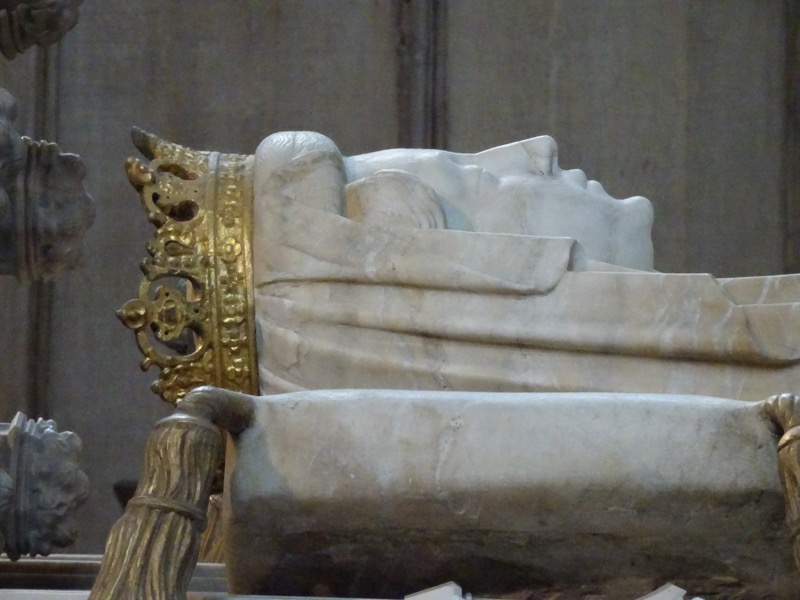
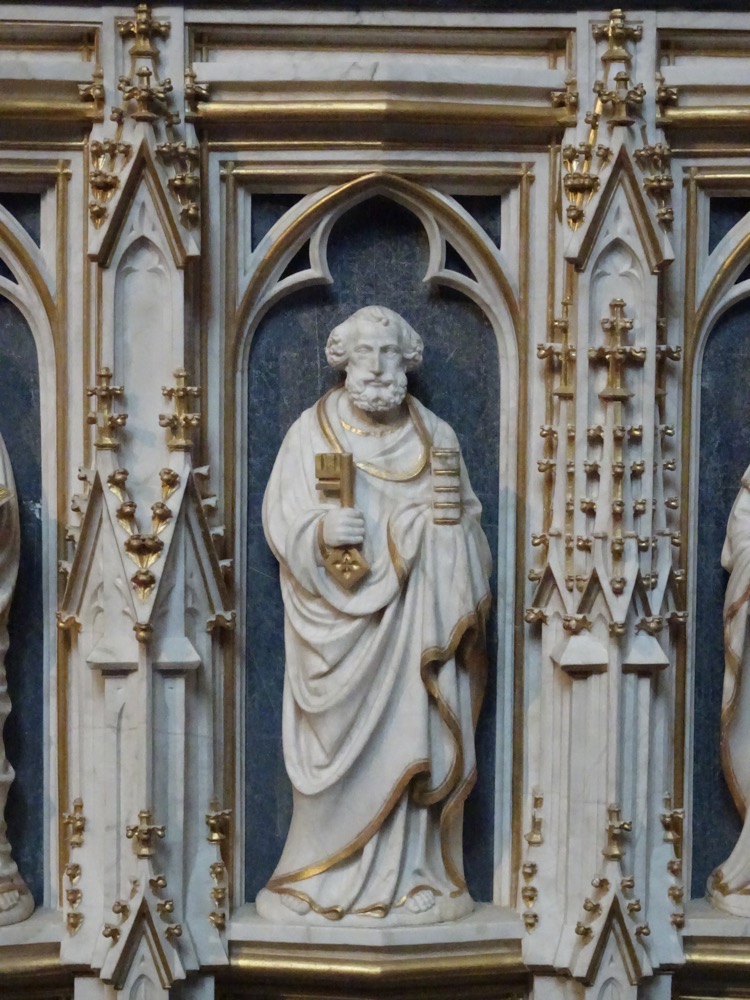
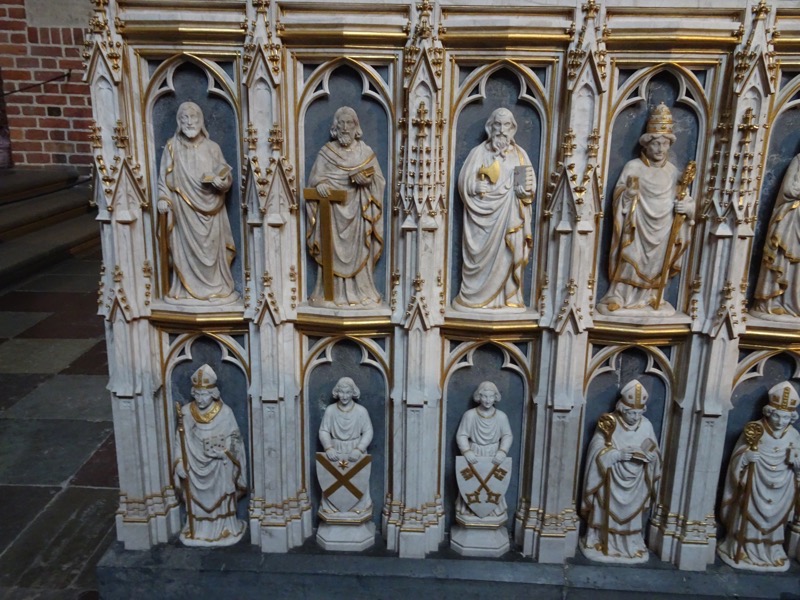
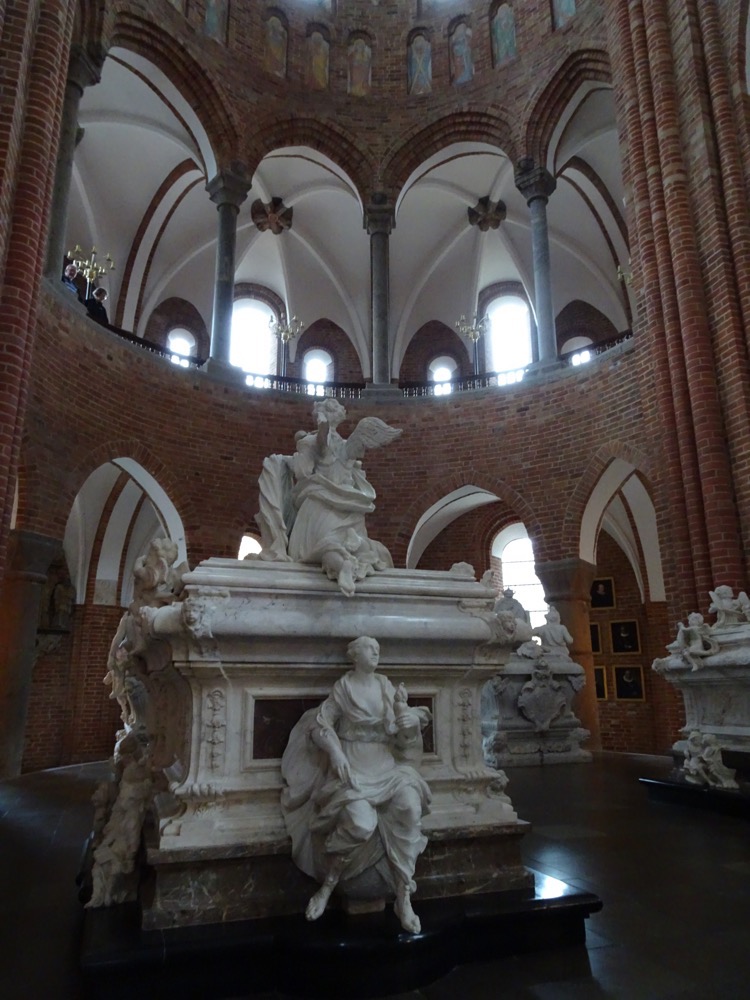
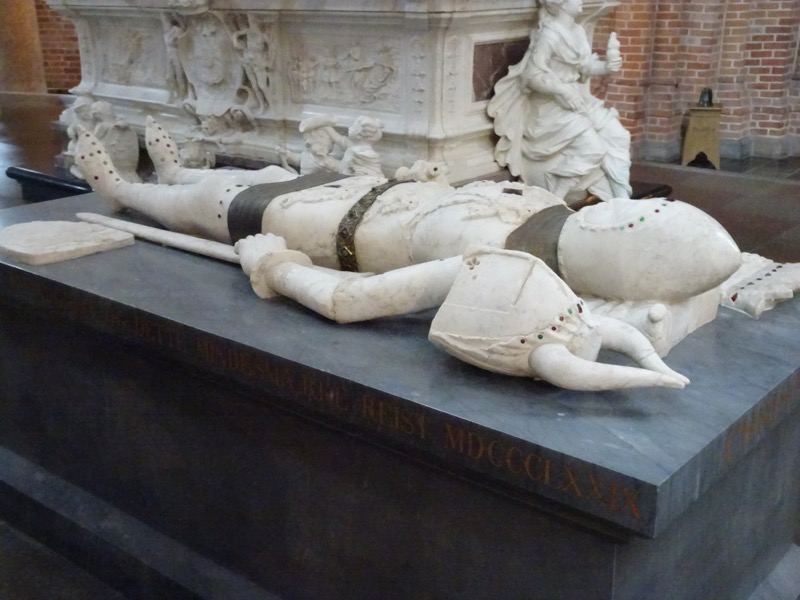
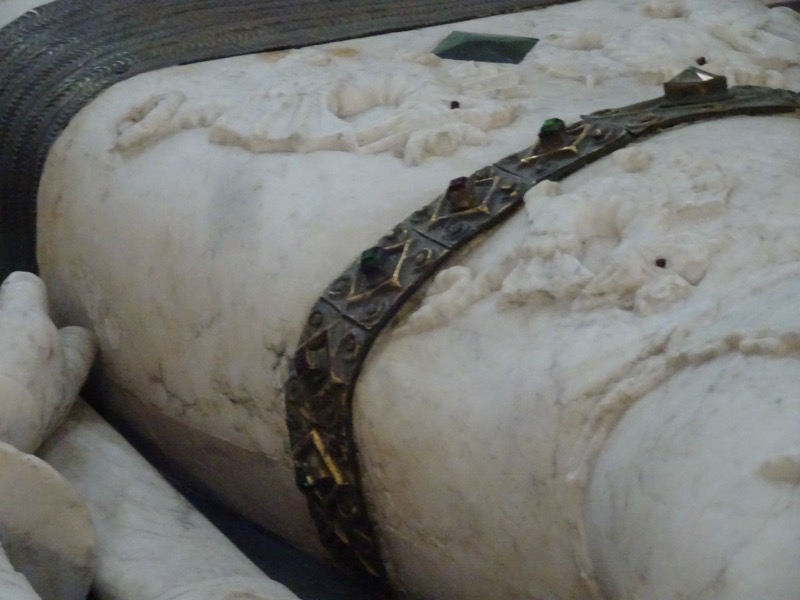
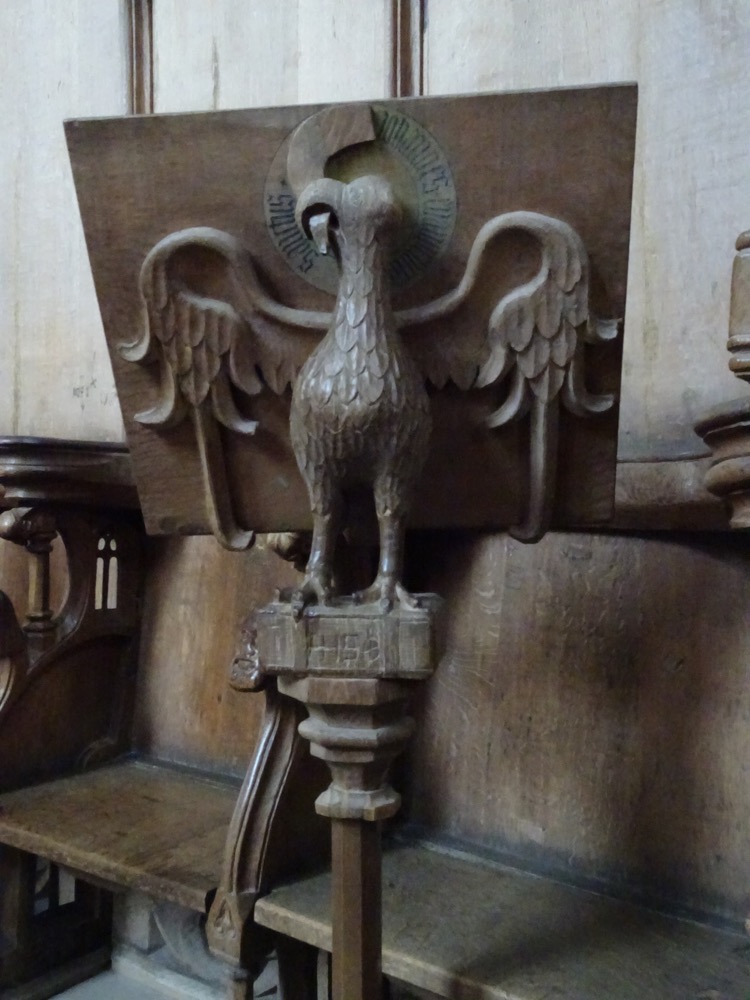
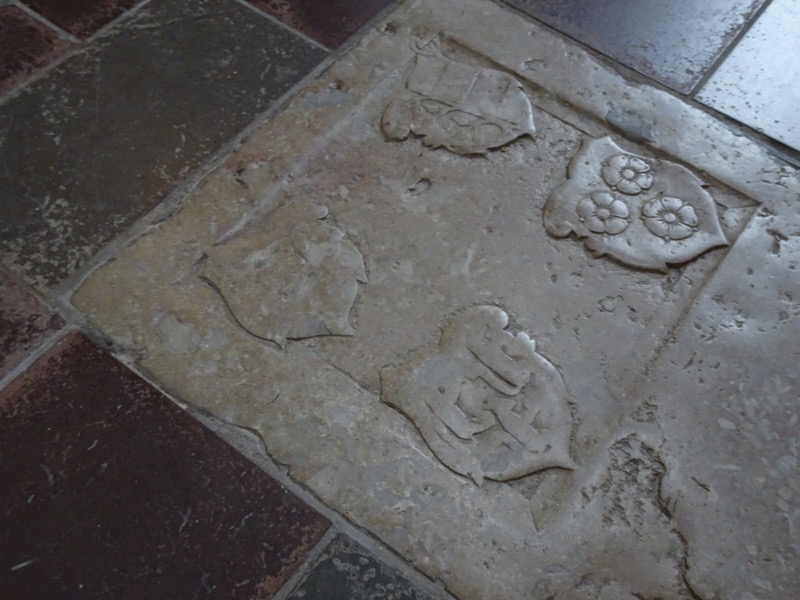
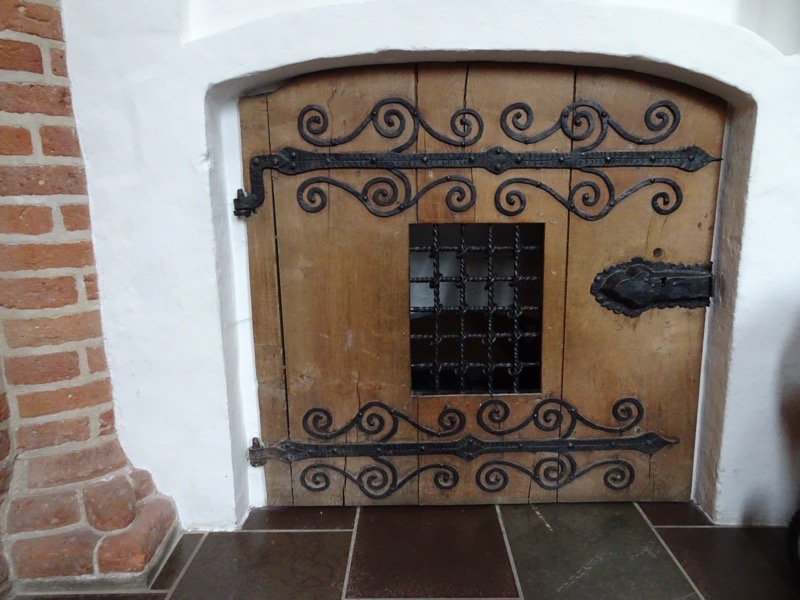 The crypt directly under the altar.
The crypt directly under the altar.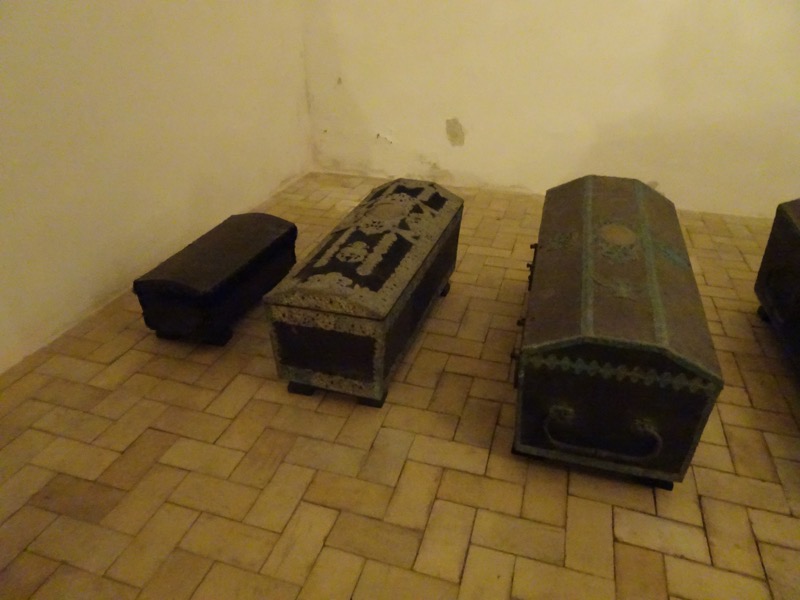
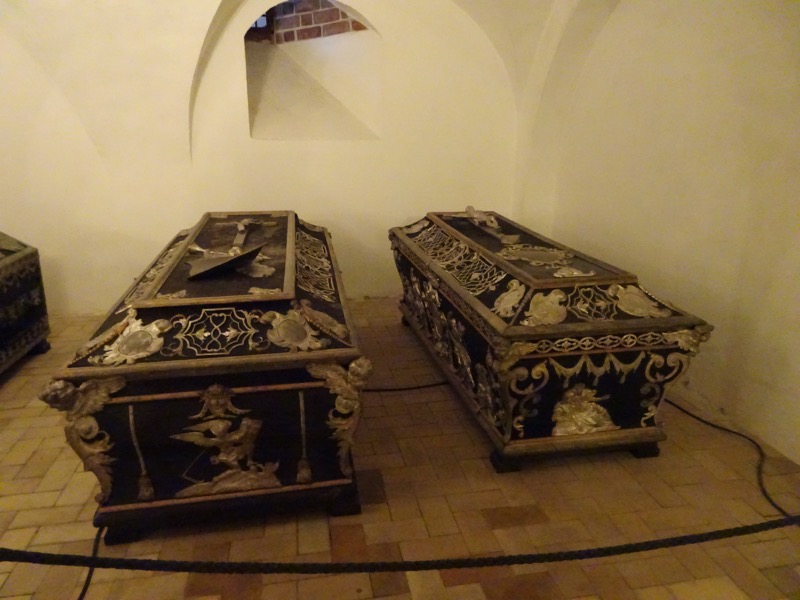
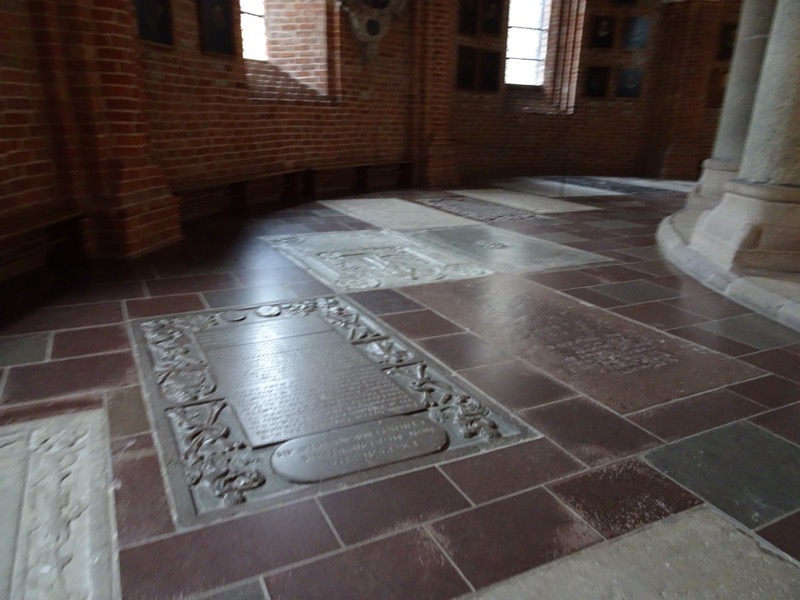
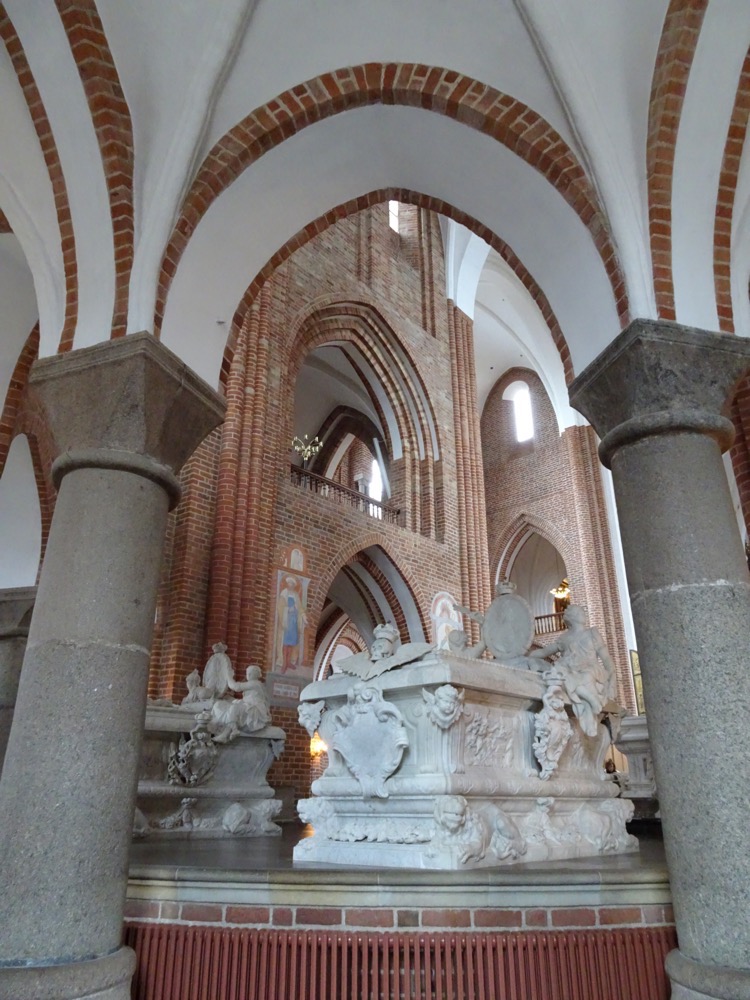
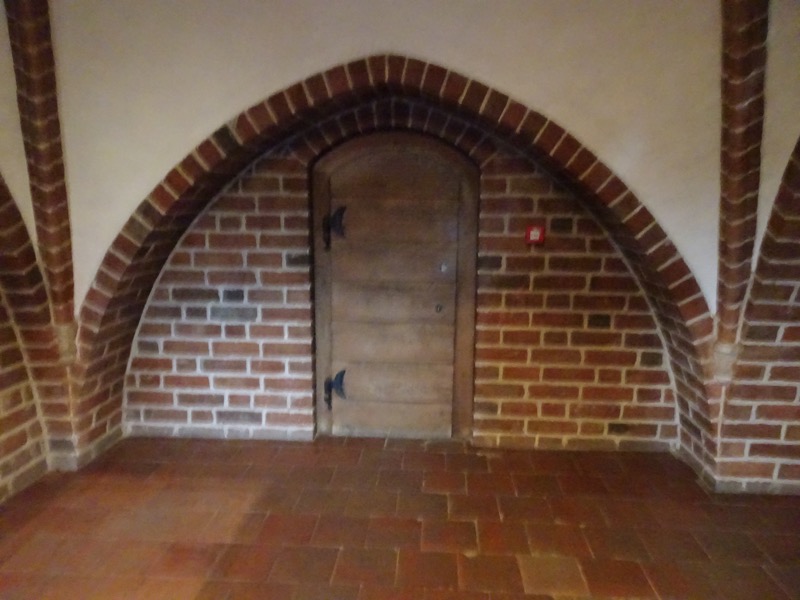 Looking down on the crypts behind the altar from the choir balconies.
Looking down on the crypts behind the altar from the choir balconies.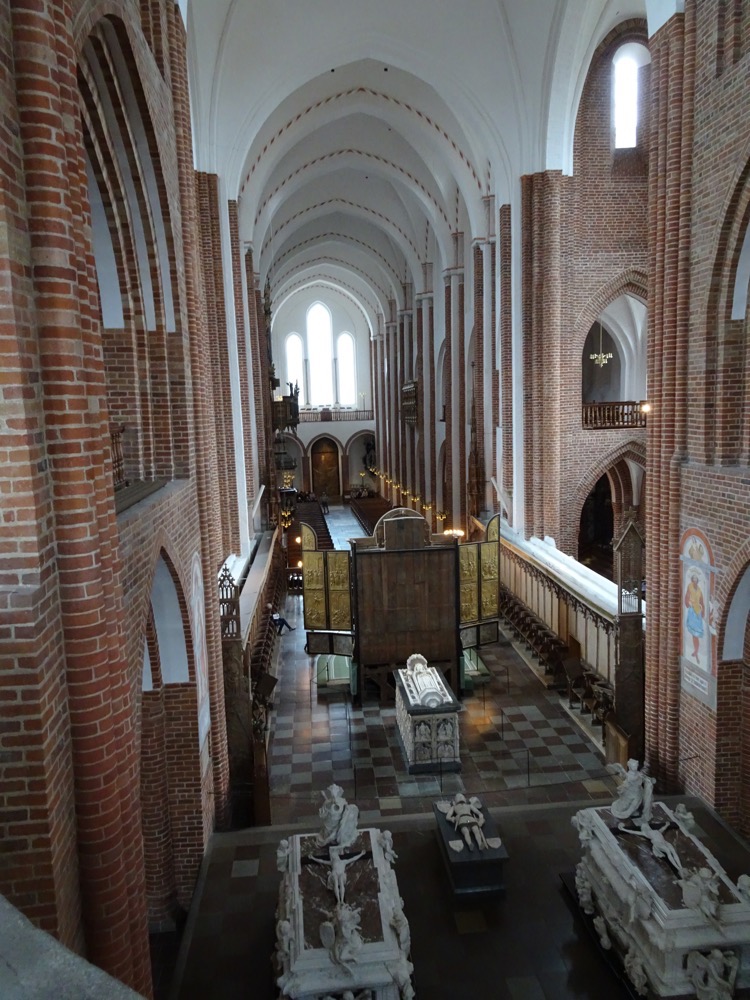
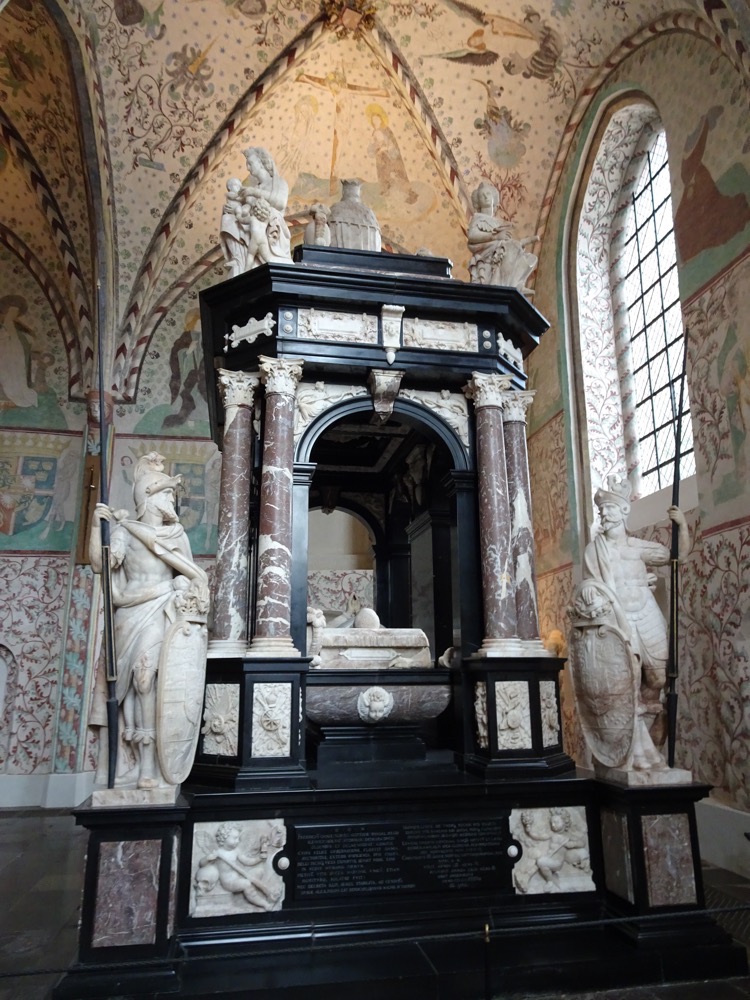 Monument of Frederick II, in the Chapel of the Magi.
Monument of Frederick II, in the Chapel of the Magi.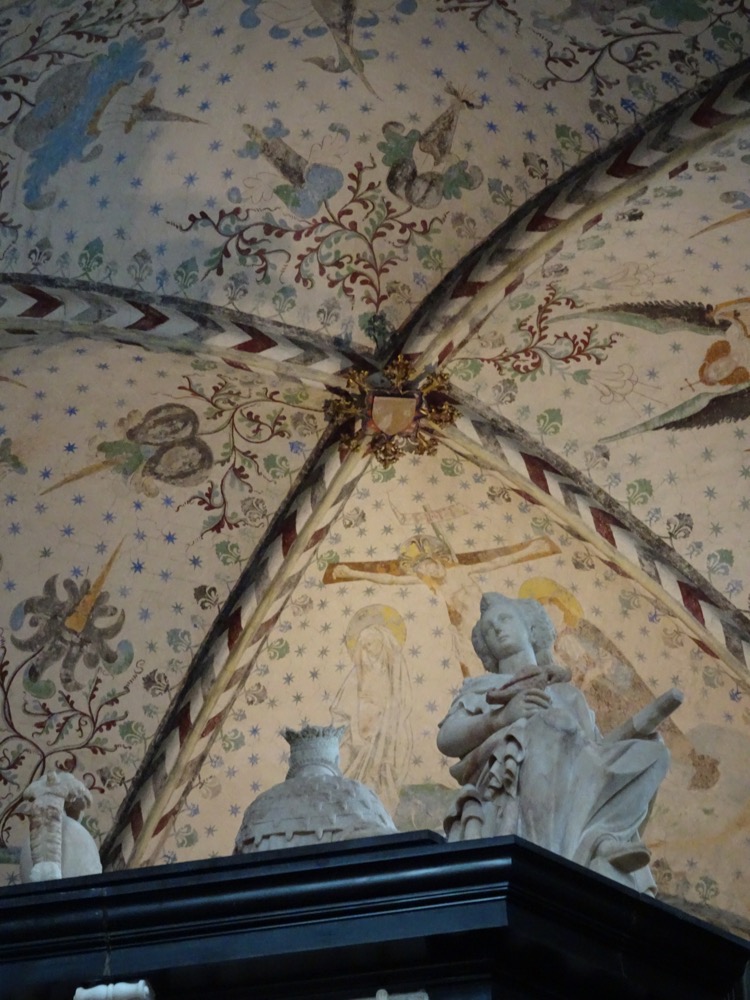
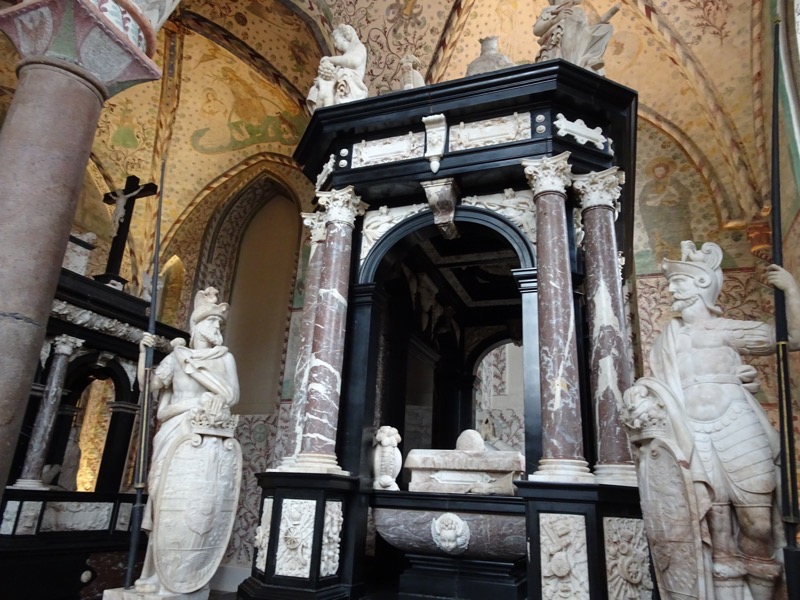
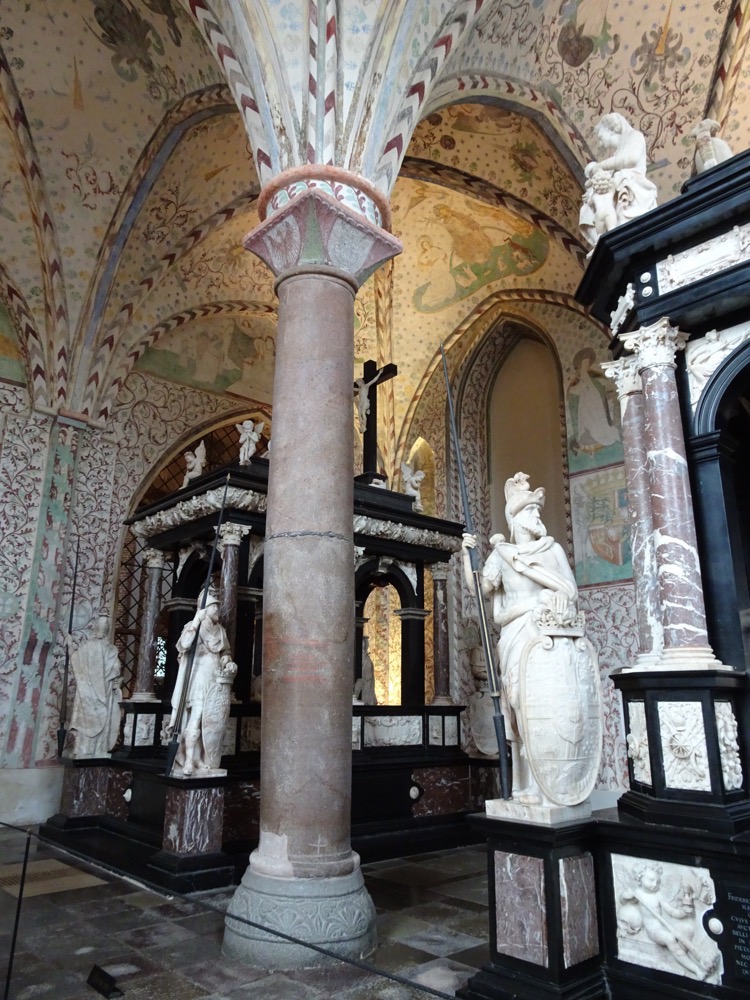
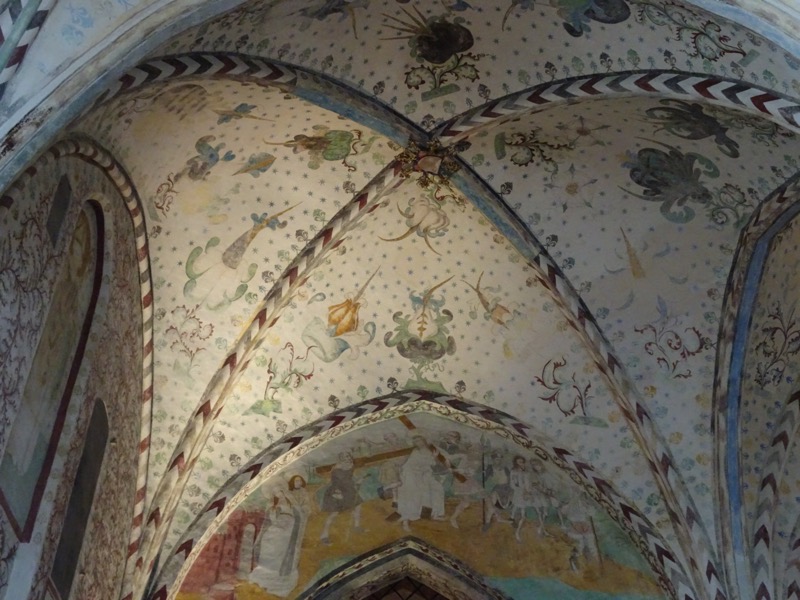 Amusing tourist bus directly outside the cathedral!
Amusing tourist bus directly outside the cathedral!
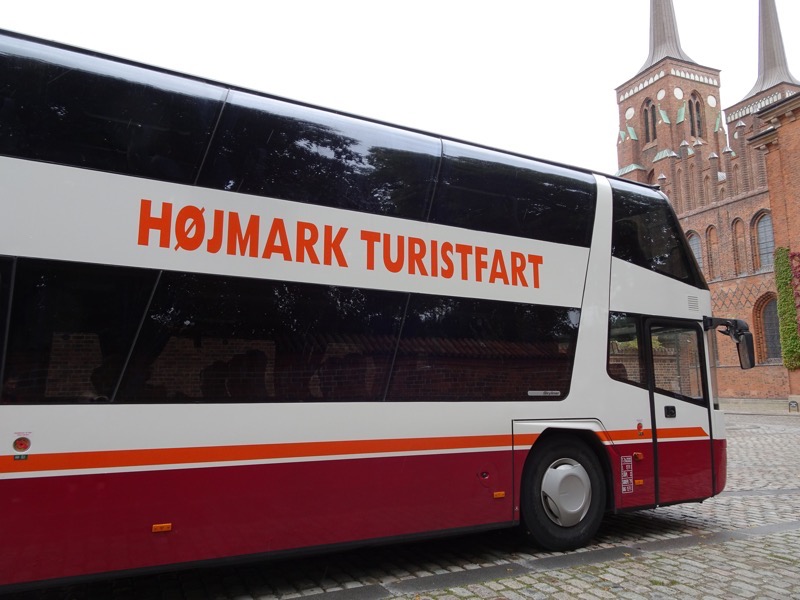 Roskilde pedestrian shopping street – it’s a lovely quiet part of the city. Roskilde Cathedral attracts barely 125,000 visitors each year and as such there is relatively little tourism hustle and bustle here, which makes a nice change from the Copenhagen CBD.
Roskilde pedestrian shopping street – it’s a lovely quiet part of the city. Roskilde Cathedral attracts barely 125,000 visitors each year and as such there is relatively little tourism hustle and bustle here, which makes a nice change from the Copenhagen CBD.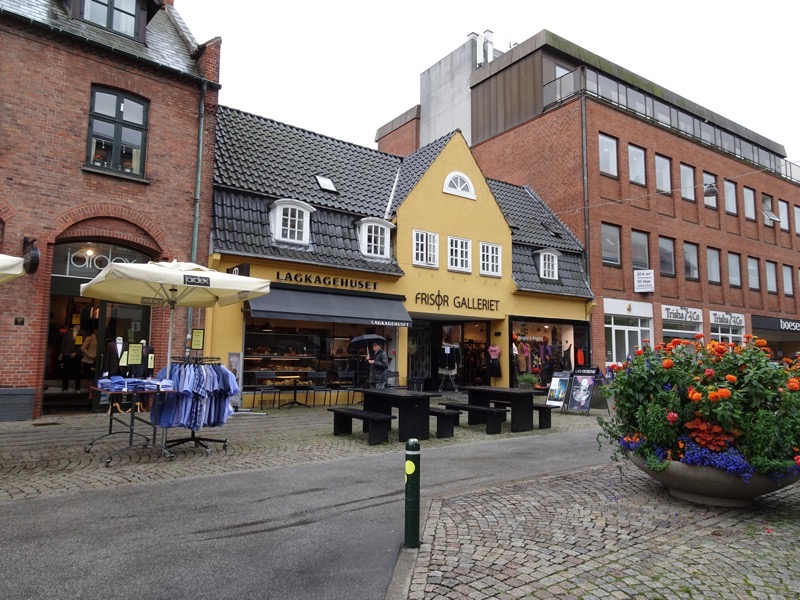 Interesting juxtaposition of street art and period building techniques.
Interesting juxtaposition of street art and period building techniques.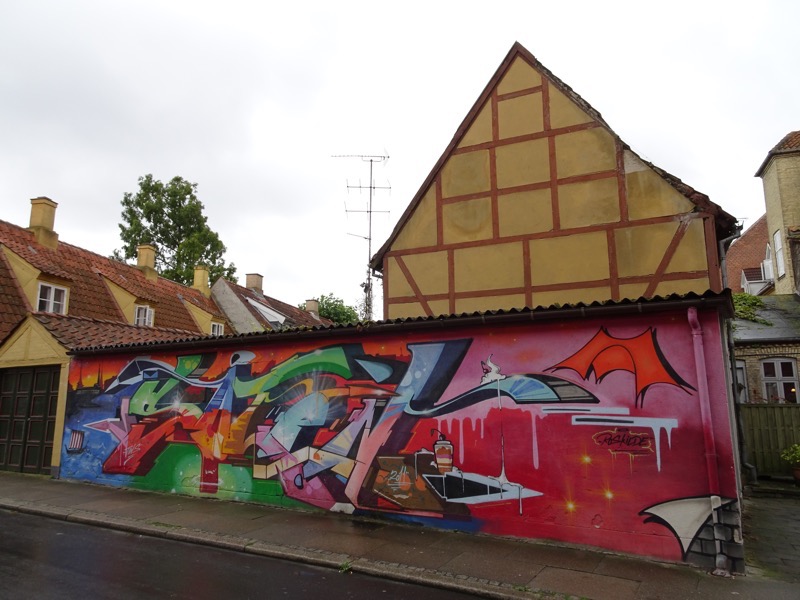 After Roskilde, we head back to Copenhagen to rest our feets before finding somewhere funky and local to have dinner… Sadly, in our quest to avoid another Irish pub, (this area is just littered with them) we ended up at a Hard Rock Cafe ! 😛
After Roskilde, we head back to Copenhagen to rest our feets before finding somewhere funky and local to have dinner… Sadly, in our quest to avoid another Irish pub, (this area is just littered with them) we ended up at a Hard Rock Cafe ! 😛
